

NEW ZEALAND’S INDEPENDENT VOICE FOR NATURE • EST. 1923 SPECIAL ISSUE Centennial TE REO O TE TAIAO ForestBird and № 387 AUTUMN 2023
COVER
PAPER ENVELOPE
EDITOR Caroline Wood E editor@forestandbird.org.nz
ART DIRECTOR/DESIGNER Rob Di Leva, Dileva Design E rob@dileva.co.nz
PRINTING Webstar www.webstar.co.nz PROOFREADER David Cauchi
ADVERTISING ENQUIRIES Karen Condon T 0275 420 338 E karen.condon@xtra.co.nz

MEMBERSHIP & CIRCULATION T 0800 200 064 E membership@forestandbird.org.nz
Thank you for supporting us! Forest & Bird is New Zealand’s largest and oldest independent conservation charity.
Join today at www.forestandbird.org.nz/joinus or email membership@forestandbird.org.nz or call 0800 200 064

We hope you enjoy this bumper 100th birthday issue with eight extra pages of centennial storytelling. Every member receives four copies of Forest & Bird magazine a year.

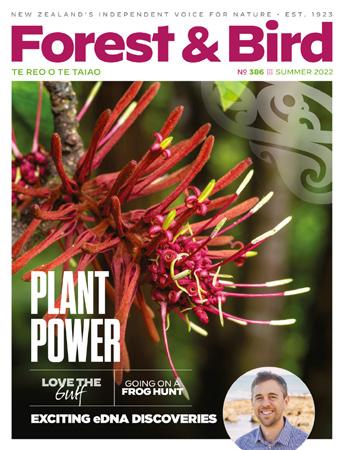
Forest & Bird is printed on elemental chlorine-free paper made from FSC® certified wood fibre and pulp from responsible sources.
SHOT Kākā Lily Daff circa 1931. Forest & Bird archives/Alexander Turnbull Library
Pīwauwau rock wren. Jeremy Sanson RENEWAL Pepe para riki common copper butterfly. Donald Laing
Forest & Bird is published quarterly by the Royal Forest and Bird Protection Society of New Zealand Inc. Registered at PO Headquarters, Wellington, as a magazine. ISSN 0015-7384 (Print), ISSN 2624-1307 (Online). Copyright: All rights reserved. Opinions expressed by contributors in the magazine are not necessarily those of Forest & Bird. Contents ISSUE 387 • Autumn 2023 Editorial 2 Celebrating our first century 4 Letters + competition winners News 6 Big Birthday Bash and other centennial events 8 Twin causes for celebration 10 Bat boost, Vote Nature 2023 12 Biodiversity project, lifelong legacy, New Caledonia calling, fundraising heroes Cover 14 Back in black 17 Hope in action Freshwater 20 Bring back wetlands 27 Restoring the Ngaruroro Special report 22 Our remarkable southern kaurilands Predator-free NZ 28 Give a Trap! 48 Let’s not forget mice Centennial stories 30 Green shoots 33 Cherish our heritage 45 Perrine Moncrieff’s play Focus on flora 36 Back from the brink Forestry 38 Stop forestry slash Branch project 40 Shorebird sanctuary 52 Plague skinks Opinion 41 Right to repair 64 The degrowth revolution 14 30
Marine
42 Sponges – seashore treasures
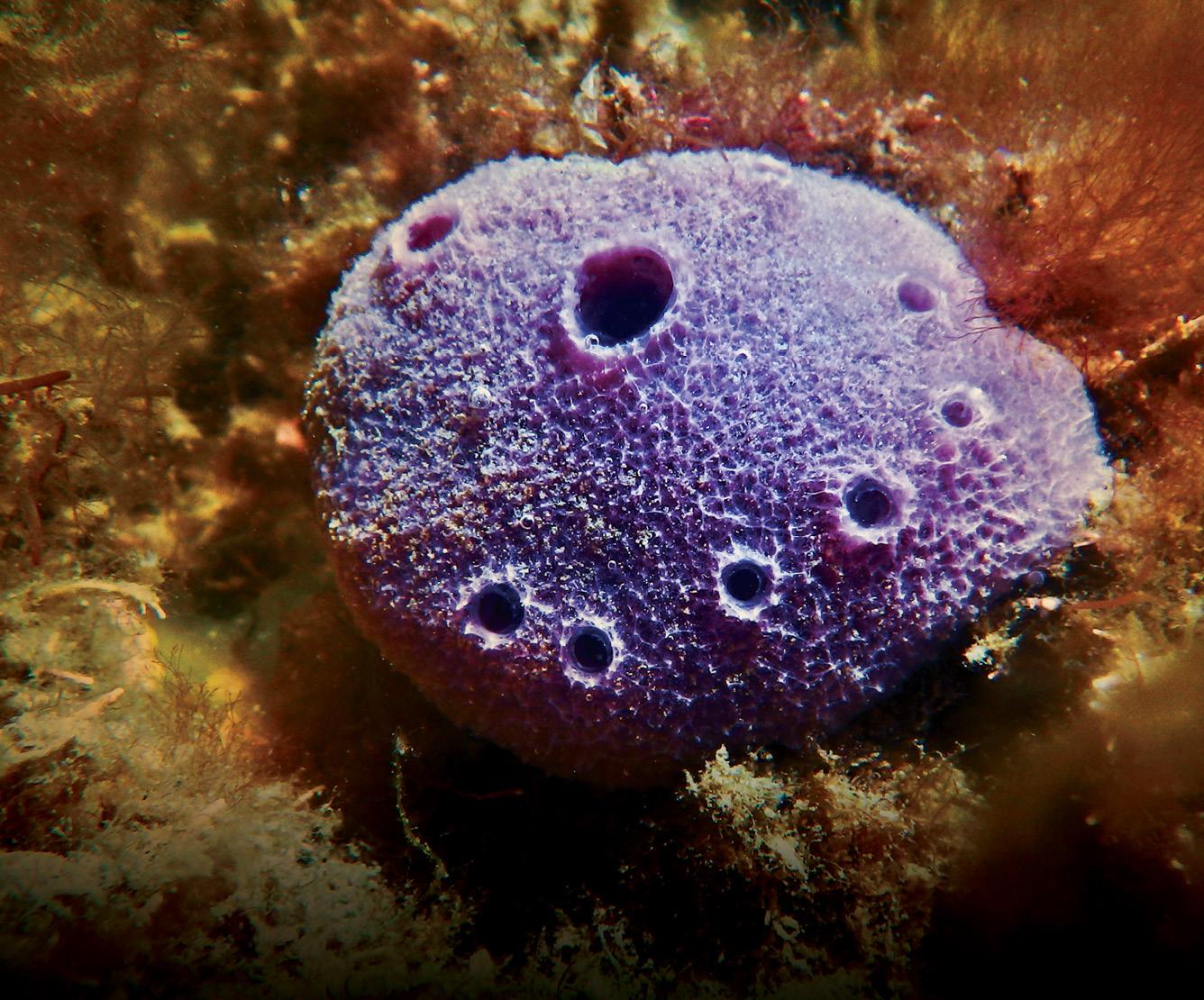
50 New Zealand sea lions
Biodiversity
44 Restoring Rotoiti reserves
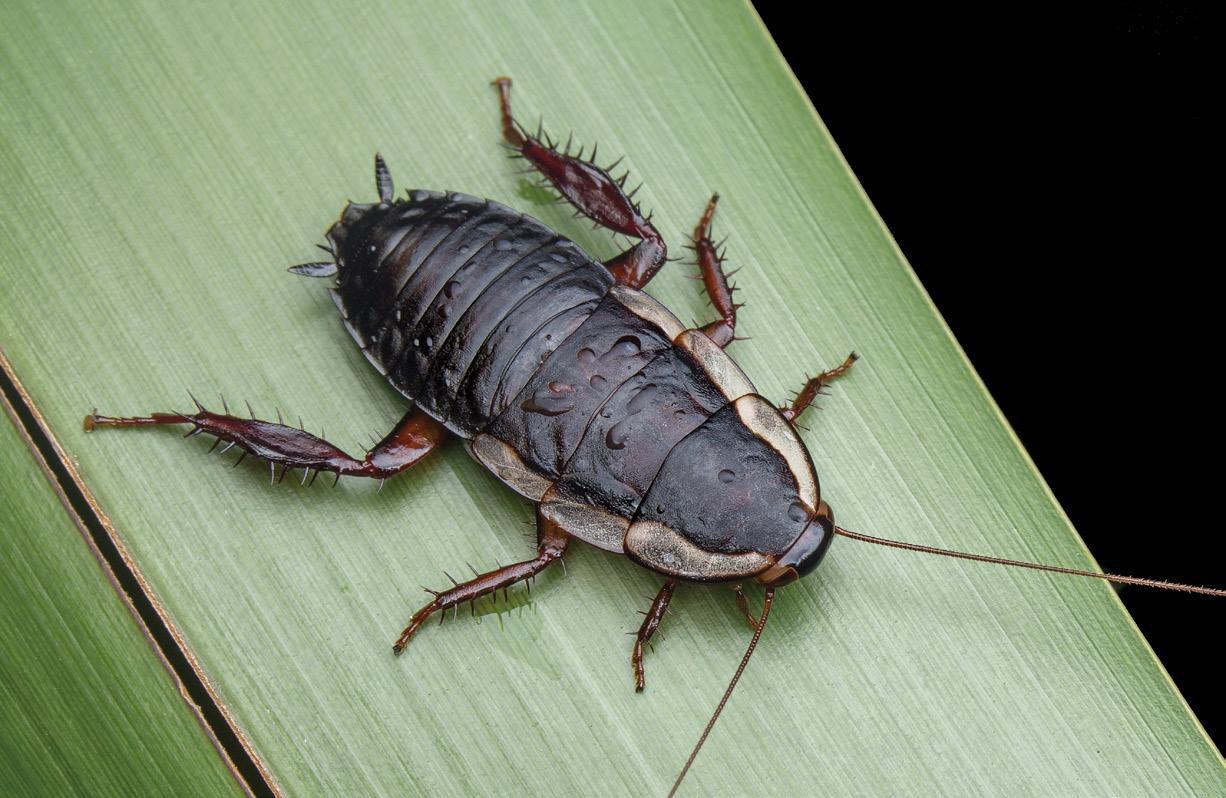
46 Falcon family
58 Radical connections
International
50 Time to protect 30%
Birdlife
51 Spotted shags, masters of air, land & sea
CONTACT NATIONAL OFFICE
Forest & Bird National Office
Ground Floor, 205 Victoria Street
Wellington 6011
PO Box 631, Wellington 6140
T 0800 200 064 or 04 385 7374

E office@forestandbird.org.nz
W www.forestandbird.org.nz
CONTACT A BRANCH
See www.forestandbird.org.nz/ branches for a full list of our 50 Forest & Bird branches.
www.facebook.com/ ForestandBird
@forestandbird
@Forest_and_Bird

www.youtube.com/ forestandbird
Royal Forest and Bird Protection Society of New Zealand Inc. Forest & Bird is a registered charitable entity under the Charities Act 2005. Registration No CC26943.
PATRON Her Excellency The Rt Honourable Dame Cindy Kiro, GNZM, QSO Governor-General of New Zealand
CHIEF EXECUTIVE Nicola Toki PRESIDENT Mark Hanger TREASURER Alan Chow BOARD MEMBERS Chris Barker, Kaya Freeman, Kate Graeme, Richard Hursthouse, Ben Kepes, Ines Stäger CONSERVATION AMBASSADORS Sir Alan Mark, Gerry McSweeney, Craig Potton DISTINGUISHED LIFE MEMBERS Graham Bellamy, Ken Catt, Linda Conning, Philip Hart, Joan Leckie, Hon. Sandra Lee-Vercoe, Carole Long, Peter Maddison, Sir Alan Mark, Gerry McSweeney, Craig Potton, Fraser Ross, Eugenie Sage, Guy Salmon, Lesley Shand
the field
Native cockroaches Our partners 62 Investing in a better planet Forest & Bird project 63 Lenz Reserve: Summer in the Catlins Going places 66 A grand Fiordland tour Obituary 68 Audrey Eagle Books
Autumn book round up Market place
Classifieds
word
Kiwi rescue
shot
Poaka
stilt 42 54
In
54
69
70
Last
72
Parting
IBC
pied
CELEBRATING OUR FIRST CENTURY
Forest & Bird turns 100 later this month, and I’m looking forward to acknowledging the thousands of New Zealanders who have helped achieve so much for nature over the past century.


Without you – and the five generations of donors, volunteers, and staff standing behind you – we wouldn’t be where we are now, a powerful and effective conservation voice.
Since 28 March 1923, we have been working together to advocate strongly for the protection, restoration, and enhancement of Aotearoa New Zealand’s natural heritage.
Earlier this year, I travelled around the country with a tour group from the UK. It was humbling to show them project after project that Forest & Bird has initiated, enabled, or grown in every corner of the motu.
The list included conservation projects at Boyle River, central Canterbury, the Makarora Valley, Otago, Ark in
the Park, Tāmaki Makaurau, the Lake Hatuma Bittern project, Hawke’s Bay, and the Violet Bonnington Reserve, Rotorua.
Many of our projects and reserves have existed for decades. All demonstrate Forest & Bird “walking the talk” – showing how it’s possible to protect and restore nature in our own backyards.
These at-place projects show how our volunteers can make a tangible difference for local flora and fauna – by trapping, planting, and weeding.
The dedicated volunteers who led the society in its early years were able to adapt with the times and change direction when needed to maximise their effectiveness.
This is just as important today. It’s vital to keep the end goal in mind, whether it’s of a practical project or a national environmental campaign. This may mean rapidly changing direction in the light of new challenges or technologies.
I know from personal experience how easy it is to become immersed in a project and keep on doing the mahi without pausing to step back every so often to evaluate progress.
The numbers of predators or pest plants removed are measures of hard work. They are not proof that objectives are being achieved.
Instead let’s measure positive outcomes – the breeding success of birds, the density of rare lizards, the diversity of tree seedlings, floral abundance in the canopy, or bat sightings per unit of time.
Measures like these can help us evaluate just how valuable our voluntary conservation work is for Aotearoa.
I’m looking forward to coming together in the coming year to celebrate our collective wins, pay tribute to Forest & Bird’s donors and volunteers, and ensure our conservation mahi is fit for purpose for the years ahead.
I hope you enjoy this bumper centennial magazine. Whāia te iti kahurangi, ki te tuohu koe, me he maunga teitei – seek the treasure that you value most dearly, if you bow your head, let it be to a lofty mountain.

EDITORIAL
Ngā manaakitanga
Mark Hanger
Forest & Bird President Perehitini, Te Reo o te Taiao
| Forest & Bird Te Reo o te Taiao 2
Red and yellow crowned kākāriki. Lily Daff for Forest & Bird, circa 1933
WILDERNESS
JOIN NEW ZEALAND’S EXPEDITION CRUISE PIONEERS EXPLORING THE FURTHEST REACHES OF OUR BACKYARD ON A BUCKET LIST ADVENTURE


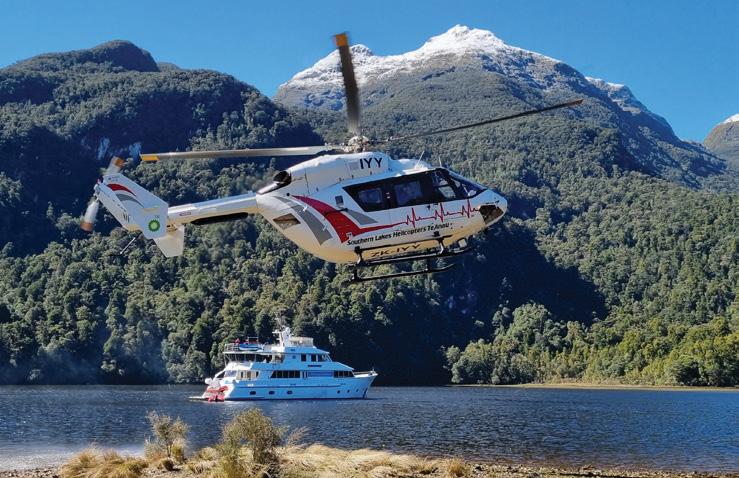

Heritage Expeditions are pioneers in environmentally-responsible small ship expedition cruising and industry leaders in sharing stunning natural wonders, incredible cultural exchanges, unforgettable wildlife encounters and wilderness adventures, and exploring historic sites with intrepid travellers. Travel is aboard our purpose-built, luxurious 140-guest expedition flagship Heritage Adventurer and 18-guest expedition yacht Heritage Explorer where guests enjoy sophisticated accommodation, gourmet fare and carefully crafted, unique itineraries led by a renowned team of botanists, ornithologists, naturalists, geologists, historians and experts.
• Snares Crested Penguins, Snipe & Flightless Teal
• Flowering fields of megaherbs
• Sea Lions, Albatross & Coastwatchers history
• Includes excursions & house drinks with lunch & dinner
8 days, 20 Dec 2023
$9,275pp*
• Ports Adventure & Pegasus
• New Zealand’s Amazon Lords River & Paterson Inlet
• Predator-free Ulva Island
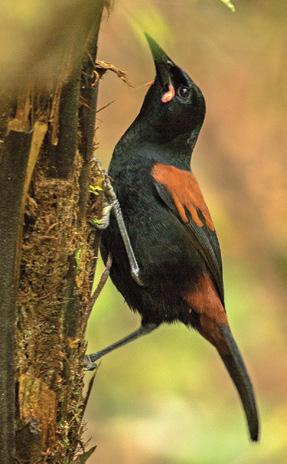

• Quirky town centre Oban
• Pearl, Anchorage & Noble Islands
• Granite Domes & Tin Range

• Includes excursions & house drinks
8 days, 10 May, 26 Oct & 2 Nov 2023
• Milford, Charles, Caswell, Breaksea, George, Doubtful and Dusky Sounds
• Alice Falls, Acheron Passage, Chalky and Preservation Inlets
• Includes excursions & house drinks
10 days, 20 & 30 May, 10 & 20 Jul, 14 & 24 Sep &
3 Oct 2023 $9,495pp**
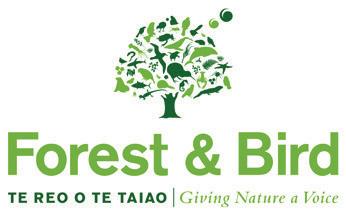
See our website for more incredible Kiwi adventures! WWW.HERITAGE–EXPEDITIONS.COM
Freephone 0800 262 8873 info@heritage-expeditions.com
© M.
FORGOTTEN ISLANDS ALL OF THE FIORDS
Potter
©
UNSEEN STEWART ISLAND Based on Deck 4 Superior twin share aboard Heritage Adventurer, based on Salvin’s twin share aboard Heritage Explorer.
AWE-INSPIRING
ADVENTURES © L.Thorpe
T.Kraakman
Auckland
Te
$7,195pp** © L.Wilson Queenstown
Anau
LETTERS
YOUR FEEDBACK
Forest & Bird welcomes your thoughts on conservation topics. Please email letters up to 200 words, with your name, home address, and phone number, to editor@forestandbird.org.nz, or by post to the Editor, Forest & Bird magazine, 205 Victoria Street, Wellington 6011, by 1 May 2023. We don’t always have space to publish all letters or use them in full. Opinions expressed on the Letters page are not necessarily those of Forest & Bird.
ROCKIN’ WRENS
A while ago I was reading a book on New Zealand birds, and the section on the rock wren caught my attention – it struck me as such a modest, plucky little bird. As I had grown up in the Mackenzie Country, its habitat appealed. I was delighted at the rock wren’s choice as Bird of the Year 2022 and wrote a couple of poems in celebration. The first a light-hearted piece, the second a representation of the eternal, seasonal patterns of life of high country birds alluding to the threat of introduced predators.
Joanna Fahey, Auckland
You can read Joanna’s ode to hurupounamu On the Rocks right.
MORE GIANTS
BEST LETTER WINNER
There are a couple of giant old rātā right on the Heaphy Track, a few hundred metres downstream of the Heaphy River and Lewis River confluence. They’re well known to DOC and the thousands of people who’ve passed by, pics are easy to find via Google. After reading Giant Discovery (Summer 2022 issue), I checked out the New Zealand Tree Register that was mentioned in the article. I guess that has limited reach as not only are the Heaphy trees not listed but there are no trees at all from northern Westland. The Heaphy rātā are giants too and of course there could be many more away from any tracks. One looks to me to have a 3m+ but maybe not 4m trunk like your Tautuku tree. The other tree leans over and there are no angles to get a good pic of it, but from memory it looks quite a bit bigger and older. It looks similar to your pics of the Tautuku tree.
Tony Ward-Holmes
CAT CONTROL
I’ve read the Time to Talk about Cats article last year and would be very grateful if Forest & Bird would lobby for a Cat Control Act. We have so many cats in our street (suburban Auckland), many not collared, all of them wandering and hunting, that it’s a wonder any birds survive. Our own cat, now dead, and collared
WRITE AND WIN
The best contribution to the Letters page will receive a copy of Ahuahu: A conservation journey in Aotearoa New Zealand by David Towns (Canterbury University Press, RRP $79.99)

when alive, wiped out the copper skinks we had on our property. I was regularly finding them belly up with puncture wounds on their abdomens. The neighbour’s cat frequently killed birds including a tūī and several tauhou silvereyes.
Mike Lloyd, Auckland
FIT FOR FELINES
My cousin keeps her cats contained in the cat garden she built at her home. She also puts them on a harness and takes them for walks. There is no reason to ever let cats roam. She also built a cabin for them to go into in wet weather, joined by a tunnel to the house, to give them a choice. It would be a great business for people to build purpose-built cat gardens.
Gillian Pollock, Nelson-Tasman
EDUCATE DOG OWNERS
As a part time resident of Takapuna, I read with sympathy the letter about dogs on Cheltenham Beach (Summer 2022). Takapuna is a “dead” beach with no wildlife other than the odd fish-and-chip-seeking seagull. It is Queen Street for dogs and the numbers seemed to increase markedly over Covid. No bird would risk trying to breed there – it would be certain death. Sad to hear Cheltenham is heading the same way. I have to accept that Takapuna is beyond repair, but why is there no concern, campaign or education about the damage off-leash dogs can do to wildlife. Dog owners always think their lovely dog would never do any damage. We all like to think that but it is not true. Perhaps people should purchase their dogs with more realistic wildlife friendly/outdoor access expectations from the start. Could the SPCA, dog breeders, vets etc help inform prospective dog owners of their responsibility to the wider environment? Then it won’t be a surprise to them that National Parks and some beaches are out of bounds. Seems obvious that we start at the start and educate rather than, much too late, mitigate.
Karen Grimwade, Auckland
| Forest & Bird Te Reo o te Taiao 4
FUNDING DOC
I’m an ex-farmer and a commercial builder/investor with strong environmental beliefs. Currently in retirement, we have 117 acres that had nearly every invasive weed known and every introduced pest when we bought it 10 years ago. While we continue to have incursion of invasive plants and animals, the property is fundamentally pest-free. If there was something profitable to mine on the property, I would open a mine. There would be a financial reserve kept to reinstate the mine at the end of its life. All profits would be spent on conservation efforts. To my mind, the Department of Conservation should not be funded by the taxpayer (who are terribly overtaxed) but should fund themselves through tourism, having areas of sustainable milling of native trees, mining, and facility leases. I’m sure purists will be weeping blood and gnashing their teeth from my comments, but I say those people are so heavenly minded they are of no earthly use. Profits on conservation land could be huge, that could in turn fund huge conservation efforts. I’m embarrassed as a Kiwi when I see weed and pests on conservation land during my tramping and mountain climbing trips.
Peter Jackson, Franklin
ON THE ROCKS
BY JOANNA FAHEY
Our name is hurupounamu, feathers like greenstone. Which is nice.
Some people call us rock wren –wrong on the wren part, but right on the rock. We’re actually unique. We live in high places: mountains, snow, grass, rocks. Keep to ourselves. We don’t fly much (not much in the way of tail feathers – and it’s dangerous out there) but we flit and bop and hop on grass and rocks –rock, bop, rocketty, rocketty, rock, bop, bop. And if you want to know –our secret name is Xenicus Gilviventris. Which is pretty cool for a very small bird. We rock.

BOOK GIVEAWAY
We are giving away two copies of Soundings, diving for stories in the beckoning sea by Kennedy Warne (Massey University Press RRP $39.99). Warne draws on more than 20 years of fieldwork for National Geographic to share stories about our relationship with the world’s oceans.
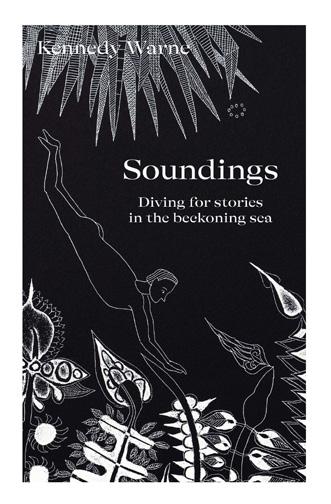
To enter, email your entry to draw@forestandbird.org.nz, put SOUNDINGS in the subject line, and include your name and address in the email. Or write your name and address on the back of an envelope and post to SOUNDINGS draw, Forest & Bird, PO Box 631, Wellington 6140. Entries close 1 May 2023.
The winner of our Bumper Book prize pack of 10 new titles published by Potton & Burton was Sue Martin, of Mt Maunganui. The winners of Raising our Chicks by Cushla Thomson McCaughey were Alexander Murphy, of Auckland, and Ross Wilkes, of Wellington.
5 Autumn 2023 |
Rock wren hurupounamu. Jeremy Sanson
BIG BASH Birthday
Forest & Bird is launching its centennial celebrations with three birthday parties across Aotearoa over the weekend of 25–26 March –we can’t wait to see you there!
The Big Birthday Bash will be held almost 100 years to the day since a small group of men and women established the Society in Wellington on 28 March 1923.
We will be hosting parties at three of our major projects: Bushy Park Tarapuruhi, Whanganui, Pelorus Bridge Scenic Reserve, Marlborough, and the Lenz Reserve, in the Catlins.
There will be lots for the whole whānau to do, including scavenger hunts, tours of local Forest & Bird reserves, photo competitions, and eating lots of birthday cake.
“The birthday bashes are an opportunity for Kiwis to come together and reflect on 100 years of conservation mahi,” said Forest & Bird’s chief executive Nicola Toki.

“It’s a privilege to share stories about our whakapapa and acknowledge what has been accomplished by so many dedicated volunteers and staff over the past 100 years.
“From Forest & Bird’s earliest days until now, five generations of conservation volunteers have been protecting and restoring our wild
places and wildlife.
“That’s why Forest & Bird is launching Conservation Heroes later this year – as a tribute to nature volunteers past, present, and future.”
Nominations will open in June during National Volunteer Week, and we will be asking you to share the stories of conservation heroes of all ages in your branch or local community that deserve a thank you.
As well as celebrating our 100-year whakapapa, we will also use this big birthday as an opportunity to look forward to the future.
“We are a nation whose lives are shaped by our relationships to the natural world. Te taiao nature is ingrained in New Zealanders’ DNA,” added Nicola.
“Forest & Bird has been at the forefront of hundreds of successful campaigns over the past century that have helped protect our vital connections with the whenua land, awa rivers, and moana oceans.
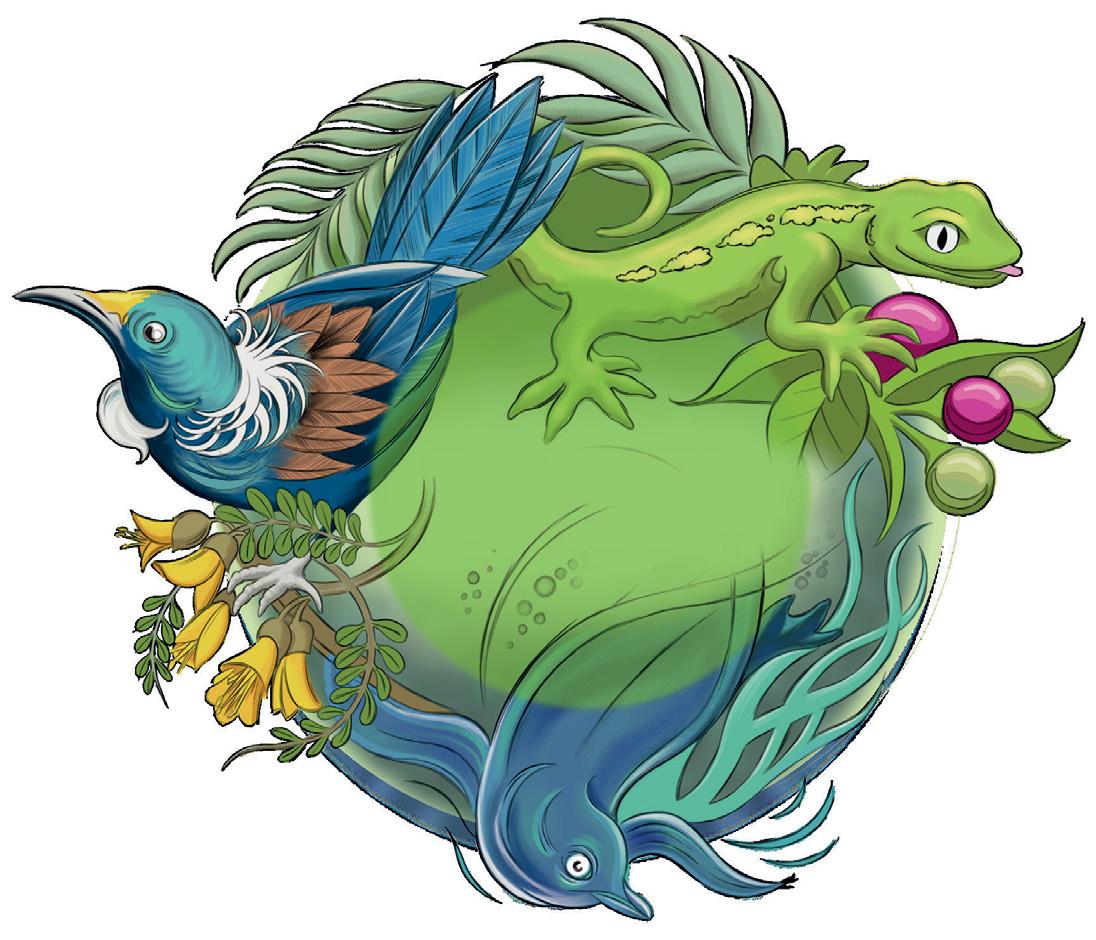
“Working together will
be critical if we are to find solutions to the two most-pressing global challenges of our generation –climate change and biodiversity loss.”
LATER IN THIS MAGAZINE
• The day Forest & Bird helped buy an island to protect the world’s rarest bird from extinction – see page 14.
• Nature’s heroes – we publish every Old Blue award winner since 1987. Do you recognise any of their names? See page 19.
• Sanderson snapshots: the life and times of Val Sanderson, Forest & Bird founder and grandfather of the modern day conservation movement – see page 30.
• Early advocacy and wins: what conservation battles did Forest & Bird fight during its first 25 years –check out page 33.
• Forest & Bird founding member and early Force of Nature Perrine Moncrieff is the focus of a new one-woman play –go to page 45.
SAT 25 –SUN 26 MARCH 2023 YEARS 1923–2023 CELEBRATING
NATURE NEWS | Forest & Bird Te Reo o te Taiao 6
Korimako bellbird. Tony Whitehead
DATES FOR YOUR DIARY
FORCE OF NATURE CONCERTS
Inspired by Forest & Bird’s work, eight New Zealand composers take us on a journey through our beautiful but fragile natural world. Buy your tickets today!
• Premieres 17 March at the Auckland Arts Festival – see www.aaf.co.nz/ event/force-of-nature
• 2 April, Wanaka Arts Festival –see www.festivalofcolour.co.nz/ programme/force-of-nature
• 3 April, The Piano, Christchurch –see http://bit.ly/3Icf6yV
BIG BIRTHDAY BASH
Join us for a fun nature-themed day out at Bushy Park Tarapuruhi, near Whanganui (Saturday 25 March)
| Pelorus Bridge Scenic Reserve, Marlborough (Sunday 26 March) |
Lenz Reserve, the Catlins (Saturday 25 March). Keep an eye on your inboxes for more information.
SPEAKER SERIES
Forest & Bird will be hosting a monthly in-person conservation speaker event that will also be streamed online. Each month will feature a different nature-related topic, and the series kicks off on 21 March with an event marking International Day of Forests. The speakers will share their expertise and stories about our native forests.
CENTENNIAL STAMPS
NZ Post will launch four stamps and merchandise to celebrate a century of conservation. Created in collaboration with Forest & Bird and Wellington wildlife artist Rachel Walker, the stunning designs feature four landscapes and their flora and fauna. The official launch takes place on 5 April at Otari Wilton Bush, once home to Forest & Bird VicePresident Dr Leonard Cockayne.
SANDERSON WAY & EXHIBITION
The Paekākāriki community and our chief executive Nicola Toki will be gathering at St Peter’s Hall on Saturday 29 April to pay tribute to Captain Ernest “Val”Sanderson, who lived in the village. Part of the local restored Waikākāriki wetland will be renamed Sanderson Way, and a sign about his life will be unveiled. The weekend exhibition (29-30 April) Inspired by Sanderson is a collaboration with the Paekākāriki Station Museum and local conservation groups. We’d like to acknowledge Paul Callister and members of Ngā Uruora for initiating this project.
CENTENNIAL CONFERENCE
After a hiatus of three years, Forest & Bird’s annual conference will be back bigger and better than ever. Join us on Saturday, 29 July 2023 at Te Papa, Wellington, to celebrate a century of conservation mahi and look forward to the next 100 years.

7
Keep up to date with the many centennial events coming up and find out how to get involved, at www.forestandbird.org.nz/centennialcelebrations
Forest & Bird’s staff are looking forward to a year of centennial celebrations. George Hobson
TWIN CAUSES FOR CELEBRATION
New fishing rules are set to be introduced at three coastal marine hotspots in Northland following legal action by Forest & Bird, hapū, and Bay of Islands Maritime Inc.
Two areas will be acknowledged as rāhui tapu, with fishing prohibited around the Mimiwhangata Peninsula, north of Whangārei, and between Maunganui Bay and Oke Bay, in the Bay of Islands. A third area, around Rākaumangamanga Cape Brett, will see a bottom trawling and purse seining ban.
“The newly protected areas will leave a positive legacy of recovery at the exact time when resilience is needed most from a changing climate and ocean,” said Dean Baigent-Mercer, Forest & Bird’s Northland conservation manager.
An Environment Court ruling in November supported a rāhui for both locations. Another court decision finalising the rāhui details was expected at the time of writing.
In 2017, Forest & Bird’s legal team swung into action when Northland Regional Council’s Regional Plan was publicly notified but but lacked sufficient rules to fully protect marine biodiversity.
In appealing the Plan, Forest & Bird worked with kaumātua of Ngāti Kuta and Te Uri o Hikihiki, as well as Northland-based community group Fish Forever.
Our lawyers used precedents established in the Bay of Plenty by the Motiti Rohe Moana Trust’s case, which ruled that regional councils can protect significant native biodiversity in the sea out to 12 nautical miles.

Our campaign to stop new mines being built on conservation land has taken a huge step forward with new legislation on the horizon.
Last year, we called on then Prime Minister Jacinda Ardern to fulfil the Labour government’s 2017 promise to end all new mines on conservation land.
Together with our friends at Greenpeace and Coromandel Watchdog, we took a giant yellow banner on a tiki tour around Aotearoa to places threatened by new coal and gold mines.

Your donations helped us reach hundreds of thousands of people and made your voices heard through a powerful combination of lobbying MPs, widespread media coverage, billboard and poster campaigns, and a mass mobilisation on social media.
We’re thrilled to announce everyone’s efforts have paid off. In February, Prime Minister Chris Hipkins committed to drafting a Bill that will put an end to new mines on conservation land.
“This is a huge victory, but our work is far from done,” says George Hobson, who has been coordinating the No New Mines campaign for Forest & Bird.
“At the time of writing, Prime Minister Hipkins had yet to announce when this law will come into effect.
“Forest & Bird remains steadfast in our commitment to carry on reminding the government that New Zealanders want conservation land protected for future generations.”
NATURE NEWS
| Forest & Bird Te Reo o te Taiao 8
Thanks to your generous donations and support, we are delighted to report two recent wins for nature on land and in the ocean.
Maunganui Bay kelp forest. Paihia Dive
9 to 16 Jan 2024
check out our website for additional tour dates

CHATHAM ISLANDS
Highlights
8-day guided tour with ornithologist and conservationist Mike Bell



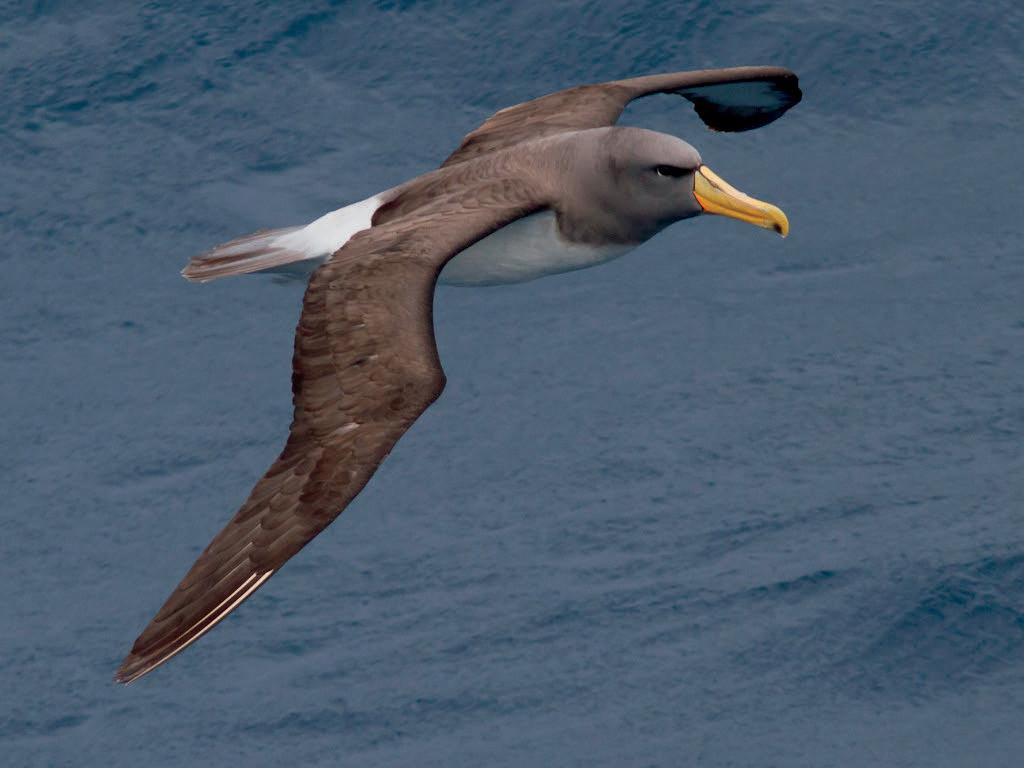
Discover unique people, history, culture, geology, flora and fauna
Visit Pitt Island nature reserves
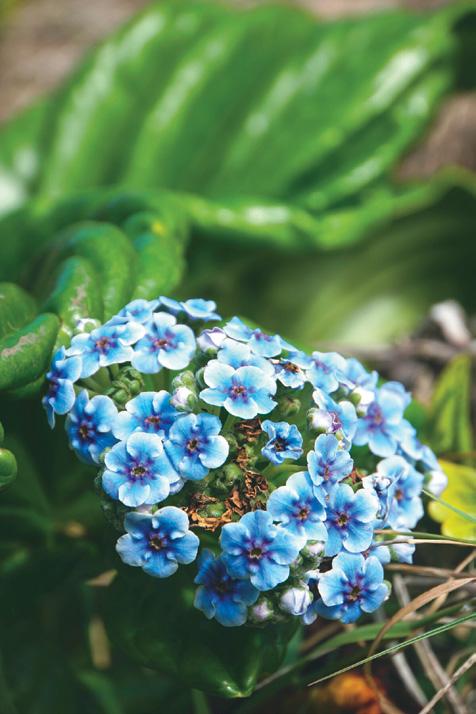

Explore outer islands, including SE Island and Mangere from the water
Learn about the Chatham Island Taiko Trust
Price from $7,175pp*.
*The current price per person twin share in NZD. Includes return air travel on Air Chathams, seven nights' accommodation, all meals including continental breakfast / picnic lunches / buffet dinners, all sightseeing and entry fees as per itinerary. Refer to website for full price inclusions & single traveller pricing - www.wildearth-travel.com. Wild Earth Travel has regular Chatham Islands tours throughout the summer season - dates, prices and itineraries will vary.

w w w . w i l d e a r t h - t r a v e l . c o m i n f o @ w i l d e a r t h - t r a v e l . c o m
Mike Bell
TOUR GUIDE
9 Autumn 2023 |
Over the past five summers, Forest & Bird’s Te Hoiere Bat Recovery team has been carrying out monitoring at Pelorus Bridge Scenic Reserve, Marlborough, leading to several exciting discoveries of roost trees.


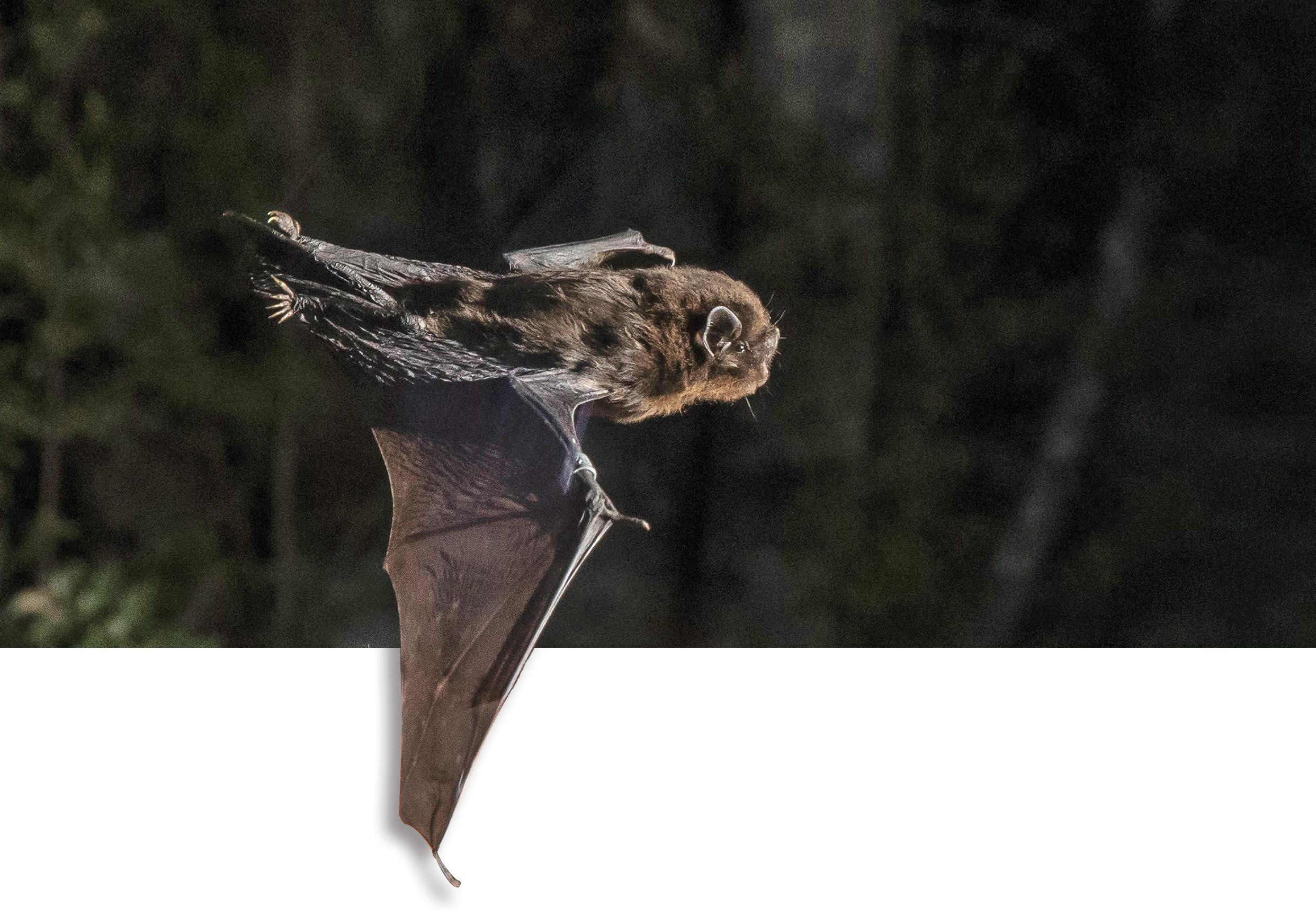
In January, our field team decided to search for pekepaka maternity roosts, where mothers collectively care for their young, in neighbouring Rai Valley reserves.
Lo and behold, a significant number of roosts were discovered in Ronga Recreation Reserve, with some also found in both the Carluke Reserve and Brown River Reserve areas.
Forest & Bird’s national conservation projects manager Mandy Noffke is thrilled about this significant discovery.
“All indications are that we have two social groups in Te Hoiere Catchment – one in Pelorus and another that frequents the Rai Valley area,” she said.
“Many more years of data are going to be needed to have a better understanding of the
BOOST Bat
population dynamics, but the fact there are multiple thriving colonies is incredibly exciting.”
Pekapeka have long been in decline all over Aotearoa because their habitats are threatened by land use changes, loss of habitat, fragmentation, weeds, and predators.
The 18ha Ronga Reserve is a little known enclave of native bush north of Pelorus Bridge. It’s one of the last remaining podocarp lowland forest remnants to have survived logging and farming.
Led by Michael North,
volunteers from the Nelson Tasman Weedbusters and Forest & Bird’s Nelson-Tasman and Marlborough Branches have been carrying out restoration plantings and weed control there.
The large mature mataī and rimu trees provide ideal roosting habitats, as the monitoring team found out when they went there at night in search of the notoriously difficult-tofind roosts.
At the time of going to print, there were eight confirmed maternity roosts in Ronga, five in Carluke, and two in Brown River. The team
NATURE NEWS | Forest & Bird Te Reo o te Taiao 10
Colin Donnell
A colony of pekapeka has been discovered in the Rai Valley, Marlborough, bringing hope for this rarely seen species. Lynn Freeman
Pekapeka long-tailed bat. Ian McGregor
Jen Waite (left) and Grant Maslowski take body measurements and sex the bats. Connor Wallace
Bats were fitted with transmitters so they could be tracked.

also found evidence of bats frequenting the Opouri Valley, 5km from Ronga and high in the Mt Richmond Forest Park.
Unfortunately, this story of hope comes with a significant “but”. One of the roosts filmed using thermal imaging detected two rats on a tree watching as the bats were emerging. Despite their best efforts to catch and kill their prey, this time the rats failed.
Plans are afoot to roll out more predator control to protect these newly discovered roosts, which are located on public conservation land.
Forest & Bird would like to thank the many generous individuals and organisations helping support our bat restoration work at Pelorus, including Marlborough District Council, Jobs for Nature, Lottery Environment and Heritage Committee, Evergreen Trust, and Transpower. We also acknowledge Te Hoiere Project, Kotahitanga mō te Taiao Alliance, and Ngāti Kuia for their continuing support for pekapeka protection in Te Tauihu.
For the past century, Forest & Bird has been the impartial voice for nature in general election years, reminding all political parties of the urgency of protecting our environment.
Nature is at a critical point, and our elected leaders need to take immediate action to save the incredible species and ecosystems that define our national identity.
This election year, Forest & Bird will be working to keep climate, biodiversity, and freshwater issues at the forefront of everyone’s minds, especially those of our political candidates. Join us in our mission to be a voice for nature, and protect the beauty and diversity of our nature heritage for future generations.

Forest & Bird’s Te Hoiere Bat Recovery Project has been working for nearly two decades to protect the precious remnant long-tailed bat population at Pelorus Bridge, in Marlborough.

The Society’s former Top of the South regional manager Debs Martin first stumbled across the bats when she was camping at the Department of Conservation’s picturesque Pelorus Bridge Scenic Reserve campground. Then, in 2005, local Forest & Bird branches started looking for bat populations in the area.
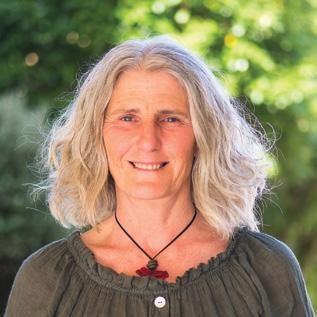
Forest & Bird commissioned a bat survey of the top of the South Island to pinpoint the best location for a restoration project. It discovered only three populations of pekapeka, including the one at Pelorus, which was the most viable. In 2008, the Society launched its first conservation project focused solely on bat recovery.
Since then, local volunteers, including members from our NelsonTasman and Marlborough Branches, have managed a dedicated trapping network at Pelorus to protect and restore bat habitat and breeding sites.
“Working together we can make our environment a priority at this election,” says Geoff Keey, Forest & Bird’s strategic advisor. “Talking to your family and friends, sharing our tweets, Facebook, and Instagram posts, and going to meet candidates or attending election meetings are all ways to make a difference.” Forest & Bird staff will also be supporting branches and youth to organise local “meet the candidates” event focusing on conservation issues.
Forest & Bird’s election campaign will be kicking off soon – keep an eye on your emails. Over the coming months, we will also be providing election resources directly to branches.
11 Autumn 2023 |
Monitoring for long-tailed bats.
Debs Martin
E-DNA DISCOVERY PROJECT
Do you help look after a stream, wetland, or river in a Forest & Bird reserve or project site?
We have some free Wilderlab e-DNA kits to give away and are seeking expressions of interest from branches keen to find out what is living in their freshwater backyards.

Environmental DNA is genetic material shed from living things into water, air, or soil. Samples can be taken from a local river, beach, or reserve and sent to a lab for analysis.
Over the past three years, eDNA has been quietly sparking a change in conservation – and Wilderlab has been at the forefront of making the technology more accessible to New Zealanders.
The company’s eDNA sampling kits and lab-testing service are allowing more conservationists to discover the full range of species living in local waterways, including land-based animals.
This e-DNA project has been generously funded by two of Forest & Bird’s donors who are as passionate about protecting and restoring our streams, wetlands, and lakes as we are!
Forest & Bird’s major projects are taking part too, with kits going to Ark in the Park, Southeast Wildlink, Bushy Park Tarapuruhi, Te Hoiere Bat Project, and the Otago Seabird projects.
We will be sharing the exciting finds in future issues of this magazine.
To register your interest and find out more, email freshwater@forestandbird.org.nz. You can read about Wilderlab’s eDNA technology in our Summer 2022 issue at www.forestandbird.org.nz/resources/poweredna
LIFELONG LEGACY
In 1965, Geoff Harrow made a startling discovery that set him on a quest to save a very special seabird endemic to Kaikōura.
A conversation with Kaikōura local, Ivan Hislop, led Geoff, who was a keen mountaineer, to organise an expedition into the remote Kaikōura ranges.

There, at the head of the Kōwhai Valley, he found Hutton’s shearwater breeding burrows. He made it his lifelong mission to better understand and protect the species.
Over following years, Geoff returned to the ranges to discover more tītī shearwater nesting sites and hundreds of thousands of burrows.
In 2008, Geoff established a charitable trust to raise funds to establish up a new nesting site on the Kaikōura Peninsula, working with Whalewatch, Te Runanga o Kaikoura, and the Department of Conservation.

Geoff was a long-standing Forest & Bird supporter, having joined the Society in 1936 aged 10. He received an Old Blue award in 2007 (aged 81) for his outstanding contribution to conservation.
A decade later, he received a Queen’s Service Medal for services to conservation and mountaineering spanning 70 years.
At 88, he said he wanted to “retire gracefully” so he could “wallow peacefully remembering 50 wonderful years with Hutton’s shearwaters”.
Geoff passed away on 16 January in Christchurch, aged 96.
NATURE NEWS
Geoff Harrow in the Kōwhai Valley. Ailsa McGilvary-Howard
| Forest & Bird Te Reo o te Taiao 12
Hutton’s shearwater chick.
NEW CALEDONIA CALLING
Nouméa has all the features you might expect from tropical islands – white sands, blue lagoons, and graceful palms – and is also home to some amazing plants and wildlife.
Never been? Why not join experienced tour guide and naturalist Mark Hanger on a conservation trip of a lifetime to New Caledonia this October while also supporting Forest & Bird.
Mark, who is our President, is running this 14-night Forest & Bird fundraising trip to Nouméa, departing 31 October 2023, plus an optional two-day extension to Île des Pins.
Unlike many Pacific Islands, New Caledonia is an ancient fragment of Gondwana and considered one of the world’s most botanically important hotspots. It is also home to a rich indigenous Melanesian culture.
The island is known for its abundant conifers belonging the ancient plant family Araucariaceae There’s also the chance to see inland rainforests, giant ferns, and a host of endemic birds including the cagou, New Caledonia’s national bird.
The tour includes a visit to a marine sanctuary, where you will explore some fabulous underwater “forests” and time exploring what used to be the world’s largest chromium mine. It’s being restored as a haven for the endemic plants that have evolved to live in the island’s inhospitable mineral-rich soils.

Mark is also running Forest & Bird fundraising tours to West Australia (September 2023), Latitude 42 in (October 2023), Alpine Aotearoa (January 2024), and Te Ao o Tāne (April 2024).
Find out more by contacting Mark Hanger at markhanger@naturequest.co.nz and requesting a brochure.
FUNDRAISING ARTIST

Abig shout out to everyone who supported Te Araroa Trail artist Sarah Adam, who generously donated 20% of proceeds from her recent exhibition at the Depot Gallery, Devonport. Sarah created a painting a day while walking the trail and sold 96 artworks last December, raising a whopping $3,460 for Forest & Bird.
Meanwhile, Alexander Bezzina aka “The lost Hobbit” is running the length of New Zealand (3000km) and aiming to raise $10 per kilometre. All proceeds from his epic run will go towards Forest & Bird’s conservation work, and Alex is aiming to raise $30,000. Please support his incredible efforts here www.givealittle. co.nz/fundraiser/the-lost-hobbit-for-aotearoanzbirdsand-wildlife. You can find out more about why Alex is running for the birds of Aotearoa at www.thelosthobbit.run
 Le Poulet (the hen) rock formation near Hienghene. New Caledonia Tourism
Le Poulet (the hen) rock formation near Hienghene. New Caledonia Tourism
13 Autumn 2023 |
BACK IN BLACK
The first translocation of Chatham Island black robins in 20 years is the latest in long-running efforts to ensure they have a bright future.

Holly Taylor and Caroline Wood
Forty years ago, a female Chatham Island black robin called Old Blue held the future of her whānau in her wings. The story of how she helped bring her species back from the brink of extinction became a symbol of hope for nature lovers around the world.
In the 1970s and 80s, conservationists used daring and creative methods to help the species survive and recover, including moving birds between islands and using a foster species to incubate Old Blue’s eggs.
Led by the legendary threatened species expert Don Merton, the successful mission showed how Aotearoa New Zealand could lead the world in island restoration and bird recovery.
Forest & Bird is proud to have played a role in Old Blue’s story,
radius, the largest of which are Chatham Island and Rangiauria Pitt Island.



Black robins, known as karure in ta re Moriori and kakaruia in te reo Māori, currently live in the forest on two small islands.
Rangatira South East Island has about 270 robins, with stable
COVER
Karure | kakaruia | Chatham Island black robin.
Rēkohu Chatham Island
Rangiauria Pitt Island
Rangatira South East Island
Little Mangere
| Forest & Bird Te Reo o te Taiao 14
Mangere Island
Mangere robins, along with the fact that the only other population is near capacity, means a high risk of extinction.
The Department of Conservation decided to launch a recovery effort to secure the future of the species by translocating healthy female robins from Rangatira to Mangere in the hope it will boost the maledominated population.
story of black robin recovery.
“I’ve been involved in reintroductions for 30 years but had never been to the Chathams before, so to be a part of this was a bucket list moment for me,” he said.
The other members of the team included translocation expert Dr Kevin Parker, who led the project, Dr Enzo Rodriguez-Reyes, Erin Patterson, Jemma Welch, Cassidy Solomon (all from DOC’s Chatham Island office), and Bruce Harrison of Auckland Council.

The first nine days of their trip was spent on Rangatira Island, where the team fed and trained the birds, using meal worms to coax them into the traps to get them accustomed to the process.
Given the time of year, the females were constantly pestered by the males, making it difficult for them to feed, and many were initially wary of the traps.
the past two breeding seasons.
“This taonga species represents not just the identity of the entire Chatham Islands community but also a world example of the effort for saving species at risk of extinction.”
Translocations are highly risky for individual birds due to the stresses involved.
Planning began in 2021 with a community and expert workshop held on Rēkohu Wharekauri, the main Chatham Island, which confirmed the need to assist the Mangere population through a topup translocation of 10 females.
A model of the Mangere population developed by ecologist Dr Liz Parlato was a critical component in this process as it showed how, without any intervention, the species could be functionally extinct at this site within four years.
Last September, a specialist team, including Professor Emeritus Doug Armstrong, of Massey University, carried out the first translocation of the species in 20 years to help secure their future survival.


Doug, who is also Oceania Chair of the International Union for Conservation of Nature Conservation Translocation Specialist Group, says it was special to have a role in the world-famous
The female birds were identified using the band colours on their legs. Several months earlier, the juveniles were sexed using DNA extracted from feather samples.
The team managed to catch the 10 females within the first two hours, making for an easier transfer onto the boat for the 45-minute trip to Mangere. The birds were released by early afternoon on the same day.
“The birds we were translocating were descended from Old Blue,” said Dr Enzo Rodriguez-Reyes, who has been monitoring the robins for
After the translocation, the Mangere population was monitored daily, with seven of the 10 translocated females being seen regularly, which is a good sign. Two recently arrived females successfully bred with local males and, at the time of writing, each was raising two chicks.
As Forest & Bird turns 100, Old Blue’s story of survival and recovery resonates as much today as it did half a century ago.
“This black robin was at the centre of one of the most remarkable conservation efforts ever attempted in the world,” said Nicola Toki, Forest & Bird’s chief executive. “It caught the imagination of bird lovers here in Aotearoa and overseas, and showed the power of hope and action in nature conservation.

→
Kevin Parker, Jemma Welch, Cassidy Solomon, Bruce Harrison, Erin Patterson, Doug Armstrong, Enzo Rodriguez-Reyes.
Professor Emeritus Doug Armstrong
The team boarding the robins onto the boat from Rangatira South East Island. Enzo Rodriguez-Reyes
15 Autumn 2023 |
Enzo RodriguezReyes with a Chatham Island black robin.
“Like many New Zealanders, I was incredibly inspired by the story of the black robin when I was growing up, and this story reminds me on a daily basis why we must never give up when it comes to conservation challenges.
“Everyone involved left a huge legacy, and I’d like to pay particular tribute to the Wildlife Service team and the Society’s former presidents Roy Nelson and John Jerram, who were determined to stop this bird going the way of other species that had already become extinct on Rēkohu the Chatham Islands.
“Their courageous actions,
RECHARGE IN THE WILD
Escape the hustle of modern life and sail into the serene on a remote, bespoke adventure into Fiordland. The Breaksea Girl your home in the wild, has all the creature comforts, a small family of expert guides and hosts a collection of multi-day adventures customised to get you closer than ever before.


taken half a century ago, are part of Forest & Bird’s whakapapa, and I’m looking forward to sharing more stories like this as we celebrate 100 years of conservation action all over Aotearoa New Zealand.”
DOC and the local community would like to “rewild” karure | kakaruia to other islands in the future – returning them to places where they once thrived 150 years ago.
It will take time and funds, but the seeds of this ambitious programme were sown with this recent year’s translocation.
experts and the community agreed to progress the establishment of new black robin populations on Rēkohu and Rangihaute Pitt Island. This will reduce the risk of extinction and increase community connection to the species. Before further translocations can happen, one or more sites on the islands must be properly prepared.
This includes setting up predator-exclusion fences and mammalian pest eradications, as well as seeking agreement from the DOC’s treaty partners and community.
It’s an ongoing process in the long continuing fight for population recovery of the black robin. But, with the dedication of the experts involved and the support of the community, the future is looking brighter for Rēkohu black robins.
Let’s buy an island to save a species: Forest & Bird’s role in saving the Chatham Island black
wildfiordland.co.nz

COVER
→ | Forest & Bird Te Reo o te Taiao 16
Transporting the robins to Robin Bush, Mangere Island. Enzo Rodriguez-Reyes
KAYAK . SAIL. SNORKEL. FREE DIVE HIKE. WINE. DINE. UNWIND.
Doug Armstrong
HOPE IN ACTION
Once widespread throughout the Chatham Island archipelago, by the late 1870s the endemic black robin was confined to two small islands –Mangere and Little Mangere.
In 1938, a young Charles Fleming was one of the first to raise the alarm about the perilous state of the robins following a visit to Little Mangere Island accompanied by fellow Auckland University student Graham Turbott.
During a death-defying climb up the cliffs of the island, known as Tapuaenuku in Moriori, Fleming and his colleagues “rediscovered” a karure | kakaruia population but estimated there were only 20–35 pairs of black robins left.

They also documented other
rare birds, including Forbes’ parakeet. But there was no sign of the Mangere rail, Chatham Island fernbird, or Chatham Island bellbird, all of whom had already joined the extinction list.
Fleming, who was a great supporter of Forest & Bird’s work and went on to have an illustrious career as an ornithologist and conservationist, proposed protection status for Little Mangere. His series of scientific papers on the birds of the Chathams, published in 1939, remains a major contribution to knowledge of that area today.
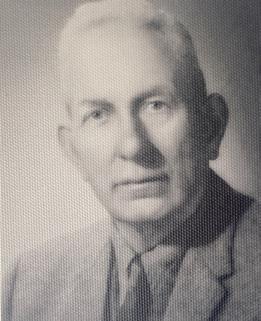
In 1956, Forest & Bird published a four-page article in its journal Vanishing Species on the Chatham Islands, written by one of its members, who had visited the previous year.

Dr John Findlay alerted readers to the poor state of flora and fauna unique to the remote archipelago. Much of the damage was being caused by grazing farm stock.

He finished his article by saying “...most Chatham Islanders are nature lovers and would welcome any measure that would help save their wildlife heritage”.
Forest & Bird’s President Roy Nelson penned a strongly worded
editorial next to Findlay’s article listing the plant and bird species that had already become extinct. He called for more botanical reserves to be established.
He also noted the New Zealand Wildlife Service had also raised concerns and recommended at least two areas be set aside “to preserve for all time some of the unique flora found there”.
In 1961, Rangatira South East Island was gazetted a nature sanctuary and became sheep free. Once the browsing mammals had been removed, the indigenous habitat bounced back, showing it was possible to restore the bird’s habitat once pests were removed.
Meanwhile, on Mangere Island, “bush birds and petrels” had almost disappeared, according to a Lands and Survey Department report, most likely victims of the cats that had been liberated to control rabbits.
Roy Nelson wrote to Lands and Survey in 1963 setting out the many grounds that existed for making Mangere Island a wildlife sanctuary that could potentially receive transfers of endangered birds, including black robins, from Little Mangere.
He offered to help fund the island’s purchase, and, after some negotiation, Forest & Bird donated £2,000 (the equivalent of nearly $100,000 in today’s money).
Fearing the Chatham Island robin was in perilous danger, three generations of conservationists battled to save them. Caroline Wood
The view toward Little Mangere Island from the summit of Mangere
Island.
→
Charles Fleming at Tuku Farm, Chatham Island, 1938. Courtesy Jean Fleming
Roy Nelson
17 Autumn 2023 |
Mangere Island with Little Mangere top right in 1969. The slope centre and left is where the main tree planting was done in the 1970s. Forest & Bird Archives
In 1963, the Crown bought Mangere Island for £3,454, including a generous contribution from the Society’s supporters, and it became a protected flora and fauna reserve, although cats remained a problem.
Next, Nelson offered to help the government buy more land on neighbouring islands, but the money was not needed. The government bought a 240ha plot known as the Glory Block in the centre of Rangiauria Pitt Island that contained relatively unmodified rat-free forest.
Nelson also attempted to buy Tapuaenuku Little Mangere Island so it could become a protected bird sanctuary, but he failed and it remained in private hands.
By 1969, there were only 15–20 pairs of black robins remaining on Little Mangere. Then, in the early 1970s, it was reported that cats had killed off 12 species of birds on Mangere.
The last two populations of Chatham Island black robins on Earth were in serious trouble.
Brian Bell, a leading ornithologist and threatened species conservationist who was working for the Wildlife Service, approached Forest & Bird with a plan to save them.
In 1975, the society’s president John Jerram agreed to mount a fundraising appeal
to help save the black robin. Jerram undertook to raise enough money in donations to plant 50,000 hardy Chatham Island akeake (Olearia traversi) over five years.

Once restored, the plan was to translocate the last seven remaining birds from Little Mangere to the larger more accessible Mangere Island.
Bell even suggested a slogan for the appeal “Save the black robin –adopt a tree at 50 cents”.
The society’s branches swung into action, seeking donations from all over the country, and the appeal was a resounding success, raising more than double the target amount in 1976.
The $14,000 supported the purchase and planting of 120,000 plants on Mangere Island. In 1981, wildlife photographer Rod Morris visited and reported the plants had grown above head height, providing shelter, leaf litter, and insect habitat for the robins and other species.
But the fate of the black robin was still hanging by a thread. By 1980, there were just five birds left and only one breeding pair – Old Blue and Old Yellow.
It was up to Bell and his team, which included Don Merton, to save the species. They knew it was a race against time, having recently witnessed the loss of three unique species.
In 1964, the pair had been part of a heroic but ultimately unsuccessful attempt to save the last South Island snipe, the greater short-tailed bat, and the New Zealand bush wren from a rat invasion on Big South Cape Island, near Rakiura.
The black robin is a slow breeder, so Merton decided to try a cross-fostering programme using Chatham Island
warblers and tomtits as foster parents. This allowed the robins to produce more than one clutch per season. The success of this world-leading technique was spectacular – by the end of the 1984/85 breeding season, the number of robins had increased to 38.
Old Blue produced the entire first generation of robins born on Mangere Island, securing her a place in the annals of New Zealand conservation. Her offspring prospered. She was the mother of six chicks and grandmother to 11.

In 2010, Don Merton received an Old Blue award from Forest & Bird for his outstanding contribution to conservation. He led the black robin recovery programme for more than a decade and played a key role in saving tīeke South Island saddleback and kākāpō. Today, there are about 300 adult black robins, and the akeake forest planted with the aid of Forest & Bird donations is flourishing.

This article includes previously unpublished stories collected by Forest & Bird’s Force of Nature history project with funding from the Stout Trust.
 Brian Bell in 2012.
Brian Bell in 2012.
COVER
Don Merton with a Chatham Island black robin.
A plaque on Mangere Island commemorates Old Blue's legacy. Enzo Rodriguez-Reyes
| Forest & Bird Te Reo o te Taiao 18
This is how the akeake trees funded by Forest & Bird look today. Enzo Rodriguez-Reyes
LEAVING A LEGACY
Thirty-five years ago, Forest & Bird launched its Old Blue awards named after the Chatham Island black robin “mother” who saved her species from extinction. Since then, 201 men and women have been awarded an Old Blue in recognition of their huge contribution to nature protection in Aotearoa New Zealand. Here we publish a full list of the winners in tribute to all conservation volunteers – past, present, and future.

OLD BLUE AWARD RECIPIENTS 1987–2022
1987: Fraser Ross, South Canterbury |Rod Buchanan, West Coast | Nancy Payne, Central Auckland 1988: Philip Woolaston, Minister | Stan Butcher, Lower Hutt | Frank & Audrey Gamble, Southland | Jan & Peter Riddick, Central Auckland | Keith & Brenda Chapple, King Country | Lesley Shand, North Canterbury | Alan Ross, DOC 1989: David Appleton, Napier | Stan & Kath Ayling, Upper Coromandel | Bill Ballantine, Auckland | Helen Coulson, staff | Linda & Peter Daniel, DOC | Paul Every, Dunedin | Earle Norris, Waitaki 1990: Ron Freeston, Lower Hutt | Josie Driessen, South Auckland | John Findlay, Southern Hawke’s Bay | Fergus Sutherland, Southland | Cath Wallace, ECO 1991: Nina & Ken Spencer, Tauranga | Theo Simeonidis, Freshwater Anglers | Eric Geddes, North Shore | Ruth Mander, Tauranga | Ken Mason, Dunedin 1992: Christine Henderson, Southland | Ivan Green, Kapiti | Helen & Adrian Harrison, EBOP | Hugh Barr, FMC | Doug Heighway, Wairoa | John Staniland, Waitakere 1993: Ian Wilson, Far North | Debbie McLachlan, West Coast | Isabel Morgan, Napier | Alan Webster, Gisborne | Ines Stager and Peter Keller, South Canterbury 1994: Kevin Prime, Northland | Mike Kearns, Northern | Jim Howard, Rangitikei | Judy & Arn Piesse, Upper Coromandel | Dave Peebles, Lower Hutt 1995: Cathryn Ashley-Jones, Executive | John Black, South Canterbury | Kirsty Hamilton, Greenpeace | John Cuthbert, North Shore 1996: Betty Harris, South Auckland | Isobel Thompson, Central Auckland | Muriel & Ronald Ericson, Southland | Mabel Roy, Southland | Jim Holdaway, Auckland Conservation Board | Jim McMillan, Stop the Wash | Peter Maddison, Waitakere/Executive 1997: Betty Bockett, Central Auckland | Hugh Stewart, Rangitikei | Jean Luke, Kapiti | John Turnbull, Upper Clutha | Jocelyn Bieleski, Upper Coromandel | Bill Carlin, DOC 1998: Ken Catt, Waitakere | Delphine & Jack Cox, Lower Hutt | Fay Craig, Taupo | Joe Crandle, Mid North | Bett Davies, Taupo | Darrell Grace, Whanganui 1999: Don Chapple, Hauraki Islands | Michael Winch, Far North | Graham Falla, South Auckland | Christine and Brian Rance, Southland | Jenny Treloar, Te Puke | Ron Greenwood, benefactor 2000: Claire Stevens, North Shore | Valerie Campbell, North Canterbury | Roy Peacock, Hastings | Jan Butcher, Franklin | Nicky Hager, Wellington | Fensham Crew, Wairarapa 2001: Rosemary Gatland, South Auckland | Graham Petterson, Kāpiti | Dr Colin Meurk, North Canterbury | Noeline Sinclair, Ashburton | Jean Espie, Nelson-Tasman | Colin Ryder, Wellington 2002: Bill Gilbertson, Nelson-Tasman | Jo-Anne and Alan Vaughan, Golden Bay | Linda Conning, Eastern Bay
Of Plenty | Herman van Rooijen, South Waikato | Margaret Hopkins, Southland | John McLachlan, Kāpiti | Barry Wards, Upper Hutt 2003: Barry Lawrence, Upper Clutha | Philip Hart, Waikato | Gary James, Wellington | David Lawrie, Franklin | Edith Smith, Ashburton | Barry Dunnett, Kaikōura | Shaun Barnett, writer 2004: Bill Garland, outside Forest & Bird | Allan McKenzie, outside Forest & Bird | Basil Graeme, Tauranga | Raewyn Ricketts, Hastings/Havelock North (KCC) | Ruth Dalley & Lance Shaw, Southland (campaigning) 2005: Gary Bramley, Far North | Ken Lake, Central Auckland | Pete Lusk, West Coast | Betty Normington, Te Puke | Murray Hosking, outside Forest & Bird 2006: Peggy & Rob Snoep, Southland | John Talbot, South Canterbury | John Sumich, Waitakere | Jim Lewis, North Shore 2007: Karen & Maurice Colgan, North Shore | Carole Long, Bay of Plenty | Peter Howden, Ashburton | Arthur Cowan, Waikato | Bill Moore, Kāpiti | Geoff Harrow, Christchurch 2008: Liz Slooten, Executive | Ann Graeme, KCC coordinator | Geoff Park, ecologist | Bill Milne, Lower Hutt (posthumous) | Alan & Glennis Shephard, Upper Hutt| Muriel Fanselow, Dorothy Wernham & Rona Wark, North Shore KCC founders | Gillian Pollock, Nelson-Tasman | John & Pixie Marsh, Rangitikei 2009: Craig Carson, Southland | John Kendrick, bird call recordings | Dorothy Mutton, Te Puke | Queenie & Peter Balance, Nelson/Central Auckland | Tina Morgan, Upper Coromandel | 2010: Tom Hay, North Canterbury | Dave Kent, F & B magazine designer | Eddie Orsulich, Tauranga | John Topliff, Kāpiti/ Mana | Chris Bindon, Waitakere/Kaipara | Don Merton –issued by Executive under special circumstances in 2010 2011: Andy Dennis, Nelson | John Groom, Bay of Plenty| Mike Joy, Kāpiti | Alex Kettles, Lower Hutt | Jon Wenham, Waikato 2012: Eleanor Bissell, Christchurch | Anne Fenn, Central Auckland | Anne & Jack Groos, South Auckland | Maryann Ewers & Bill Rooke, Nelson-Tasman | Helen Campbell, Nelson-Tasman 2013: Hermann Frank, South Canterbury | Susan Millar, Upper Hutt | George Mason, New Plymouth | Rosalie Snoyink, Canterbury | Rod Morris, Otago Peninsula | Arthur Hinds, Waikato 2014: Nikola Hurring, Dunedin | Hugh Wilson, Banks Peninsula | Wilma & Ian McDonald, South Otago | Ian Noble, Hastings/Havelock North | Robin Chesterfield, Wellington 2015: Craig McKenzie, Dunedin | Julie McLintock, Nelson Tasman | Rod Brown, Kerikeri | Sylvia Jenkin, Wellington 2016: Roger Grace, Auckland | Neil Sutherland & Sheryl Corbett, Leigh | Laura Dawson, Taupō 2017: Glenys Mather, West Auckland | Bill Kerrison, Bay of Plenty | Margaret & Malcolm McPherson, Timaru | Wanda Tate, Porirua | Dr Jan Wright, Parliamentary Commissioner for the Environment| Russell Bell, Lower Hutt 2018: Roger Williams, Warkworth | Neil Eagles, Napier | Graeme Loh, Dunedin 2019: Jenny Campbell, Southland | 2020: Liz Carter, Napier | Pat Heffey, Northland | 2021 and 2022: No Old Blues awarded.
19 Autumn 2023 |
Old Blue. Don Merton
BRING BACK WETLANDS
A new report commissioned by Forest & Bird has revealed thousands of drained wetlands could be brought back to life.
Sadly, 90% of Aotearoa New Zealand’s wetlands have been lost over the past 100 years after being drained and built on or turned into farm pasture, parks, mines, or quarries.
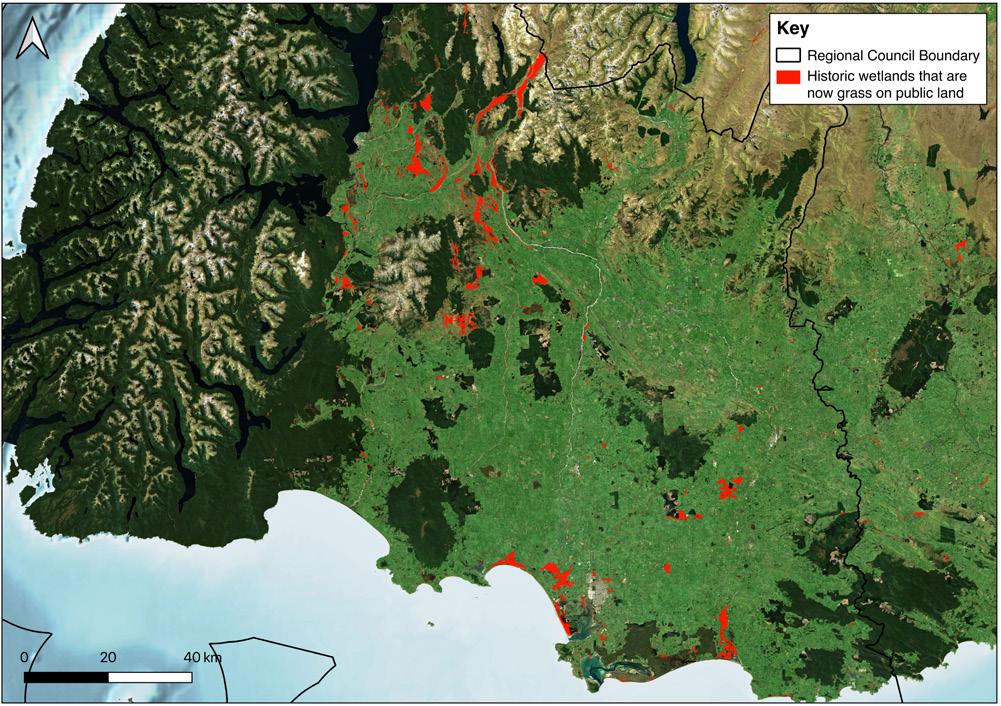
But the wonderful thing about wetlands is they have the potential to be rewetted, providing valuable new habitat for native species and helping mitigate climate change impacts.
You may have seen examples of this in this magazine recently with community-led wetland restoration projects in Coromandel and Southland.
Last year, Forest & Bird decided to find out how much former wetland was still in public ownership and therefore could be more easily restored by agencies.
We asked GIS mapping analyst Paul Hughes to identify historic wetlands across the country that could be brought back to life. We launched the findings in February on World Wetlands Day.
Forest & Bird’s freshwater advocate Tom Kay says about 125,000ha of river and stream margins, farmland, conservation land, parks, and other areas in public ownership could be considered for wetland restoration.
“These spaces have been cleared or drained and are now grassed, but there is a golden opportunity for councils and the government to restore many back to wetland ecosystems,” said Tom.
“Using Geographical Information System (GIS) software, we overlaid maps showing historic wetlands with other maps from the Central Record of State Land, the Land Cover Database, as well as maps from other sources.
“What we’ve discovered is a significant area of public land – in slivers, pockets, and larger areas – that were historically wetlands and could be again.”
The largest land holdings are managed by Pāmu Farms (29,000ha), the Department of Conservation (21,000ha), Land Information New Zealand (20,000ha),
Cate Hennessy and Caroline Wood
Southland Regional Council (3800ha), and the University of Canterbury (3400ha).
Forest & Bird hopes these organisations and local councils can build on our analysis and identify potential areas for wetland restoration. A couple have already contacted us to ask for our report and maps.
Several wetland restoration projects are already under way on public land, including:
n Kopurererua Valley wetland restoration and stream realignment (Tauranga City Council)
n Te Pourepo o Kaituna wetland creation (Bay of Plenty Regional Council, Department of Conservation, Tapuika, and Ngāti Whakaue)
n Queen Elizabeth Park wetland restoration as a permanent carbon sink (Greater Wellington Regional Council)
n Te Kuru wetland restoration and stormwater basin (Christchurch City Council)
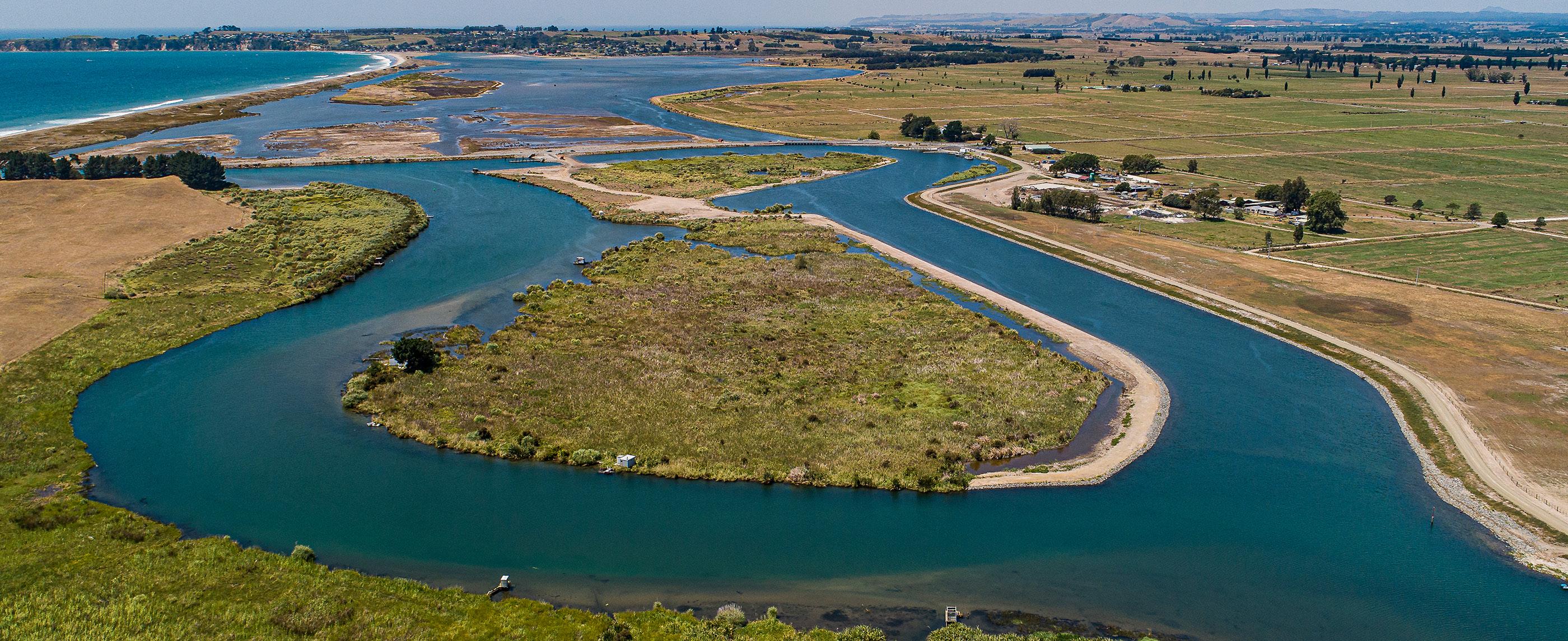
n Fred Burn wetland protection and restoration, Southland, (Pāmu).
“The wetland restoration projects already happening around Aotearoa show what is possible,” added Tom.
FRESHWATER
Kaituna wetland restoration. Bay of Plenty Regional Council
Historic wetlands in Southland (marked in red) that may have the potential to be restored.
| Forest & Bird Te Reo o te Taiao 20
Forest & Bird
“More and more councils and community groups are recognising the value of wetlands for carbon storage, climate resilience, biodiversity, and recreation.
“While some of the places identified in our report might not be suited to restoration, others would be ideal.”
Restoring wetlands will help the government achieve its climate, emissions, and biodiversity targets.
Forest & Bird hopes Ministers and council officials will use the findings contained in our new report Every Wetland Counts: Mapping the restoration potential of historic wetlands in public ownership as a starting point in identifying local sites for restoration.
Southland region has the most historic wetland still in public ownership (28,000ha), followed by the West Coast (20,000ha), Canterbury (18,000ha), Northland (16,000ha), Manawatū-Whanganui (11,000ha), and Waikato (10,000ha).
“Adding local data plus insights from iwi and community groups, it should be possible to prioritise potential projects all over the country,” said Tom. “We hope these findings will help communities start having these conversations.”
For more information about wetland restoration, see www.worldwetlandsday.org.
SHOW SOME AROHA FOR WETLANDS
Watching our country’s biggest-ever climate events unfold earlier this year in Auckland, Northland, Tairāwhiti, and Hawke’s Bay was heart-breaking.
Many of us felt helpless watching water pouring into homes and businesses, and landslips and storm surges destroying homes and roads. The two cyclone-related storms of January and February brought fear into the hearts of many.
But we are not helpless. We can take action. There’s so much good we can do by working together to protect and restore New Zealand’s life-giving wetlands, including in urban areas.
They can be our shield in helping protect against further flooding and other worst-case-scenario climate events.
“Communities experience massive benefits when local wetlands are restored,” says Tom Kay, Forest & Bird’s freshwater advocate.
“There’s enormous potential for central and local government to identify and prioritise new wetland
restoration projects, and we hope our report and maps will help them do this.”
Please take a stand and show your love for our wetlands by making a donation today. Together, we can help our precious natural wetlands keep nature and communities safe.
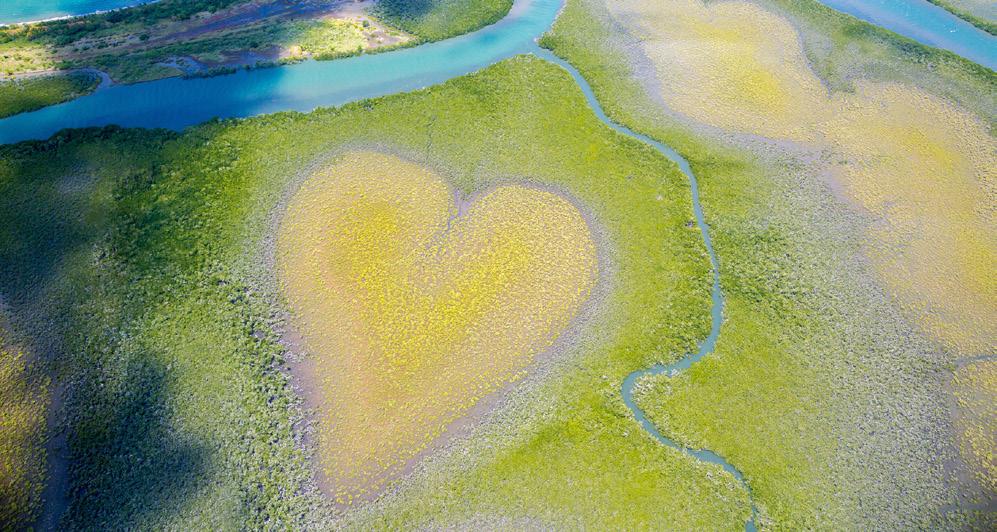
Donate today at www.forestandbird.org.nz/saveour-wetlands.
SEVEN BENEFITS OF RESTORING WETLANDS Revive biodiversity | Filter and replenish water supply | Store carbon | Blunt the impact of floods and storms | Improve livelihoods | Boost eco-tourism | Enhance wellbeing
WHAT IS FOREST & BIRD DOING?
Forest & Bird is campaigning for stronger wetland protections in Aotearoa while also working to restore wetlands in our own reserves.
Last year, Forest & Bird launched a new campaign called Every Wetland Counts | He Puipuiaki Ia Rohe Kōreporepo.
The campaign has six asks, including doubling natural wetland extent by 2050 and developing a national wetland restoration plan.
Our freshwater team is due to give an oral submission on our wetland asks to the government’s Environment Committee later this year.
As well as national advocacy, Forest & Bird’s branch volunteers look after wetlands in a string of reserves
from Northland to Southland.
These include a rare dune lake ecosystem at Forest & Bird’s Arethusa Lodge, in Northland, the Fensham Reserve, in the Wairarapa, home to many rare plant species, and the Fleming wetland, in our Lenz Reserve, the Catlins, where spotless crake were recently discovered.
For decades, our volunteers have also helped restore wetlands on conservation and privately owned land in their communities.
This includes the Waitangi Regional Park wetland restoration (Napier Branch), the Waiū wetland restoration, Wainuiomata (Lower Hutt Branch), and Poukawa Stream (Hastings-Havelock North Branch).
21 Autumn 2023 |
Heart of Voh mangrove wetland, New Caledonia. Shutterstock
OUR REMARKABLE SOUTHERN KAURI-LANDS
The magnificent kauri of the Waikato may not be as famous as some of their northern cousins, but they are vital to the future of the species, being almost free from kauri dieback disease. In the first of a two-part series, Dr Bruce Burns, one of New Zealand’s leading kauri academics, looks at the importance of our southern kauri forests and what makes them unique. Despite the threats they face, he is hopeful that, with a little human help, they can and will thrive into the future.

SPECIAL REPORT
| Forest & Bird Te Reo o te Taiao 22
Giant kauri at Waiomu, Coromandel. Ian Preece
Kauri have charisma. Their imposing columnar trunks rule over the forest, and their spreading greygreen canopies are open enough to provide a light and uplifting ambience to the forest understorey. Kauri are extreme trees in many ways – extreme in potential size, life expectancy, effects on the forests they inhabit, values they provide, and cultural importance.
As a botanist, I am always excited when I venture into a kauri forest, as it creates an unusual environment providing habitat for rarely seen plants. For example, the fan fern and the kauri greenhood orchids are almost solely restricted to kauri forests, with many other species having similar strong associations with kauri, including Archey’s frog. But it’s not only about individual species, being in a kauri forest stimulates all the senses at a more fundamental level – one can feel the presence of these giant trees around, reigning over the forest and its denizens.
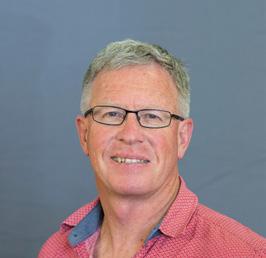

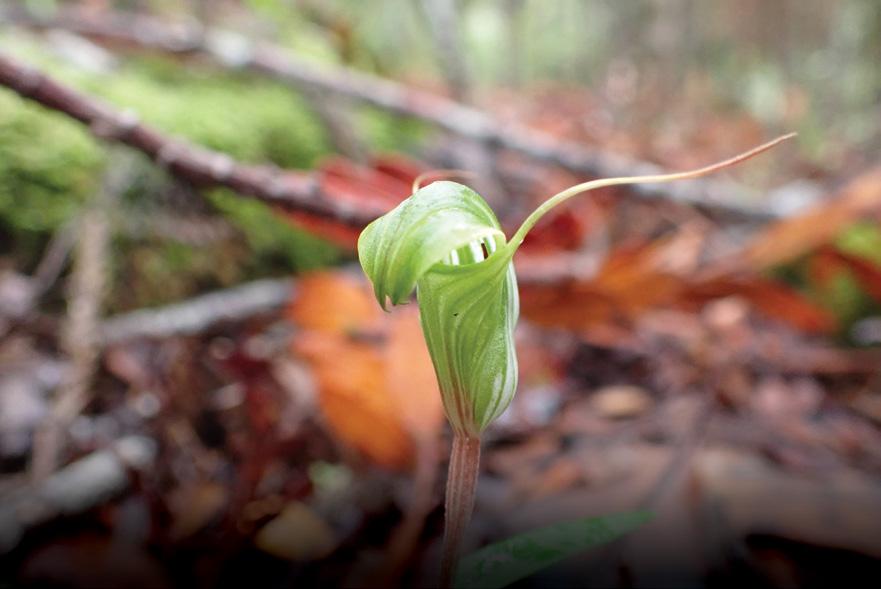


Although kauri encompass the northern third of the North Island, narratives of kauri forest often focus on Northland and Auckland, where their abundance and influence on landscapes are undoubted. The influence of kauri in the southern third of its range, however, has been somewhat neglected. Here, I want to delve into the story of kauri at its southern reaches – the kauri of the Waikato, Coromandel, and Kaimai Ranges. In these areas, kauri is equally special, has its own ecological signature, and provides historically and biologically fascinating stories with similarities and differences to the north.
Kauri extend from North Cape to its southernmost natural stands on or close to 38°S latitude just south of Kāwhia. That puts about one-third of its distribution south of the Bombay Hills in the Waikato region (including the Coromandel), with a few stands still occurring in the far northwestern corner of the Bay of Plenty region around Katikati. In the Waikato, kaurilands now cover about 94,000ha in a range of ecological scenarios, but, similar to other parts of their distribution, this represents a shadow of its former territory.
23 Autumn 2023 | →
Dr Bruce Burns is an Associate Professor, School of Biological Sciences, University of Auckland. Academic references for this article are available on request.
Kauri greenhood orchid. Biosense
Fan fern Schizaea dichotoma Jacqui Geux
Archey’s frog. Mahikarau Forest Estate
After the extensive exploitation for kauri timber that occurred from the mid-19th to the early 20th centuries, the area in mature kauri forest nationwide is now estimated at only a few percent of its original extent, with a greater but still relatively small area in younger regenerating kauri stands that were mostly initiated after the logging. Interestingly, much territory that originally supported kauri has not regenerated with kauri after its removal. It is not clear why this is so, but it is probably because logging was so effective that it removed any potential kauri seed sources and that logged sites were usurped by other tree species at the key time when kauri regeneration could have occurred, making them unavailable for kauri regeneration even if seed did eventually arrive.

In its southern range, notable stands of oldgrowth kauri still exist and include the high-altitude kauri on Te Moehau, giants in the Manaia Forest Sanctuary saved from logging in 1972, stands of mature kauri in the headwater valleys of the Third Branch of the Tairua River (which were inaccessible to exploitation), Whenuakite, Waiau Kauri Grove, Waiomu, Mt William, Tuahu, Pukemokemoke, Miranda Scientific Reserve, and Te Kauri Park near Kāwhia.
Many of these surviving mature stands still include some amazingly big and very old trees. The Manaia Forest Sanctuary on the Coromandel Peninsula was established to protect its superb old-growth kauri and holds many trees greater than 2m in diameter, including the sixth-largest known kauri, Tānenui. This tree was measured with a diameter of 3.5m and standing at 49.7m tall in 1976; it will be larger now. In 1987, Moinuddin Ahmed and John Ogden measured 25 old-growth kauri stands across Aotearoa, and the stand at Manaia had the largest basal area (a measure combining density and tree size) recorded anywhere. It also had the oldest trees, with one reliably estimated at 1527 years old.
Large kauri also occur in other parts of this southern domain. In 2002, former New Zealand Forest Service ranger Max Johnston provided details of 31 massive kauri that he and his colleagues had discovered and measured in the last few decades of the 20th century. These include the well-known Hamon Kauri, Square Kauri, Cookson Kauri, Tairua no 1, Waiomu no 1, and Tuahu trees. The amazing exploits of Johnston and his friends in searching out these large kauri in the Coromandel are not unique, and others continue to go into the hills in search of trees and other artifacts of the kauri logging era. Other kauri of interest are those that have paired up to form two large trunks side by side. These include the Siamese Kauri of the Waiau Grove and the Twin Kauri just north of Tairua.

| Forest & Bird Te Reo o te Taiao 24 →
Siamese Kauri, Waiau Forest, 309 Road, Coromandel. Ian Preece
Although large trees still exist in our kauri forests’ southern range, even larger giants that now no longer exist were recorded in the past. The 19th century botanist Thomas Kirk measured a kauri at Mill Creek, Mercury Bay, near Whitianga, at 7.3m in diameter. This giant tree was known as “Father of the kauri”, “Father of the forests”, and “King of the kauris” by local iwi in the area. An enormous tree was also reported in the upper reaches of the Tararu Stream, near Thames, in the late 1800s, with a diameter of approximately 4.5m, while local lore reports that kauri loggers and gum diggers used to have dances on a kauri stump 4.2m in diameter near Dancing Creek in the Kauaeranga Valley. By comparison, the largest surviving kauri tree in Aotearoa, Tāne Mahuta, is approximately 4.9m in diameter, according to a 2009 measurement in the New Zealand Tree Register.
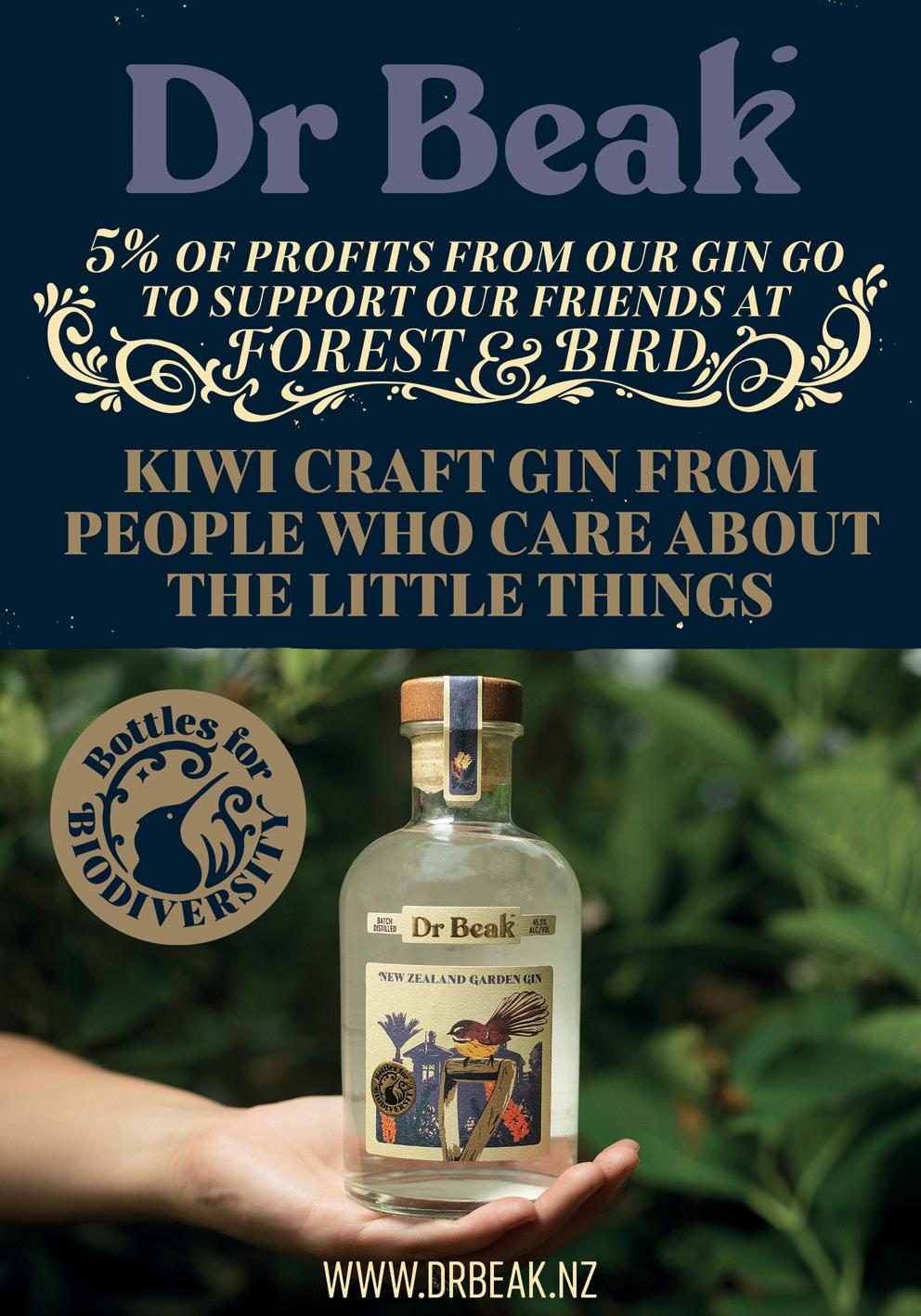
As a species, kauri (Agathis australis) is ancient. It has been in New Zealand for most, if not all, of the time Aotearoa has been a separate fragment of the former Gondwana supercontinent. Kauri were once distributed more widely in New Zealand than now, with kauri fossils found throughout New Zealand, including in Southland. More recently (geologically speaking) during the last ice age, kauri were probably limited to small refuge areas in the Far North before spreading south to their current distribution, starting around 7000 years ago.
About 3000 years ago, Kauri reached their current boundary, a line around 38°S latitude joining Kāwhia Harbour on the west coast with Tauranga on the east coast, with no evidence of further southward movement since then. This line is referred to as the Kauri Line and has been identified as a major zone of discontinuity in the distributions of many other native plant and animal species.
The question of why kauri only grow naturally north of this line in modern times has been the subject of conjecture among scientists for many years. A key early hypothesis was that seedling kauri are killed by frosts and this line marks the point moving southwards where frosts are too common for kauri seedlings to survive. Nevertheless, kauri planted in more southern areas seem to survive and grow well, albeit in sheltered sites, with individual kauri planted as far south as Rakiura Stewart Island. As well, stands planted around Wellington and New Plymouth are known to produce persistent seedlings, bringing the frost hypothesis into question.
Alternative hypotheses for the location of the Kauri Line focus on historical or environmental explanations. One historical rationale is that the Kauri Line coincides with the furthest probable extent of continuous forest during the height of the last glaciation. A hypothesis based on this coincidence suggests this landscape pattern has persisted into modern times, with kauri present in this continuous forest zone during glacials but outcompeted when the opportunity arose to colonise more southern sites that became available to
forest species when the current interglacial began. In terms of an environmental explanation, a 2020 analysis by PhD student Toby Elliott pointed out the height of the land above sea level generally increases abruptly as one moves north to south across the Kauri Line, and this sudden elevation increase may make kauri colonisation to the south difficult.
Kauri have always been important to the human inhabitants of its southern range. To iwi, kauri was and is a taonga species and the king of the forest. Many large war canoes were made from specially selected kauri logs, and kāpia (kauri resin) was used to provide a tattoo pigment, used as a fire-starter, and chewed as a treatment for stomach upsets. The earliest encounter by Europeans of kauri was undoubtedly when Captain Cook and his crew
25 Autumn 2023 | →
n Southern kauri forests are found in the Waikato region.
landed at Mercury Bay, in the north-eastern Coromandel, in November 1769. These and other early European explorers were impressed with the kauri as potential ship masts and spars, and kauri were first cut and exported in numbers for this purpose, many from the harbour at Whitianga.
By the middle of the 19th century, the high quality and quantity of timber that could be gained from logging kauri led to the establishment of a substantial industry, a key factor in kickstarting the New Zealand economy. Bushmen were employed to extract the often giant logs from forests wherever kauri occurred, and their efforts live on as part of the pioneering lore of New Zealand.
Nowhere were the ingenuity and engineering skills of the kauri bushmen used with more ruthless efficiency than in the steep terrain of the Coromandel Range, including the Kauaeranga Valley. The valley was logged for kauri from the 1870s to the 1930s, and during this time approximately 450,000m3 of kauri timber were removed, enough to construct 20,000 three-bedroom houses. The result of this extreme activity has left scars on the landscape that are still observable, and the forest is still recovering.
The last areas in Aotearoa to be logged extensively for kauri were generally in the south. The last kauri “dams” built to move logs downriver were those in the Kaimai Range near Katikati in the early days of World War II.

As well as timber, kauri also produces kāpia or kauri gum. In some ways, “gum” is a misnomer, as the exudate produced from kauri is not actually a gum in a strict sense but a plant resin, and fossilised kauri resin can be considered amber. Kauri resin accumulates in soil currently or formerly occupied by kauri forests, and the mining of such deposits fuelled an extractive industry almost as important as the kauri timber industry in 19th century New Zealand.
Although most kauri resin was extracted in Northland, gum digging also occurred on the Coromandel and a few other sites in kauri’s southern range.

Once it became difficult to find gum in soil, it was discovered that it could be obtained by “bleeding” trees, by purposefully cutting notches in trunks. The practice of bleeding kauri was employed on the Coromandel Peninsula, and many of today’s large trees exhibit scars resulting from such actions.
This may make them more susceptible to disease in the future, although the gum sought by the bleeders but still on the trees could now be protecting these giants from further decline by acting as a natural Band-aid.
This article was commissioned by Waikato Regional Council with the support of Tiakina Kauri, the Kauri Protection Agency. In the next issue: Bruce Burns looks at the unique ecology of Waikato’s kauri forests and the threats they face from kauri dieback disease and climate change.
Celebrating southern kauri
Many agencies and locals are involved in helping look after New Zealand’s southern kauri forests. Pictured (from left) Toni Twyford, of Tiakina Kauri the Kauri Protection Agency, Maree Limpus, DOC Community Ranger Hauraki, and Hirini Rolleston, Biosecurity Officer Kauri Protection for Waikato Regional Council. “Protecting our kauri from the pathogen associated with kauri dieback disease is critical if future generations are going to be able to see and appreciate them,” says Kim Parker, who heads up Waikato Regional Council’s kauri protection team. “That’s why we are committed to working with the local community, mana whenua, and other agencies to protect these kauri forests and celebrate their unique features.”
For more information, see www.waikatoregion.govt.nz or www.www.kauriprotection.co.nz

→
| Forest & Bird Te Reo o te Taiao 26
Kauri produces kāpia or kauri gum. Bruce Burns
Kauri boom, Whenuakite Creek, Coromandel, circa 1859–1900. Alexander Turnbull Library
RESTORING THE MANA OF THE NGARURORO
Following a seven-year campaign, the whole of the Ngaruroro River is set to be protected by a Water Conservation Order following a successful legal appeal by Forest & Bird.
Caroline Wood
In a big win for nature in the Hawke’s Bay, the Environment Court has recommended a Water Conservation Order (WCO) for the entire Ngaruroro River. This will ensure it is recognised and protected for future generations.
Forest & Bird, Fish & Game, Operation Pātiki Ngāti Hori ki Kohupatiki, Whitewater New Zealand, and Jet Boating New Zealand lodged the original application for a WCO on the Ngaruroro River in 2015.
In 2019, a Special Tribunal recommended only the upper naturally confined section of the braided river – one of only a few of its kind in the North Island – be covered by a WCO.

Forest & Bird appealed this decision, seeking the lower river’s braided reaches also be recognised as outstanding native bird habitat. The case was supported by the Department of Conservation.
In its report, released last December, the Environment Court agreed, saying both the upper and lower river were worthy of protection.
Forest & Bird’s freshwater advocate, Tom Kay, welcomed the decision, saying it was a win for the health of the river.
“Braided rivers like the Ngaruroro are rare in the world. While we have several in the South Island, the Ngaruroro is the most intact one in the North Island, which makes it extremely special,” he said.
“The upper reaches of the Ngaruroro are about as close as you can get to ‘pristine’. The landscape is incredible, the water is crystal clear, the habitat is outstanding for whio blue duck, and there are excellent opportunities for whitewater kayaking and rafting.
“The braided reaches of the lower river, and the estuary it flows into, are home to many threatened bird species, including kōtuku white heron, matuku

hūrepo Australasian bittern, pohowera banded dotterel, and the tarāpuka black-billed gull – the world’s most endangered gull.”
Once the WCO is gazetted – hopefully, later this year pending appeals – the Ngaruroro River will benefit from prohibitions on damming, limits on alteration to its flow and form, and measures to protect water quality.
“It’s been a challenge facing vocal opposition from some groups, as well as the regional council, which spent more than $1m fighting the proposal,” Tom added.
“The braided reaches provide a refuge for wildlife and also space for the river to flood. In the wake of Cyclone Gabrielle, we hope the WCO will spark a wider conversation about how we live with these rivers and their floodplains, in the future.”
In 2007, Forest & Bird helped stop an inappropriate hydroelectric power project on the Gowan, a tributary of the Buller River. The project proposal was the first time anyone had sought to vary a Water Conservation Order, and the Environment Court’s decision was an important win for the river.
27 Autumn 2023 |
The lower reaches of the Ngaruroro River are home to many bird species, including kōtuku white heron. Tom Kay
FRESHWATER
Kōtuku. Craig McKenzie
GIVE A TRAP!
Penny Willocks gifted a lasting legacy to nature on her death.
Caroline Bruner
Penny Willocks was an adventure racer, world traveller, tramper, radiation therapist, daughter, sister, auntie, and friend, who loved being in the forest and bush.
In 2020, Penny was trekking through the remote 600ha Island Hills Station, North Canterbury, when she came across her first predator-free project.
The owners had established a robust pest-control programme to protect the native bush, which is protected by a QEII covenant.
Penny wanted to buy and donate some traps. But there was a problem – the traps could only be delivered to her home in Christchurch, more than 100km away. She couldn’t gift traps to Island Hills station or any other predator-control project in the country.
Penny lived life to the fullest, winning the two-day Coast to Coast and travelling to more than 60 countries and all seven continents. But, six months after walking the Island Hills track, she was diagnosed with cancer.
“Cancer would not change her,” says Penny’s mum Donna Willocks. “Even after her second operation, to remove the tumour, which left her partially paralysed, she never lost her sense of adventure and love for life.”

When Penny found out her cancer was terminal, she decided to give $10,000 from her estate to a predator-free programme. In lieu of flowers at her funeral, Penny asked people to buy a trap instead.
“We were blown away by the response from her friends and people in the community,” says dad Murray Willocks.
“Not only did they think it was a really good idea but they also wanted to help support her vision.”
Donna, Murray, sister Angie, and Penny’s friends worked to turn her $10,000 bequest and funeral donations into a website that could connect donors with predator-free groups in New Zealand.

The idea for Give a Trap® was born. The website allows people anywhere in the world to buy and donate traps to the predator-free groups in Aotearoa who need them most.


Give A Trap makes sure each trap is delivered directly to the donor’s chosen group, and donors receive regular updates about the trapping programme they’ve supported.
It’s a nifty new tool in the fight to help save our native flora and fauna from introduced mammalian predators such as rats, stoats, hedgehogs, and possums.
Thanks to Penny’s generous family, Give a Trap’s mission is about to grow a lot bigger.
Penny Willocks (right) with her tramping companions at Island Hills Station in 2020. Supplied
| Forest & Bird Te Reo o te Taiao 28 PREDATOR-FREE NZ
Toutouwai Stewart Island robin, Rakiura. Jake Osborne
Donna and Murray are donating the platform to Forest & Bird to manage going forward.


“Forest & Bird was the obvious partner. Its staff and volunteers know what they’re doing and have such a good network and are very well respected,” says Murray.


There are about 5000 predator-free groups in Aotearoa New Zealand, including iwi-led nature restoration projects. Most are run by volunteers, and all of them need support.
“We are honoured to receive this generous gift from the Willocks family in memory of their daughter Penny,” says Forest & Bird’s chief executive Nicola Toki.
“The Give a Trap website is a clever idea and a great way to support Predator Free 2050. We are very grateful to Penny and her family for their innovative and unusual donation.”

With more than 4000 species at risk of extinction in Aotearoa, the mission to rid New Zealand of introduced predators by 2050 is urgent.
“There are thousands of predator-free groups all over the country who need all the help they can get to push back the tide of introduced stoats, rats, and possums,” adds Nicola.
“Now every New Zealander can help trap these predators from the comfort of their own home, knowing their gift will go directly towards restoring our precious birds, bats, lizards, and insects.”

Knowing the legacy of Penny will live on in Give A Trap means a lot to her family.
“She didn’t know what this was going to become before she passed, but she would be very proud to know her vision has turned to this,” says Murray.
“Penny would be so proud her friends and family have pulled this off for her and that it will make a meaningful difference.”
Now, everyone has the chance to share Penny’s vision and drive to make a difference for nature.

 Murray and Penny Willocks. Supplied
Murray and Penny Willocks. Supplied
29 Autumn 2023 | PROUD SPONSORS OF FOREST & BIRD
You can find out more and buy a trap at www.giveatrap.co.nz
Forest & Bird’s formation and continued success marked a watershed in the history of nature conservation in New Zealand.

GREEN SHOOTS
Who established Forest & Bird 100 years ago and why? We look at the life and times of founder Capt Ernest “Val” Sanderson. Caroline Wood


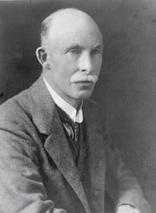

Fired up by his successful campaign to protect the flora and fauna of Kāpiti island, and at the urging of prominent conservationists and scientists of the time, Captain Ernest “Val” Sanderson founded the Native Bird Protection Society at a public meeting in Wellington on 28 March 1923. The Society’s original objectives were to obtain “unity of control in all matters affecting wild life” and advocate for a bird day for schools. Sanderson’s friend and former Prime Minister Sir Thomas Mackenzie was elected President, and its first Vice-Presidents were newspaper owner Sir George Fenwick, Wellington College headmaster

JP Firth, and the renowned naturalist William Herbert Guthrie-Smith. An Executive was appointed to advise the new Society, made up of leaders in the fields of ornithology, entomology, agriculture, and forestry. All of them worked as volunteers. Annual membership was five shillings for adults and one shilling for school children. The first member was Arthur Leigh Hunt, a Wellington businessman, who was given receipt No 1. Important women supporters included Perrine Moncrieff (see page 45), Elizabeth Knox Gilmer, and Lily Daff. The society was renamed the Forest & Bird Protection Society of New Zealand in 1934. Sanderson
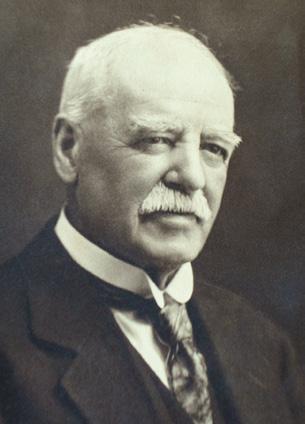
CENTENNIAL STORIES
Tūī painting circa 1933. Lily Daff
JP Firth Sir Thomas Mackenzie Sir George Fenwick WH Guthrie-Smith Perrine Moncrieff Lily Daff
| Forest & Bird Te Reo o te Taiao 30
Historian Lynnette Lochhead
was born in 1866 and attended Wellington College before serving his country in two wars and becoming a successful businessman. In 1893, he witnessed his older brother Louis shooting their abusive father William Spreat, who had attacked the pair with a knife and a poker. The matter was deemed “justifiable homicide” after Spreat exonerated Louis in a deathbed deposition to police. Founding the Society at 57, Sanderson dedicated the rest of his life to the cause of nature conservation. He was a gifted communicator and campaigner who spoke up passionately for the birds and bush until the day he died.
ISLAND OF DREAMS
May Kāpiti Island, one of the few remaining bird and bush resorts, prosper so that our children and children’s children may see and learn something of our once wonderful birdlife.
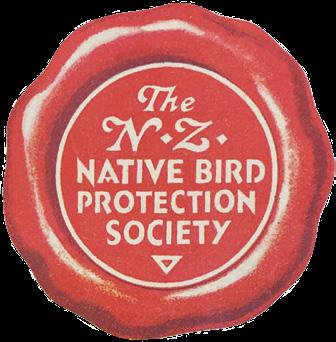 Val Sanderson, 1922
Val Sanderson, 1922
Sanderson’s conservation zeal was lit by a forestcloaked island north of Wellington rich in Māori and colonial heritage, an ancient place where moa and kākāpō once roamed. He knew Kāpiti Island well, having travelled there as a child, and deeply cherished its native birds. But, during a visit there in 1914, he was incensed to find the country’s oldest nature sanctuary falling apart.
He rattled off a series of letters to government ministers warning that he would get the press involved if the Internal Affairs Department didn’t act. Under pressure, the department agreed to have the goats and cats destroyed and to erect a fence to stop the sheep on private land at the north of the island wandering into the sanctuary. Sanderson then headed off to serve in the First World War believing the fight to have been won. But, in 1922, when he returned to Kāpiti to check on progress, he found the sanctuary in a mess.

He made a clandestine trip to the island because the government refused to give him the required permit, probably knowing he would be upset by what he found. Sanderson headed across in a boat from the mainland accompanied by a newspaper reporter and botanist. He was shocked to discover 3000 sheep and about 2000 goats had destroyed the undergrowth, and oppossums had devoured the kōtukutuku wild fuchsia trees and were devouring berries of all kinds. Sanderson saw red. He gave the government no peace until fences were erected, noxious animals destroyed, a qualified caretaker appointed, and countless trees and shrubs planted. This allowed the native habitat to recover, and, over time, Kāpiti became the glory that it is today. “I don’t know who this chap Sanderson is, but he’s not going to dictate to me,” said the Minster of Lands at the time. But Sanderson had friends in high places, including newspaper owner Sir George Fenwick, a founding member. Sanderson later said, “I was going to dictate to him because the Press was at my back.” From the 1920s, the irrascible conservationist was a regular visitor to Kāpiti Island, carrying out planting and pest control, sometimes staying overnight with his friends Utauta and Hona Webber, who farmed the northern end. During the 1930s, Sanderson made a conservation film called Glimpses of Nature on the island featuring the Webber family feeding native birds. Sanderson died in 1945, aged 79, and is buried at Ōtaki Cemetery, overlooking his beloved Kāpiti Island.
MILITARY SERVICE
A remarkable New Zealander, Captain Ernest Valentine ‘Val’ Sanderson emerged from two wars to become a leading figure in the fight to protect New Zealand’s natural heritage. Online Cenotaph, Auckland Museum
Sanderson first served in the South African War (1899–1902), where he excelled as a Quartermaster-Sergeant for the No 12 Company (Wellington section), 5th contingent, New Zealand Mounted Rifles. At the outbreak of the First World War in 1914, Sanderson was 48 and too old to enlist. So he pretended to be five years younger so he could serve his country for a second time. After a number of applications, he was finally accepted and sent to Egypt. There he served as a Quartermaster and Honorary Captain, and was invalided home. His command and organisational abilities were to become invaluable after the war as he went into battle to save New Zealand’s fast disappearing forests and birds.

→
31 Autumn 2023 |
Sanderson planting natives on Kāpiti Island. The John Barrett archives
PAEKĀKĀRIKI LIFE
The late Captain E.V. Sanderson – Val to his family and friends – was one of New Zealand’s outstanding men; for he perhaps more than anyone else aroused our awareness of the danger to our priceless heritage of birds, trees, and soil. Paekakariki Graphic News, 1973
In the 1920s, Sanderson moved to Pingau Street, Paekākāriki, living there until his death. He married his second wife Nellie and fathered two daughters, Nancy and Ruth, in his 70s. The family lived in a modest house on the dunes overlooking Kāpiti Island. From his home, he carried out much of Forest & Bird’s administrative work, hammering out a stream of letters and articles on his typewriter before posting them to government ministers, newspaper editors, and members. Sanderson would reportedly cart hundreds of Forest & Bird magazines in a wheelbarrow to the local Post Office, which “had to be upgraded from Postmistress to Postmaster” such was the load placed on postal authorities. Sanderson planted hundreds of native trees on the dry barren sandy soils of his Paekākāriki home, transforming it into a small patch of native bush with 70 different species of plants. Within 10 years, it had grown 5m high, an effort considered by some “to be little short of a biological wonder”. Sanderson’s forest garden is still thriving today, and his old home remains almost unchanged since the 1940s. Sanderson fed native birds that came to his garden with home-made bird feeders. He trapped for rats using a modified weighted iron trap and constructed an irrigation system to water his trees. He built red-spotted concrete mushrooms so visitors could sit and listen to the birds, and designed and constructed a Māori pātaka entrance gate to his property. He was known to heliograph across to the Kāpiti caretaker about the birds he saw

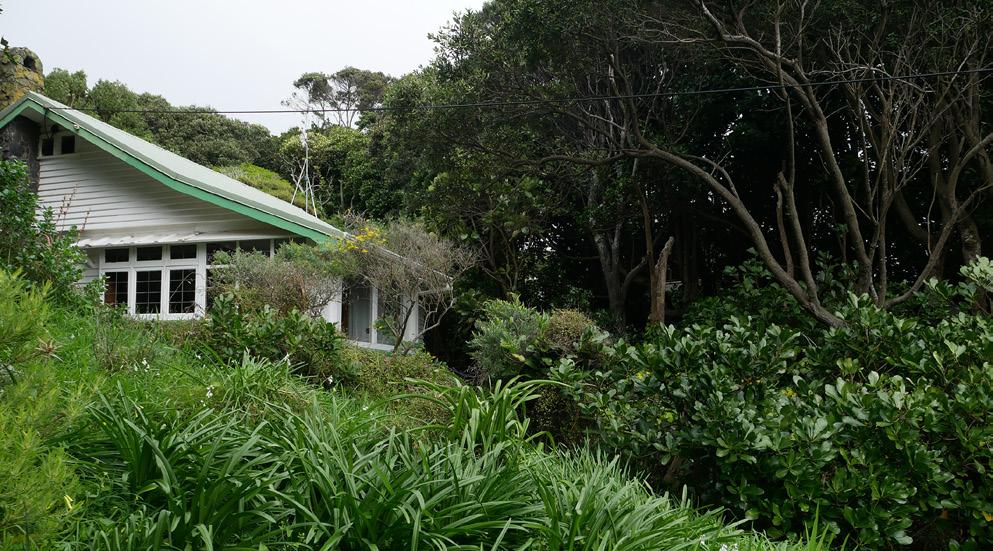
flying from the island across his land. In 1938, Sanderson was appointed honorary supervisor of the AT Clarke Reserve, a conservation area on Paekākāriki Hill overlooking the village. Later this year, the local community will unveil a tribute to Sanderson and his life’s work, naming part of the newly restored Waikākāriki Wetland in the village after Forest & Bird’s founder.
LODER CUP
He was a man of experience and hard knocks – in fact a man of steel – but the idealist side of his nature found fruitful expression in his single-minded devotion to the sacred cause of preserving what is left of the flora and fauna of Old New Zealand. EV Sanderson obituary, Evening Post, 1945
The Loder Cup is one of New Zealand’s oldest conservation awards. It acknowledges individuals and groups who make an outstanding contribution to conserving the native plants of Aotearoa. In 1938, Forest & Bird’s Executive resolved to nominate Sanderson for the award, but he expressed reluctance and the matter was dropped. Then, in 1944, Sanderson was nominated by members of the Royal New Zealand Institute for Horticulture, who said he had made a considerable contribution in founding and leading the Society, including editing 74 issues of its journal. The citation also mentioned his efforts to protect Kāpiti Island from the menace of goats and other mammals, and raising the problems of soil erosion. However, on learning he was being nominated, the ever-modest Sanderson let it be known he would refuse to accept. Sanderson died the following year, and the 1946 Loder Cup was awarded to the Forest & Bird Protection Society, in “perpetual memory” of Ernest “Val” Sanderson. It was a fitting tribute to a man who had dedicated the final two decades of his life to the cause of nature preservation.



CENTENNIAL STORIES →
Sanderson’s home in Paekākāriki. Caroline Wood
Val Sanderson
The entrance to Sanderson's Paekākāriki garden. Caroline Wood
| Forest & Bird Te Reo o te Taiao 32
Sanderson’s rat trap. Courtesy of Justin Jordan
CHERISH OUR HERITAGE
During the Sanderson years (1923–1945), the Society focused on a range of conservation issues, including wild bird poaching, gazetting new nature sanctuaries, stronger wildlife laws, forest protection, and the control of “noxious animals”.

In 1925, Sanderson was warned by an eminent New Zealander living in the United States that an expedition was being formed to collect vast numbers of birds from Aotearoa. His informant told him the view at the Museum of Comparative Zoology at Harvard was that New Zealand’s indigenous birds were “doomed” and every attempt should be made to collect more while there was still time. A few months later, Sanderson discovered a Mr France was visiting from America to observe our bird life. He suspected the birds would be “observed” over the sights of a shotgun. Firing off a letter to the Department of Internal Affairs, he discovered a permit had been issued in December 1925 for 846 New Zealand wild birds to be taken without supervision. The list included six Chatham Island
snipe, four Snares Island robins, and two Auckland Island ducks. Some species on the list had just 10 or 20 individuals left on Earth. After a strong protest by the Society, with Sanderson working day and night on the problem, the Minister sent an observer – the same New Zealand official who had advised him to issue the permit! But, as a result of the Society’s advocacy, a bigger battle was won. Early in 1926, the Minister agreed that “no collecting whatsoever would be permitted in sanctuaries, scenic reserves, and domains”. Permits would only be given to museums, and all foreign collectors would be accompanied by a government officer “experienced in bird matters and his expenses borne by the collector”. It was one of the Society’s earliest “wins”. Meanwhile, also in 1925, Sanderson was trying to persuade the government to designate the sub-Antarctic Auckland Islands a bird sanctuary. His first attempt, in 1925, failed because there was a £40-a-year grazing lease with seven years still to run. But he didn’t give up and carried on bombarding the government with letters. “Should the natural beauties of the islands be damaged or destroyed, it would arise indignation in all civilised lands,” Sanderson wrote in one of his letters. He sent scientific information about the islands’ unique flora and fauna gathered by the eminent botanist and Forest & Bird Vice-President Dr Leonard Cockayne. The Auckland Islands were gazetted a reserve in 1934.
SAVING SADDLEBACK
In November 1925, Sanderson set off on an expedition to Hen Island, east of Waipu on the Northland coast, helping Forest & Bird stalwart Harold Hamilton, from the Dominion Museum, catch tīeke North Island saddlebacks. The caretaker of Kāpiti Island, Stan Wilkinson, joined them. They captured 18 tīeke and took some over to Little Barrier, where they liberated them. The rest were taken to Kāpiti Island and freed there. We’ve found evidence that Sanderson made arrangements with the station masters all the way back to Paraparaumu, via Whangārei, Auckland, and Palmerston North, to make sure
 “The light he abhors but rarely meets” Anti-poaching cartoon commissioned by Forest & Bird, published May 1938. Marmaduke Matthews
“The light he abhors but rarely meets” Anti-poaching cartoon commissioned by Forest & Bird, published May 1938. Marmaduke Matthews
33 Autumn 2023 |
Tīeke saddleback, circa 1933. Lily Daff
the birds were safely transported to their new home! In 1930, ornithologist Bob Stidolph reported that the saddlebacks were thriving on Kāpiti Island. Sanderson saw New Zealand’s offshore islands as essential refuges for species at risk of extinction, although he would later argue against the practice of moving birds around the country. In the 1920s, the loss of huia in 1907 was still keenly felt among conservationists. In fact, Sanderson would drop everything to lead expeditions into the bush to investigate reported huia sightings, as he did in February 1924, when he travelled to Akatarawa River, north of Wellington, but to no avail.

DEER MENACE
From 1923, the Society promoted science-based ideas and conservation solutions ahead of its time, including raising awareness of the damage “noxious animals” – introduced deer, goats, possums, cats, rats, and stoats – were making to native forests. Sanderson, together with Leonard Cockayne and soil scientist Lance McCaskill (Vice-President, 1932), made it their mission to educate the public about what they called the “deer menace”. In 1930, the Society’s advocacy led to the government organising a Deer Conference in Christchurch on

the impact of browsing mammals. Sanderson and Cockayne attended along with other interested groups and several government departments. McCaskill sent two representatives from the Society’s Otago section. The government agreed the animals were pests and pledged “war on deer” at the conference. Ministers removed regulations that had up to this point protected browsing mammals and allowed free year-round shooting of deer, chamois, and tahr. It was another early win for the Society, which would continue to raise awareness of the impact of introduced pests. In 1935, the Forest & Bird Protection Society wrote to every general election candidate in the country asking them to stop forest destruction in watersheds, saying it led to erosion, flooding, and poor water quality. In the same letter, Sanderson also called for an extension of the government’s campaign against deer, pointing out the Department of Internal Affairs’ 9000 target was less than 5% of the annual natural increase of the pests that were ruining native forests. “Is New Zealand for deer or for mankind?” he asked.
GODWIT SHOOTING
During the 1930s, Sanderson’s Society lobbied the government and acclimatisation societies, which issued shooting permits, for an end to wild duck hunting and for absolute legal protection for kuaka bar-tailed godwits. At the time, it was still legal to shoot native ducks, including parera grey teal and pāpango black teal, as well as kuaka godwits and other visiting shorebirds. Sanderson published articles in Forest & Bird’s magazine about the long-distance flyers and called for godwits to be added to the list of absolutely protected birds and for Pārengarenga Harbour, in Northland, to become a godwit sanctuary. In an letter to the Minister of Internal Affairs in 1933, Sanderson said hunters were concentrating on certain species and extinction would result. “Ducks were rapidly disappearing and godwits would follow,” he wrote. The Minister refused to fully protect godwits from the gun but agreed to a shorter season, in 10 locations, with a bag limit of 20 a day. Sanderson said this didn’t go far enough. “The slaughter of godwits is really a disgrace to New Zealand,” he commented. After a prolonged campaign by the Society and others, kuaka finally received absolute protection in 1941. William Parry, the Minister of Internal Affairs, announced the move in December 1940, saying it was proposed “as a Centennial gesture, to place the godwit on the protective list”.


CENTENNIAL STORIES
Leonard Cockayne (left) with Harry Ell MP, another well-known early New Zealand conservationist. Forest & BIrd Archives
A godwit hunter in the 1930s.
A Lost Harmony (Huia). Hannah Shand
| Forest & Bird Te Reo o te Taiao 34
The journal was used to advocate for godwit protections. Lily Daff, August 1936
BIRD LIMING PETITION
In 1935, Forest & Bird organised a petition signed by 8000 New Zealanders calling for an end to the horrific practice of bird liming. At the time, poachers and collectors were putting the sticky substance on branches to capture live birds so they could be sold to private bird collectors. The petition was presented to Parliament by a group of Society members, including Elizabeth Knox Gilmer (pictured), the seventh daughter of former Prime Minister Richard Seddon, who helped collect signatures. She was an active member of the Society and became a VicePresident in 1934. As well as an end to bird liming, the petition called for the abolition of wild bird trafficking. Mr Field, the MP who presented the petition, spoke in favour of it and pointed to the great cruelty inflicted by the liming and the loss to bird life. Several other MPs spoke in support. The government’s Bird Lime Regulations were passed in 1936 and 1937, prohibiting the possession of bird lime or using it to capture birds.
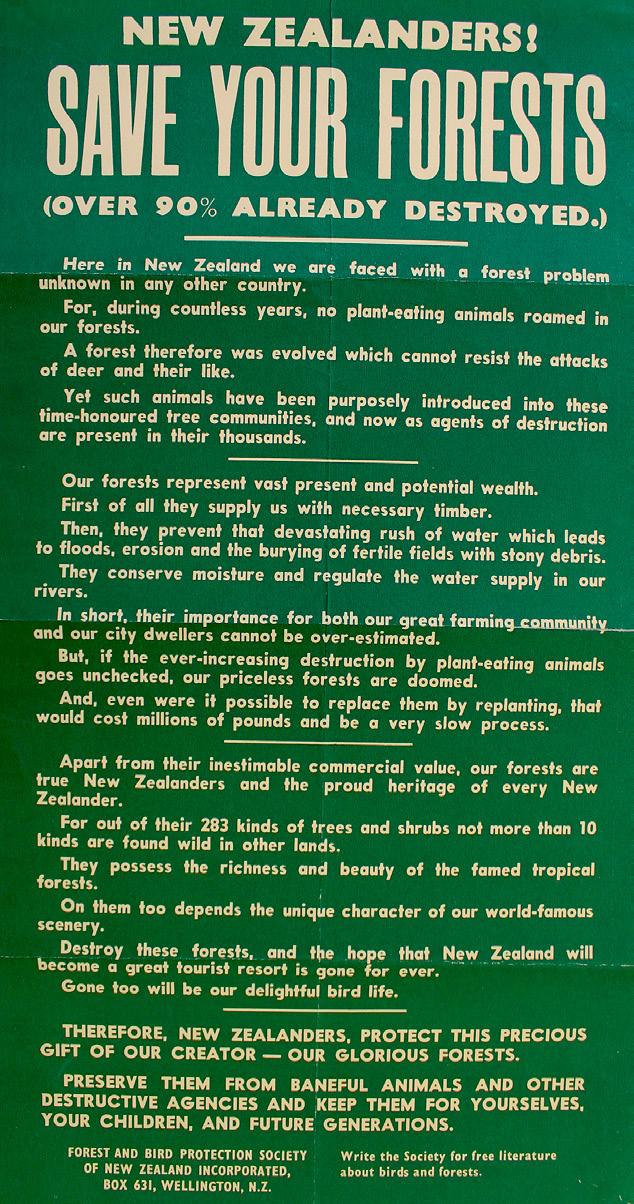
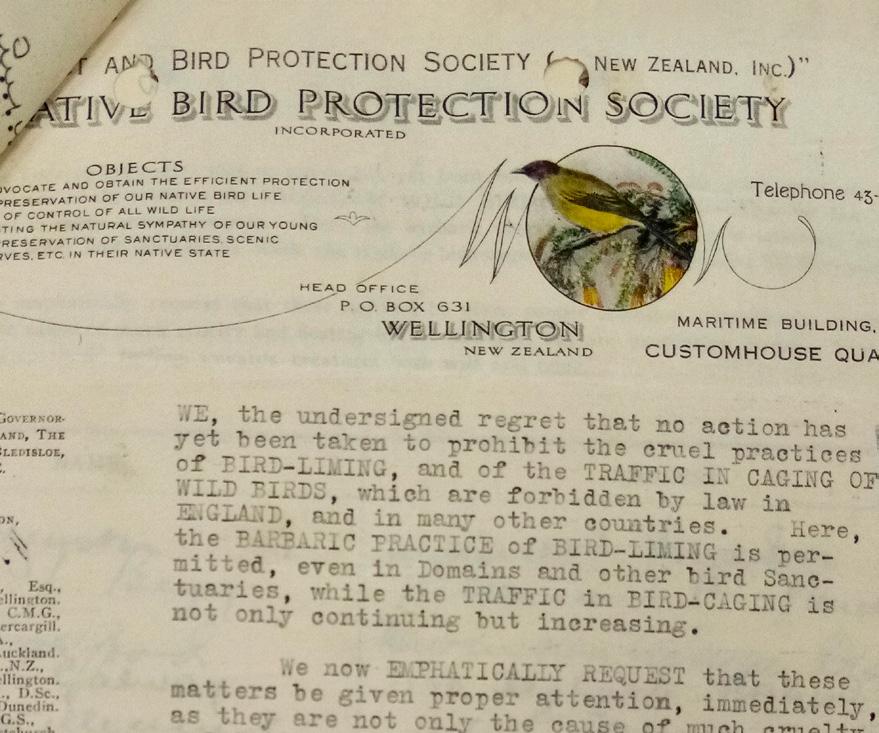
INTO THE REGIONS
In September 1923, Dr David Bathgate, of Turua, Hawke’s Bay, wrote to Sanderson enclosing a donation for £1, saying: “Many thanks for your various pamphlets and letters which I have received and read with interest. Your

society is one with fine ideals and praiseworthy objects ... I hope to see branches formed all over the Dominion, especially among the children and their teachers.” Sanderson initially resisted the idea of setting up branches but was keen to appoint official regional representatives to advocate for nature in their local areas. One of the first appointments was Mr JB Speed, who became the Society’s Auckland representative in 1924. The first known Forest & Bird branch was established in 1928 in Raetihi by Tom Shout but didn’t last long. Then, in 1930, Sanderson arranged for meetings in Dunedin and Invercargill to form the Otago and Southland branches. They both closed within a few years, possibly casualties of the Great Depression, only to re-emerge as branches two decades later. In 1934, the Society’s magazine started publishing the names of its regional representatives: Bernard Sladden, in the Bay of Plenty, WW Smith, in Taranaki, Perrine Moncrieff, in Nelson, Leonard McCaskill, in
Canterbury, George C Thomson, in Otago, and JB Thomson, in Southland. After World War Two, branches and sections started popping up all over the country. The Canterbury section was first in 1946, followed by Auckland and Gisborne sections in 1947. The 1950s saw branches established in Dunedin, Wellington, Waikato, Tauranga, Whanganui, Tarankai, Hastings-Havelock, Napier, Whakatane, Rotorua, Manawatū, Northland, and Timaru. More branches and sections sprang up in the 1960s and 1970s.
UNITY OF CONTROL
In 1923, Sanderson’s primary objective was to secure “unity of control” of all wildlife. He believed having a single agency in charge of nature protection was the most effective way to protect the birds and bush. Nearly 45 years later, his dream came true following a campaign by a group of e-NGOs, including Forest & Bird. The Department of Conservation – a world first – was established in 1987, with one-third of the New Zealand’s land put into the public conservation estate. It was an incredible achievement and one that Sanderson would have warmly welcomed, although he probably would have said it wasn’t enough!
These stories could not have been told without the assistance of the Alexander Turnbull Library, Archives New Zealand, and many regional museums and local archives. We are also grateful to the Stout Trust for their support of Forest & Bird’s Force of Nature history project.
IN FUTURE ISSUES: New Zealand’s unsung women heroes of conservation • The importance of children in Forest & Bird’s history • Saving kea: from bounty kills to bountiful love • The power of publicity: how early Forest & Birders inspired a nation to love nature.
35 Autumn 2023 |
This 1929 Forest & Bird poster was displayed at tram and railway stations.
Back from
THE BRINK
Forest & Bird’s Ashburton Branch worked with scientists and landowners for more than a decade to save a new species of Canterbury
Mary Ralston
Two wire cages face the Pacific Ocean at Wakanui, coastal Canterbury. Inside are the last naturally occurring individuals of a small endemic daisy known locally as the Wakanui Craspedia.
There is no hope for these two plants. They will not produce any offspring, and in any case their growing site is doomed by the crumbling coastline.
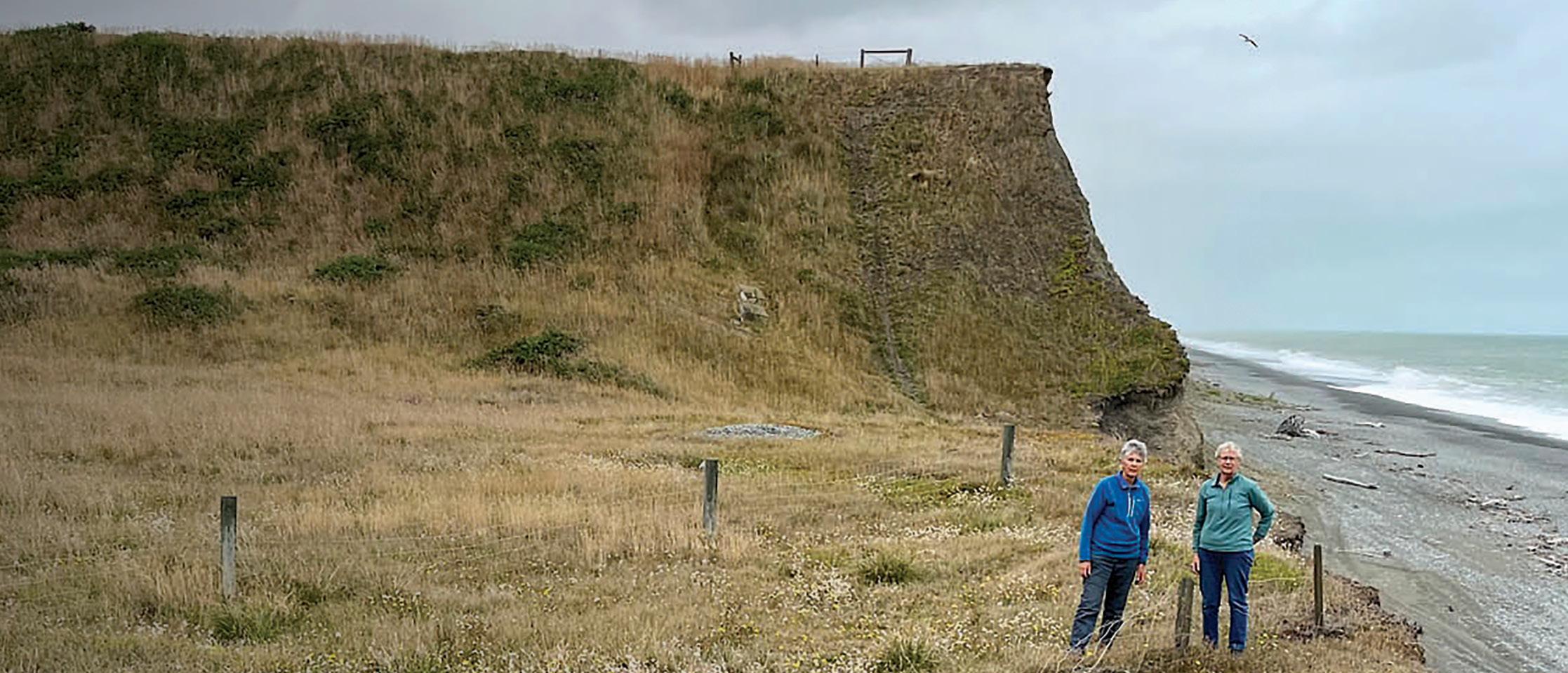
Luckily, this isn’t the end of the road for the species, thanks to a small group of conservationists, scientists, and landowners who were determined to save it from extinction.
They managed to propagate the plant so it could be safely translocated to four new locations, where it is safely growing today.
And, in an exciting development last year, the Wakanui Craspedia was confirmed to be a new species and given the name Craspedia diversicolor.
The rosette-forming perennial daisy, also known as puatea or woollyhead, is one of the fragments of native biodiversity of the Canterbury Plains.
In the 1960s, the species was known from four sites on
the Canterbury Plains, including a healthy population at Wakanui, east of Ashburton.
It was probably once widespread in open habitat, but it couldn’t compete against cultivation, vigorous introduced grasses, grazing mammals, and fire.
Over the following decades, the plants at the other sites disappeared, leaving just the ones at Wakanui.
In 2001, plant systematists Dr Ilse Breitwieser and Kerry Ford of Manaaki Whenua –Landcare Research, in Lincoln, visited the Wakanui site and counted 30 plants.
Numbers fluctuated over the next 10 years, but the trend was going the wrong way. Things were looking bleak for this little daisy.
In 2011, Ashburton Forest & Bird members Val Clemens and Edith Smith were alerted to the dire situation by QEII botanist Alice Shanks.
They began monitoring the Wakanui plants, walking along the beach and clambering up the bank to the site.
“When we first got involved, there were only four plants. Two that were closer to the sea disappeared one winter, leaving just two higher up the slope,” says Val.
“At that point, it may have been New Zealand’s most endangered plant species.”

The crisis was recognised and a rescue mission began. The landowner built cages to protect the plants from grazing. Seed was collected from the two remaining specimens, but it wasn’t viable.
The plants may flower at different times, and the tiny hoverflies that pollinate the flowers may struggle with the conditions.
It’s a fairly extreme site that is usually windy, often salty, hot and dry in summer, and cold and bleak in winter.
The surrounding native vegetation – flax, tussocks, matagouri, coprosomas, and other shrubs – that would have buffered the Craspedia and provided habitat for insects is no longer there.
Fortunately, Ilse and Kerry had collected a plant in
Val Clemens (left) and Edith Smith near the site of the last two naturally occurring Craspedia plants at Wakanui. Peter Smith
At one point, the Wakanui Craspedia was possibly the rarest plant in Aotearoa.
daisy.
| Forest & Bird Te Reo o te Taiao 36
FOCUS ON FLORA
Scientists recently described the Wakanui plants as a new species Craspedia diversicolor. Rainer Vogt
2001 and grown it at Manaaki Whenua’s experimental nursery at Lincoln, south of Christchurch.
In 2020, pollen was collected from the Wakanui specimens and taken to Lincoln for crossing, and vice versa. This was a mission in itself – pollen is only viable for a few hours, so there was an urgency to the drive from Lincoln and walk along the beach.
But it worked – seed was produced, and Manaaki Whenua nurseryman David Purcell raised 80 seedlings in the greenhouse.

In 2021, some of the seedlings were planted at a scientific reserve managed by the Ashburton Forest & Bird Branch, and others at a private reserve, Christchurch Botanic Gardens, and Manaaki Whenua’s Lincoln site.
“The good thing is that, if you can get them to cross, they may produce hundreds of seeds,” says Ilse.
Now there are more than 50 plants at four sites, as well as the original two, so the immediate crisis has been averted.
But it’s still a very small population, and there’s a risk the species is vulnerable because of the loss of genetic variation.
There’s also the risk of losing remaining individuals through fire, grass grub, or inadequate site conditions.
The situation is a bit like an intensive care unit – the plants need active management: they need to be weeded, protected from the elements, and watered when it’s dry.
The struggle to save a species has been won for now, but the habitat and the ecosystem it belonged to have been lost. Managed reserves are the best we can do.
“The continued commitment and expertise of Val and Edith has been amazing,” adds Ilse.
“We wouldn’t have saved the species without them. It’s been a great collaboration between volunteers, the scientific and conservation management communities, and landowners.”
Historic herbarium specimens suggest Craspedia diversicolor was once a common dryland species. A beautiful album of pressed flowers given by William Piercy to his wife in 1884 contains a Craspedia with dark red-purple anthers that he collected from Lincoln cemetery. Another specimen collected near Ashburton in 1918 also has the same coloured anthers and the leaf characteristics of Craspedia diversicolor. It was found close to one of the reserves where its propagated modern-day cousins are growing today, more than 100 years later.

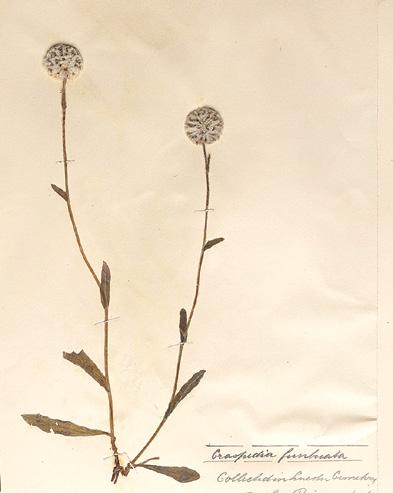
DAISY DISOVERIES
There are 11 known species of Craspedia in New Zealand, and it is thought there could be another 50 that are not yet named. Ilse Breitwieser and Kerry Ford recently described four new species with distinctive dark red-purple anthers, including Craspedia diversicolor. All four are threatened and only found at single locations – Wakanui, Lake Heron, Kaitorete Spit, and Pisa Flats. Breitwieser and collaborators are reviewing the Craspedia genus. They have grown more than 500 plants from all over New Zealand in a greenhouse to see whether morphological charateristics such as leaf colour, hair cover, and shape are genetically determined or influenced by environmental factors. “One of the key distinguishing characters of the Wakanui species is observable differences in leaf colour. That’s why we called it ‘diversicolor’,” says Ilse. Research by Ford and collaborators suggests Craspedia arrived from Australia, on the wind or carried by a bird, three million years ago. “This was quite a major finding,” adds Ilse. “It means our research could concentrate on the species in New Zealand, knowing they don’t also occur in Australia.”
37 Autumn 2023 |
The Piercy specimen was contained in an album presented to his wife in 1884.
Dr Ilse Breitwieser with Craspedia plants at Manaaki Whenua’s experimental nursery, Lincoln. Kim Triegaardt
FORESTRY SLASH
Forest & Bird was part of concerted efforts to pressure the government to hold an independent inquiry into forestry waste, following devastating storm damage across the North Island caused by exCyclone Hale and Cyclone Gabrielle.
Tonnes of logs, woody debris, and mud from poorly managed plantation pine forests came crashing down Tairāwhiti hillsides into rivers and the ocean.
A young Wellington boy was killed in late January after being struck by some of the forestry slash washed up on to Waikanae Beach, in Gisborne.
includes farmers and horticulturalists, Māori landowners, and conservationists, launched a local petition calling for a reduction in the amount of sediment and forestry slash entering waterways.
It says an independent inquiry would be a good way to move from the “blame game” to objectively identifying what has gone wrong and make the appropriate policy changes.
Erosion has disastrous effects on our coastal marine environment.
Locals called it an ecological and community disaster, and the Environmental Defence Society demanded an independent inquiry into forestry practices and the rules surrounding the disposal of woody waste.
Forest & Bird’s Gisborne Branch chair Grant Vincent said: “In recent years, the logs, slash, and mud from poorly managed plantation forests have caused a series of unmitigated ecological disasters in the Tairāwhiti region.
“I remember the first erosion/slash incident nearly 30 years ago, in the Wharerata hills area south of Gisborne. Since 2012, with fairly monotonous regularity, we have seen the problem spread across our wider district.

“It is by no means the only land use problem here in Tairāwhiti. There is still a big and ongoing problem with erosion on pastoral farmland washing out to sea. This has disastrous effects on our coastal marine environment.”
Local advocacy group Mana Taiao Tairāwhiti, which
“We are sick of seeing the carnage created by forestry slash in our awa and along the coast,” said spokesperson Hera Ngata-Gibson, who is based in Anaura Bay with whānau in Uawa.
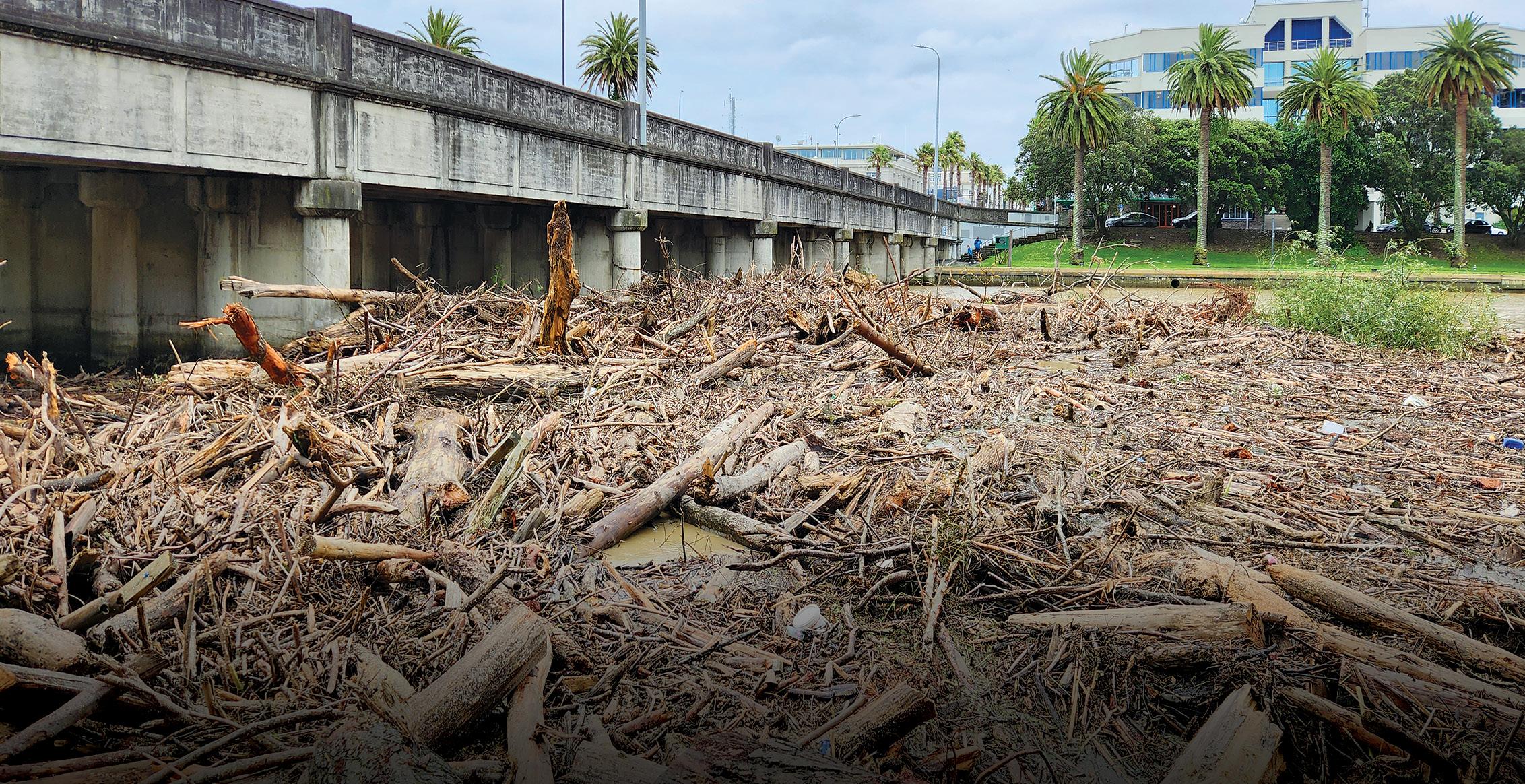
“What’s happening here in Te Tairāwhiti is an ecological disaster. It’s time we all hear and acknowledge what our environment is screaming at us. Enough is enough!
“We all have a part to play in sorting this huge issue. We must speak up and put the wellbeing of our whenua above all else. It’s critical for our own longevity and wellbeing in this place.”
Repeated devastation caused by forest slash must end. We need to find solutions to stop woody waste ending up in local waterways. Caroline Wood
Forest & Bird’s Grant Vincent
Forest & Bird’s Grant Vincent at Pamoa Forest, a former radiata pine forest being regenerated into native forest. Barry Foster
FORESTRY
| Forest & Bird Te Reo o te Taiao 38
Forestry debris washed down from hillsides ended up in local beaches and rivers. Gladstone Road Bridge, Waimata River, Gisborne. Barry Foster
STOP
The Environmental Defence Society, which led calls for an independent inquiry, said it was clear there had been a “serious failure of public policy”.
“The cycle of environmental damage caused by plantation forestry operations must stop,” said its CEO Gary Taylor. “It is time to rein in damaging planting and harvesting practices with a fundamental reset of the rules that govern the sector.”
“It’s shocking that lessons from the previous storms and flooding aren’t being learned,” said Nicola Toki, Forest & Bird’s chief executive.
Professor Euan Mason, of the University of Canterbury’s School of Forestry, called for a review of land use on the East Coast, including forest harvesting operations, slash movement, and erosion.
“Climate researchers report that cyclones are likely to increase in frequency and ferocity as the world warms, so we must re-examine our behaviour and respond appropriately, particularly on such fragile sites,” he said.
Forest & Bird’s Gisborne Branch secretary Barry Foster says all land users need to adopt best practices for keeping woody debris from waterways.
“Some forestry companies are not doing things like ensuring debris are removed from steep hillsides and
building slash catchers to prevent dead logs from entering waterways,” he said.
“While radiata pine slash is the major part of the problem, debris from other tree species from farms and native bush are found in waterways as well.”
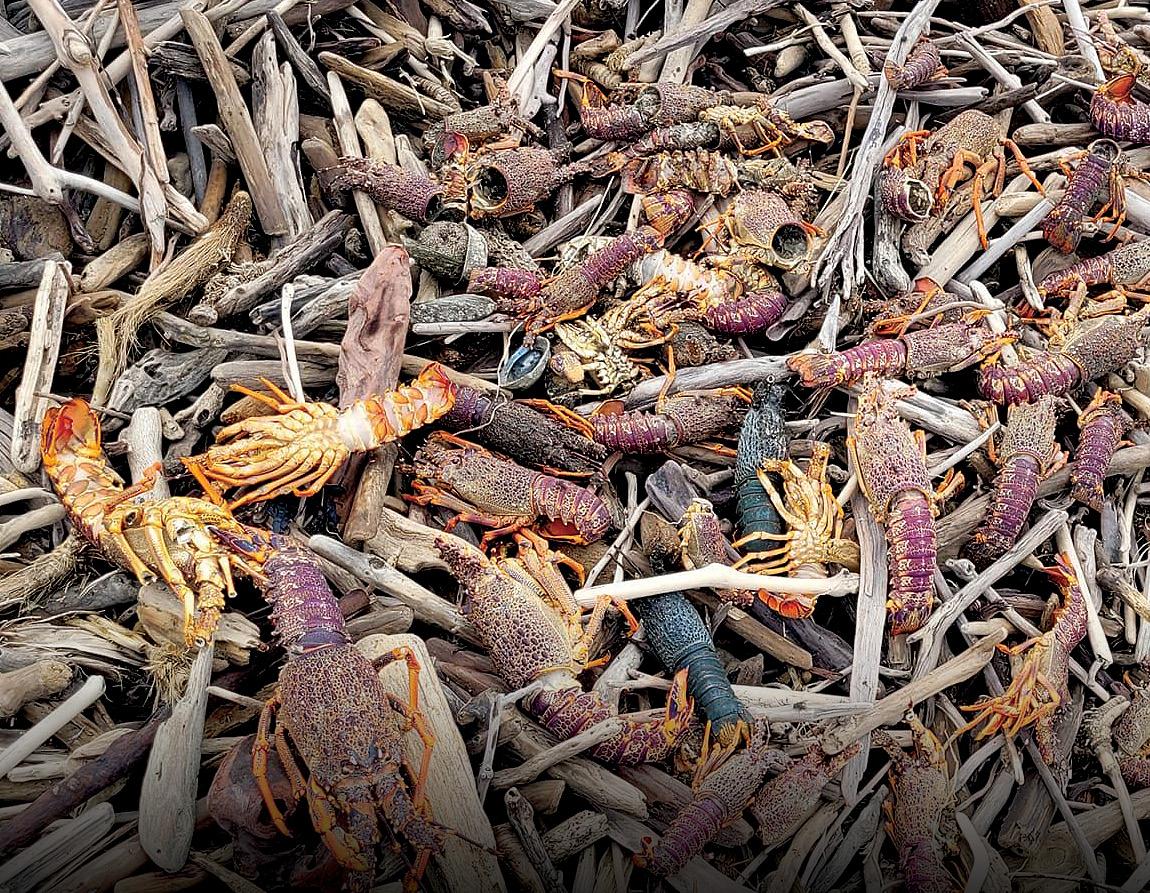
In February, the government announced a ministerial inquiry into forestry practice and slash. It will be led by former National Party minister Hekia Parata, who lives in Gisborne, along with former regional chief executive Bill Bayfield and forestry engineer Matthew McCloy.

Find a path to ethical investing
You want expert advice to help you reach your financial goals. You also want to invest ethically – supporting industries that enhance sustainability while avoiding those that damage the environment or society. At Ethical Investing NZ, we offer ongoing financial guidance from advisers who share your values. We’ve been recognised as the 2022 Mindful Money Best Ethical Financial Adviser. Now, let’s see what we can do for you.
Call 09 337 0997 or find out more at ethicalinvesting.nz
Crayfish and paua washed ashore after the January storm, Ruatoria/Waiapu, north of Gisborne. Graeme Atkins
Carew Falls track, Lake Brunner, South Island, Aotearoa 39 Autumn 2023 |
SHOREBIRD SANCTUARY
Our Golden Bay Branch wanted to restore a shorebird roosting site at Taupata, near Farewell Spit, then build a bird hide for visitors.
But first they needed to deal with a tricky local issue – Taupata was a designated freedom camping site, and campers were disturbing the birds.
for freedom camping, these birds quickly abandoned it,” explains branch chair Cynthia McConville.
“Freedom campers were creating disturbance, including lighting fires on the beach, playing frisbee, and kicking soccer balls.
“As a result, ground-nesting birds, including tōrea pango variable oystercatchers and tūturiwhatu banded dotterel, also abandoned the site.”
In March 2019, the branch launched a campaign to shut down the freedom camping site. It took nearly two years, but in December 2020 the council announced it would close.
freedom campers departed. Numbers there can be as high as 500 when the national migrants arrive.
As well as kuaka godwits, other Arctic migrants to Taupata include kohutapu sharp-tailed sandpiper, far eastern curlew, and huahu red knot. Kōtuku white heron and kōtuku ngutupapa royal spoonbill also visit.
Recently, the branch designed and installed a “Coastal Birds of Golden Bay” information panel so visitors could identify the species they were seeing.
Tasman District Council had decided to allow freedom camping at Taupata Reserve despite objections from Forest & Bird, the Department of Conservation, and the Ornithological Society of New Zealand. They all pointed out this was an important coastal bird hotspot.
“Once a roost for kuaka bar-tailed godwits, when the site opened up
Next, our Golden Bay Branch pressed ahead with their plans to develop Taupata as an ecofriendly destination for bird lovers. Local residents include terns, gulls, gannets, shags, herons, and penguins.
Branch volunteers restored the area, including planting native bush to shield the roost from human activity. Then, with community support, they built a bird hide, designed free of charge by Andy Clarke.
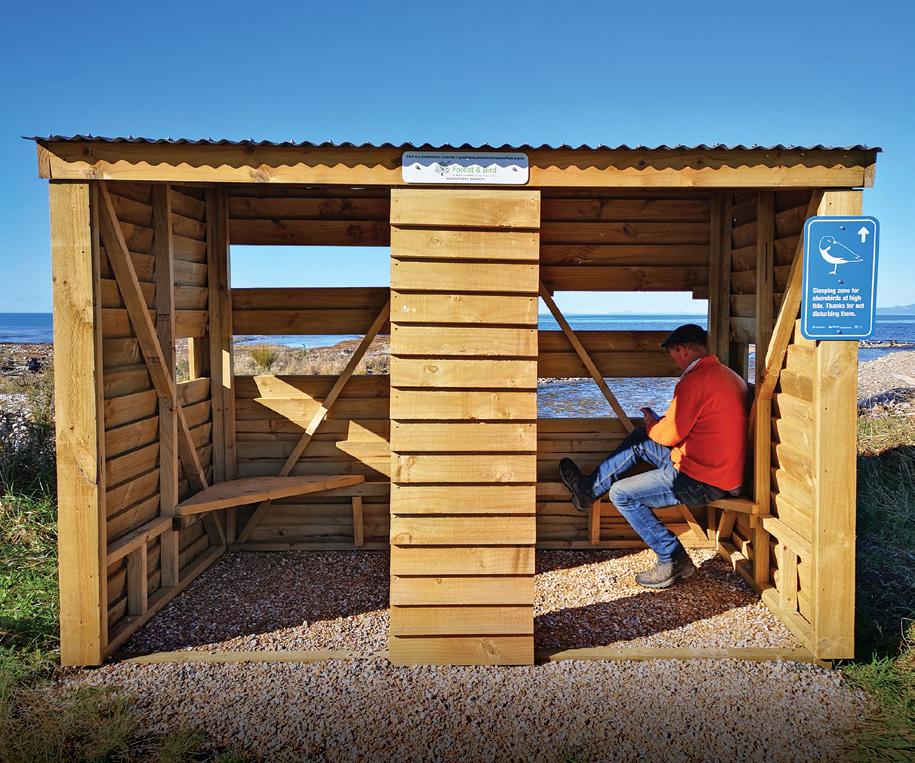
Now visitors could watch the birds that returned to the site once the
“The feedback has been really positive. Local and international visitors appreciate the opportunity the bird hide provides to get up close to so many different species of birds,” adds Cynthia.
“The branch is proud of what it has achieved at Taupata. We’ve restored a roosting site where the birds can rest undisturbed and provided an opportunity for people to come and learn about our coastal birds.”
The branch will carry on looking after the site, including weed control and additional planting to enhance the borders.
Golden Bay Branch welcomes new volunteers – contact goldenbay. branch@forestandbird.org.nz
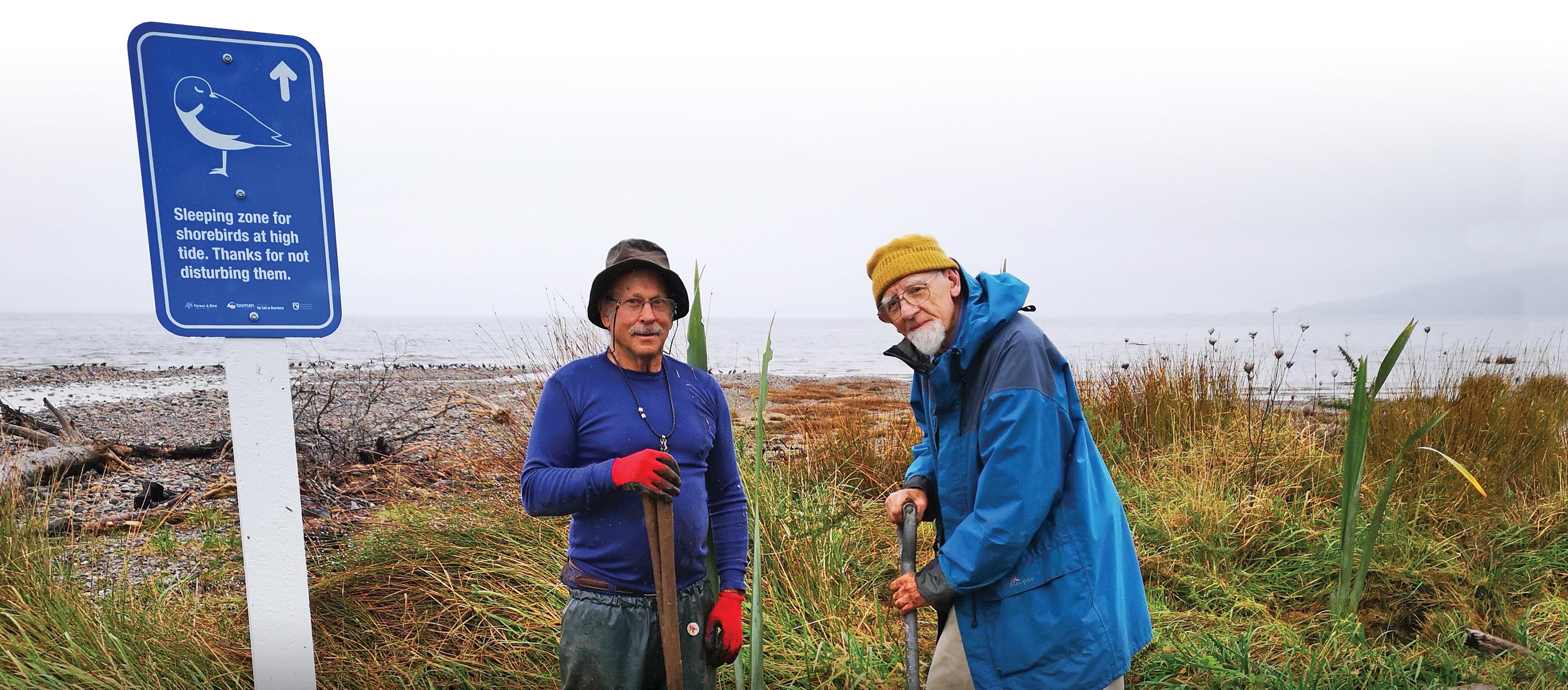
BRANCH PROJECT
A Forest & Bird branch planting day at Taupata. Cynthia Mc Conville
Golden Bay
Forest & Bird’s Golden Bay Branch recently completed a three-year project turning a freedom camping site into a safe haven for birds.
| Forest & Bird Te Reo o te Taiao 40 40
The new bird hide at Taupata. Cynthia McConville
RIGHT TO REPAIR
Products are becoming landfill far too quickly. We need a repairability label to force manufacturers to do better, says
Paul Smith, of Consumer NZ.

Last year, Consumer bought several brands of food mixers from different stores, created an easy to repair fault, and fitted a GPS tracker inside each one. We returned them to the stores and watched in horror as many travelled straight to the tip.

In New Zealand, millions of appliances and tech devices are needlessly being dumped. Each year, we throw out about 97,000 tonnes of unwanted or broken electrical waste – one of the highest per capita amounts on the planet.
And we have no rules or regulations to stop it heading to landfill.
Many of the products thrown away could be repaired and refurbished, but that’s too difficult for most companies. It’s more profitable to sell cheaply made products and replace them if they fail.

It’s us, as consumers, who pay the price for this waste while manufacturers and retailers reap the profits. We’re wasting money on products that fail too quickly and can’t be repaired.
It isn’t fair. We own the products we buy, and if something breaks it’s our right to choose to repair it. We’re more likely to get a product repaired if it’s cheap and easy to do so.
However, manufacturers don’t make it easy. They deploy tactics to steer us towards buying new things –they make spare parts scarce, expensive, or “out of stock”.

There’s no repair advice available, software locks mean official parts must be used by authorised repairers, and products are difficult to open – sometimes they’ve been glued or have odd-shaped fasteners that your screwdrivers don’t fit.
Meanwhile, companies are marketing new models as being “better” than your old one. The message is that repair isn’t worth it.
As consumers, it’s impossible to know which brands make products that will be more durable or easier to repair. In a recent mystery shop of well-known electrical retailers, we were given misleading or incorrect information about the durability and repairability of the electrical products we wanted to buy.
So we’re calling for a product repairability label in Aotearoa to support the global movement for a Right to Repair. Just like energy star ratings tell


you how efficient a product is to use, a repairability label tells you how easy a product is to repair.
The repairability score is based on whether repair instructions are available, how easy it is to take the product apart to repair it, and the availability and price of spare parts. It would be displayed next to the price, so we’d have an easy way to compare products.
We think introducing this kind of labelling will force manufacturers and retailers to lift their game.
New Zealand wouldn’t be the first in the world to roll this out – the French have already successfully rolled out a similar repairability label.
Sick of wasting money on products you can’t repair?
Let’s put the pressure back on manufacturers to do better. Show them you want products you can repair, and help Consumer demand a mandatory repairability label. Please sign the petition at https://campaigns.consumer. org.nz/right-to-repair.
OPINION
Autumn 2023 | 41
Unrepairable products cost you and the planet. Consumer NZ
SEASHORE TREASURES
We need to look after our special kōpūpūtai sea sponges sponges.
Sally Carson & Rod Morris
New Zealand sponges are like no others, with the vast majority being endemic. There are more than 700 species of kōpūpūtai found in our waters, not counting those that are yet to be described and named.
These unusual animals come in all colours of the rainbow, often have a spongy texture, and are among the most common invertebrates on the Aotearoa coast. Their body shapes are highly variable and influenced by the environment they are growing in. While waveexposed sponges tend to grow close to the rock surface,
species growing in sheltered, deeper water have a more upright growth form and tend to be bigger.
Sponges are animals without a head or tail, heart or stomach, or arms or legs. Instead, individual cells are specialised for specific functions, such as feeding, digestion, reproduction, and defence.
Described as sessile, sponges attach to rocks or other hard surfaces and cannot move around. As filter feeders, they have an amazing ability to circulate vast quantities of seawater. Like many other intertidal animals, sponges feed only at high tide.

The name for the sponge group, Porifera, means “pore-bearing”, because the surface of the sponge has small and large pores that are the inlets (ostia) and outlets (oscules) for circulating water and food particles through the sponge.
Specialised cells with a single whip-like structure called a flagellum line chambers in the sponge body. The unified beating of these flagella draws a current of water through the sponge for feeding and respiration. When food comes into contact with the cell surface, it becomes trapped.
How do soft, squishy sponges, with no shell, no appendages, and no means of escape survive the competition and predation pressures on the shoreline? Many sponges have tiny silica spicules (internal rods) that make them prickly and unpalatable. But the bright colour of many of these species might provide another clue: their main defence is a form of chemical warfare!
 This purple southern New Zealand sponge (Callyspongia stellata) has distinctive colouration, due to the presence of carotenoid pigments in the sponge cells.
This purple southern New Zealand sponge (Callyspongia stellata) has distinctive colouration, due to the presence of carotenoid pigments in the sponge cells.
MARINE
Rod Morris
| Forest & Bird Te Reo o te Taiao 42
Red encrusting sponge Crella incrustans Rod Morris
WIN

Chemicals, produced either naturally by sponges or by the fungi, bacteria and cyano-bacteria, are common in sponge tissues. They provide effective defence against predation by fish, and prevent invertebrate larvae, drifting in the water above, from settling on their surface.

These chemicals also provide defences against overgrowth by other encrusting organisms such as sea squirts, algae, bryozoans, and other sponges. Some of these chemicals are so effective they have potential commercial value as antifouling compounds for boats and other structures.

Scientists have also found that the chemicals produced by sponges have anti-bacterial and antifungal properties. These bioactive compounds show promise in the treatment of arthritis, heart disease, cancer, and AIDS, though farming of sponges and extraction of sufficient quantities of these chemicals have met with mixed success. Sponge cells that can change from one type to another, like stem cells, may also be useful in the study and treatment of disease and injury.
Although successful in a marine context, a sponge’s chemical and physical defences are usually no match for human curiosity and our lack of consideration for marine organisms. On the shore, we turn over boulders and leave them exposed to the sun and wind, leading to death for any sponges underneath. Sediment can clog up sponges’ feeding and respiratory systems, and some fishing practices destroy habitat and tear individual sponges apart.
The seashore environment is tough for any animal, and sponges are no exception. Few people understand that sponges are living animals that are critical to the health of the sea – raising awareness about these wonderful animals is something seashore explorers can do to help.

This is an edited extract from The New Zealand Seashore Guide by Sally Carson and Rod Morris. Published by Potton & Burton, RRP $49.99. Potton & Burton offers schools a 20% discount for all books. Order online at www.pottonandburton.co.nz and enter the code: SCHOOL

We have two copies of The New Zealand Seashore Guide to give away. To be in to win this beautifully illustrated book about our marine plants and animals, email your entry to draw@forestandbird.org.nz and put SPONGE in the subject line. Please include your name and address in the email. Or write your name and address on the back of an envelope and post to the SPONGE draw, Forest & Bird, PO Box 631, Wellington 6140. Entries close 1 May 2023.
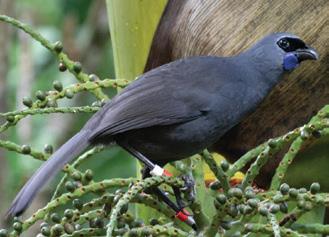
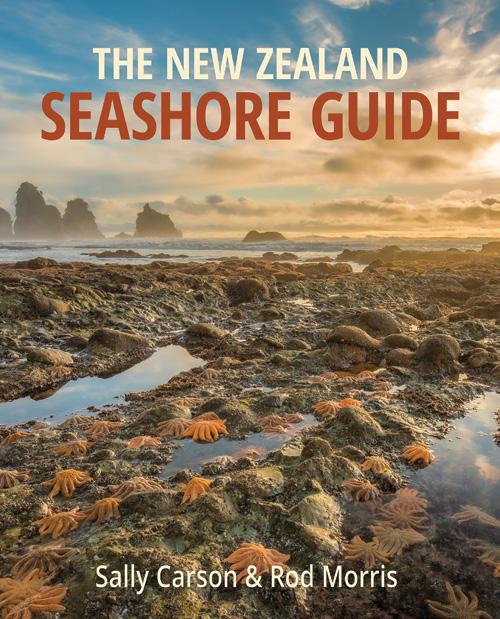
a copy of The New Zealand Seashore Guide
43 Autumn 2023 |
Rod Morris and Sally Carson. Rachel Anson
ROTOITI RESERVES Restoring
Forest & Bird is working with local iwi to restore the mana of Lake Rotoiti’s scenic reserves, its precious pōhutukawa, and weweia dabchicks.
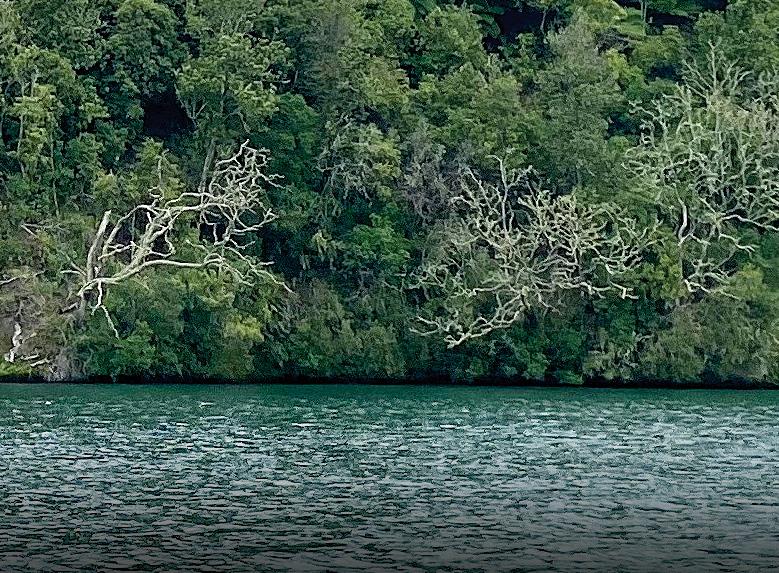
Ancient pōhutukawa are an important part of the scenic reserve network at Lake Rotoiti, north of Rotorua, but they are being browsed to death by possums.
The mauri of the reserves, which were gifted by Ngāti Pikiao to the Crown 100 years ago, is threatened by the possums’ destruction of these taonga trees.
Taiatini to develop a predator-free project to restore the reserves.
“We’ve got to look after our whenua,” said Ted Taiatini. “The most important thing is to nurture the forest, trees, and bush because these plants help our survival.”
The Bay of Plenty Regional Council stepped up to help, providing funding for more than half of the project’s costs and invaluable practical support.
Earlier this year, contractors working for Te Arawa Lakes Trust started removing the possums, who can each eat up to 3.5kg of vegetation a night and are particularly fond of pōhutukawa leaves.
Pest control will take place in three initial sites – Otaramarae Bay/Te Rerengaotemokai Point, Te Arero Bay, and Puketapu Honeymoon Bay.
gazetted as a public reserve for its scenic beauty in perpetuity. This was conditional on the establishment of a Board of control with five members of Ngāti Pikiao, a very early example of co-governance. The current members of the Lake Rotoiti Scenic Reserve Board are descendents of Ngāti Pikiao members who originally gifted the reserves.
Chairman Joe Tahana says the Board has worked with Crown entities since its inception to manage the reserves it administers. It is currently working with the Department of Conservation.
They are part of the special character of the lakeside and play a critical role in structurally protecting Ngāti Pikiao archaelogical sites, including food and burial caves.
Last year, Forest & Bird’s VicePresident Kate Graeme, a regular visitor, approached the Lake Rotoiti Scenic Reserve Board and explained possums were to blame for the dying pōhutukawa.
She worked with Lake Rotoiti Scenic Reserve Board member Ted
The Trust will also carry out rat and stoat control to help protect a nationally important population of weweia dabchicks. About 15% of the world’s 2000-strong weweia population lives on Lake Rotoiti.

“This project will protect the pōhutukawa and weweia, restore the mauri of the scenic reserves, and honour Ngāti Pikiao for its incredibly generous act in gifting the reserves a century ago,” said Kate Graeme.

In 1919, Ngāti Pikiao gifted the areas of lake-edge bush around Lake Rotoiti to the Crown. It was
“The Board is delighted to partner with Forest & Bird and use its expertise to develop a sustainable pest control programme to halt the decline of pōhutukawa within the reserves and to protect the wewei population around Lake Rotoiti,” he said.
Thank you to the Bay of Plenty Regional Council, Bay Trust, and Grumitt Sisters Trust for helping fund this project.
Lake Rotoiti Scenic Reserves Board members (from left) Keith Waaka, Ted Taiatini, Tawhiri Morehu, and Joe Tahana with Kate Graeme (middle). Fred Whata absent. Rotorua Daily Post/Laura Smith
BIODIVERSITY
Possum-ravaged trees on the edge of Lake Rotoiti. Kate Graeme
| Forest & Bird Te Reo o te Taiao 44
Weweia dabchicks. Roger Smith
A RARE BIRD
Actor and writer Elisabeth Easther has created a one-woman show celebrating the life and times of the indomitable Perrine Moncrieff.
Ornithologist, writer, and artist Perrine Moncrieff was a woman on a mission. Ahead of her time. A force of nature.
A conservationist before it was fashionable, Moncrieff was a pioneer in so many fields, but it was when she recognised the connection between birds, forests, and human survival that her efforts really took flight.

This realisation saw her do everything within her power to preserve habitats and species in the NelsonTasman region, including successfully campaigning for the establishment of Abel Tasman National Park in 1942.
She wrote the popular 1925 field guide New Zealand Birds and How To Identify Them and played a prominent role in Forest & Bird’s early history.
But, when Elisabeth Easther first stumbled across the writings of Moncrieff, she was astonished Perrine wasn’t better remembered.
To remedy that historical amnesia, Easther wrote a solo show that explores the audacious exploits of an extraordinary woman. A Rare Bird, directed by Kerryn Palmer, premiered at the Hamilton Arts Festival in March.
Elisabeth is planning to take A Rare Bird on tour performing in smaller venues close to nature. If you are interested in booking the show, please contact Bronwyn Bent at bronwynbent@gmail.com
ARBOR DAY SONG
So we must strive to save from wanton hand
This sacred forest, the beauty of our land.
Nelson conservationist Perrine Moncrieff (1893–1979) was a founder member of Forest & Bird and friend of its founder Val Sanderson. In 1927, she was appointed a Vice-President of the society, the first woman to hold the role.
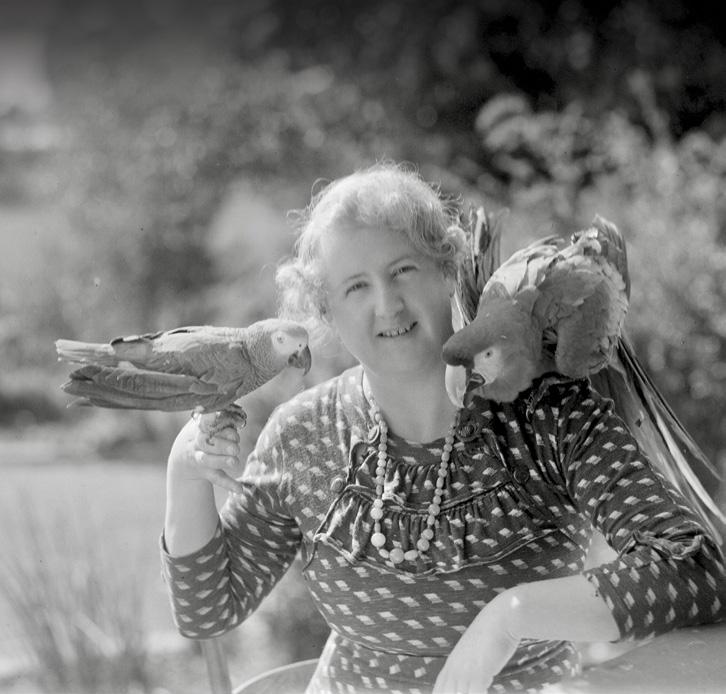
While researching her history with the Society, Forest & Bird’s researcher Michael Pringle discovered Moncrieff had written at least two musical compositions inspired by nature.
He found an undigitised musical score for the Arbor Day Song at Alexander Turnbull Library. It had been composed by Moncrieff in the early 1930s, with her teenage son Colin writing the lyrics.
The song was performed at Nelson College on Arbor Day, August 1935, with the girls giving it “a sweet and pleasing rendition,” according to the Nelson Evening Mail. Then the school children marched off to plant trees in the areas allotted them.
Moncrieff also wrote an orchestral symphony Dawn Chorus inspired by the sounds of the birds in the forest over the course of a morning. Unfortunately, we’ve been unable to find a copy of the original score.

Arbor Day is an American invention first marked in New Zealand in 1890 at Greytown and still celebrated in the Wairarapa village today.
From 1892 to 1914, government departments, service organisations, and schools observed Arbor Day every July or August. People took a day off work and schools to plant trees, mostly exotic species.
Arbor Day was revived in 1934, which is likely around the time Perrine composed her Arbor Day Song. Since 1977, Arbor Day has been celebrated in Aotearoa New Zealand on 5 June, with the emphasis on planting native trees.

CENTENNIAL STORIES
Elisabeth Easther as Perrine Moncrieff.
45 Autumn 2023 |
Perrine Moncrieff with her pet parrots. Nelson Provincial Museum
FALCON FAMILY
An intimate photographic portrait of a pair of karearea raising three chicks in an Otago forest. Andrew Martin
Driving through one of southern Otago’s many pine forests in early spring, I stopped my vehicle at a likely karearea nesting spot – tall mature pine trees next to recently clearfelled trees with large wood piles.
No sooner had I wound down the window than I heard the loud, distinctive kek kek kek of the female falcon coming from the direction of the large trees in the gully below.
Venturing down the gully a few hundred metres, I identified the nest site with three small chicks under some large overhanging branches and beat a hasty retreat.
On further visits, I concealed my presence in a hidden blind, sneaking in very early in the morning and often waiting many hours between feeding events with the falcons unaware of my presence.

This allowed observation of natural behaviour without adding stress to the nesting pair with their three rapidly growing chicks.
On one occasion, I was swooped by an adult bird with loud kekking from as far away as 300m, as I inadvertently approached a nest site while out tramping.
I have observed other species of falcon in Australia and elsewhere,
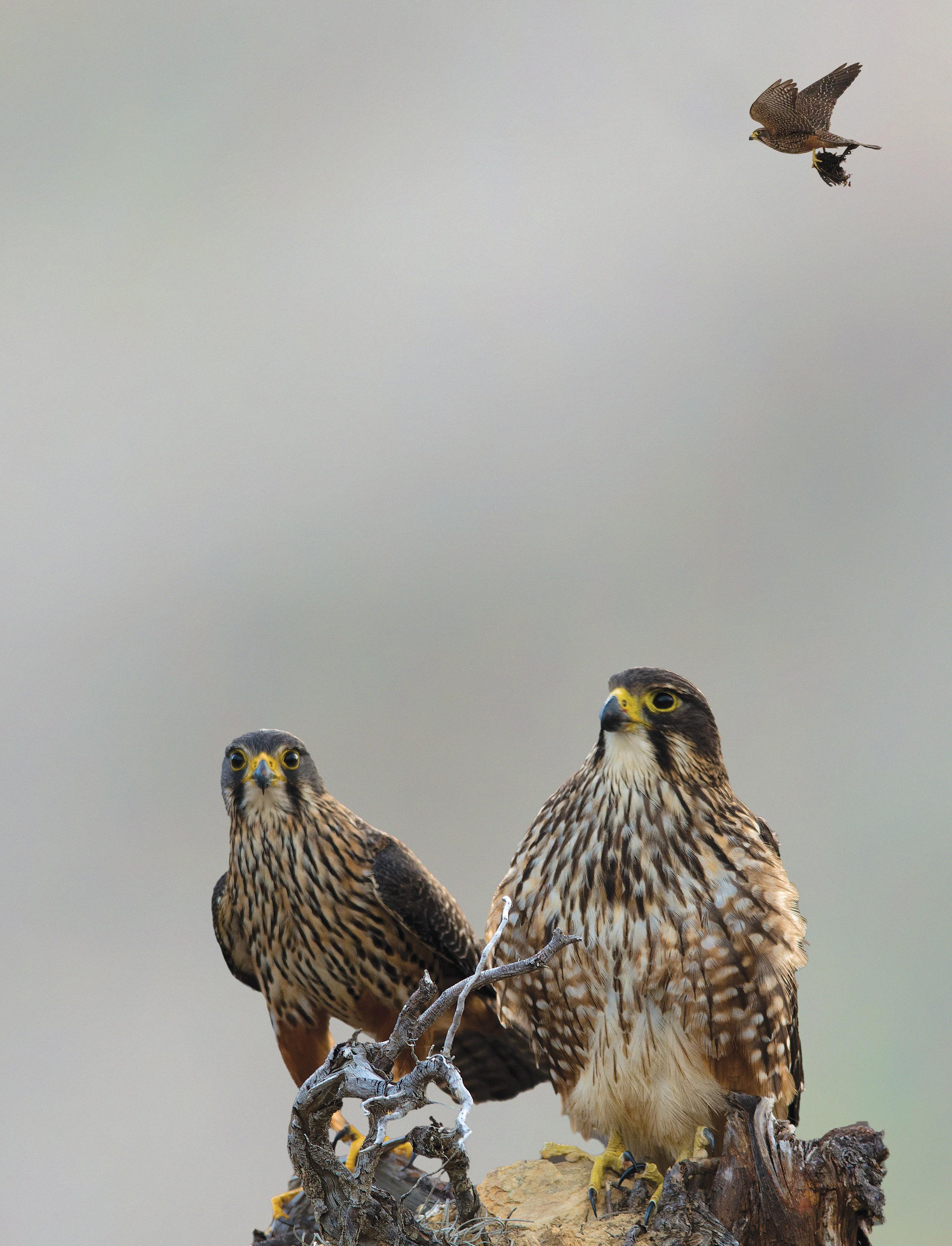
including the peregrine, notorious for its nesting ferocity, but these look tame in comparison to karearea.
In Otago during the early stages of nesting, the female was on guard at all times in the immediate vicinity of her chicks, sometimes on the wood pile and at other times scanning the horizon from the large pine trees nearby.
She was intermittently vocal and not infrequently on the move between several welldefined perching spots. By contrast, the chicks at this early
stage seemed quite listless, rarely venturing from the nesting scrape in the ground.
Mealtimes, by comparison, were always exciting events for everyone, including myself. All food was brought in by the small male. I always knew when he was coming as the female would make a soft whining noise, quite distinct from the loud, raucous kekking.

| Forest & Bird Te Reo o te Taiao 46
Chicks with parent on Day 25. Andrew Martin
BIODIVERSITY
The parents (male karearea are smaller than females). Andrew Martin
Very quickly, the chicks would join in with a distinctly softer whine that would rapidly escalate in excitement as the male got closer.
Sometimes, the male would directly feed the chicks himself, and at other times he would feed the female (much to the consternation of the little ones). She would fly off to partially eat the kill before sharing the remains with the chicks.
When they were younger, the chicks (two little males and one large female) all seemed to get at least a
bit of every feeding time.
But, as they started to grow, their behaviour in turn became more possessive, and the classic falcon “mantling” behaviour could be observed. This involves the bird spreading out its wings and covering its prey, hiding it from the eyes of its siblings.

On several occasions, I was privileged to watch a few aerial food passes between the male and female.

The chicks seemed to grow at a phenomenal pace. Close to fledging, things got a little comical as the young chicks, still unable to really fly, would hop up onto the branches of the woodpile, occasionally fall into the gaps, and somehow get themselves out and even make little runs on the ground close to the nest.
The down was rapidly falling off them to reveal their full juvenile feathers.
They fledged at about 40 days old and embarked on little flights back and forth across the gully.
Within two weeks, the chicks were gone, the adults had disappeared, and silence had returned. But I can confirm three healthy chicks fledged successfully. I hope they survived.
How ethical are your investments -
73% of New Zealanders want their money to be invested ethically, but most are concerned that they can’t access independent information or be confident that they aren’t being greenwashed.*

At Moneyworks, we cut through the greenwashing to provide independent analysis and education, to help our clients invest responsibly and sustainably. Our unique and proprietary process is thorough, transparent and personalised to you.


 Andrew Martin is an Australian raptorphile living in Aotearoa New Zealand.
Male chicks, Day 33. Andrew Martin
Andrew Martin is an Australian raptorphile living in Aotearoa New Zealand.
Male chicks, Day 33. Andrew Martin
Contact us at: 0800 225 621 or ethical@moneyworks.co.nz www.moneyworks.co.nz
Adult male landing. Andrew Martin
really?
Contact us to find out how our process would work for you to minimise the ‘nasties’ and add investments that are ‘doing good’. *Mindful Money & RIAA report April 2022
LET’S NOT FORGET MICE
House mice are omnivorous and are known to take advantage of whatever food sources become available to them, including invertebrates and lizards.
Wildlife will flourish once again if we eradicate possums, mustelids, and rats from Aotearoa, according to Predator Free 2050, the Crownowned company tasked with delivering this ambitious goal.
However, there is a furry roadblock in the way – the house mouse (Mus musculus). This small rodent can have a devastating impact on New Zealand nature but is not currently on PF2050’s species list for eradication.
Mice may look harmless, but they predate on birds’ eggs and can kill a seabird chick several times larger than themselves, as a Birdlife team working on the Mouse-free Marion Island project in the sub-Antarctic Indian Ocean discovered in 2015.
They documented mice eating the rumps and heads of defenceless seabird chicks while they were still alive. It could take up to four days for chicks on the island to die.


A study on the impact of mice on lizards at Mana Island, published by Donald Newman in 1994, showed that more than 20% of a mouse’s diet per month can be made up of native skinks.
When millions of mice were removed from Mana Island during 1989–91, in a project led by Forest & Bird stalwart the late Colin Ryder, populations of McGregor’s skink, the common gecko, and the Cook Strait giant wētā “increased significantly”.
Forest & Bird’s Tautuku Ecological Restoration Project manager Francesca Cunninghame says many threatened forest geckos found in the project’s area have missing digits on their feet and regrown tails.
“We believe these are the result of predator attacks from mice as the geckos jam themselves deep into crevices to try and get away, leaving only limbs exposed,” she said.
“But controlling mice in unfenced mainland areas such as Tautuku is currently an impossible challenge.”
Mice can also reduce the abundance of ground-dwelling insects, according to a five-year study published last year by Corinne Watts et al.
The team compared the abundance of grounddwelling insects in forest blocks with relatively high and low numbers of mice at Sanctuary Mountain Maungatautari, Waikato.
“We found strong evidence that mice reduced the abundance of ground-dwelling invertebrates, in particular caterpillars, spiders, wētā, and beetles, and reduced the mean body size of some taxa, the report concluded.
“Overall, there is substantial biodiversity gain from eradicating the full suite of pest mammals.
Tackling the country’s smallest introduced rodent is essential to protect nature.
Chelsea McGaw
PREDATOR-FREE NZ
A great shearwater chick being predated in its nest by a house mouse on Marion Island. Ben Dilley
These grey-headed albatross chicks did not survive the gruesome “scalping” inflicted by Marion Island’s mice. Ben Dilley
| Forest & Bird Te Reo o te Taiao 48
“We expect that mouse control tools will steadily improve so that in the future mice can be eradicated and excluded from forest reserves such as Maungatautari.”

But mice are not currently a priority for eradication. The government’s PF2050 efforts are focused on possums, stoats, ferrets, weasels, and Norway and ship rats.
The trouble is that once these dominant predators are removed, mouse populations can explode. A 2012 study at Tāwharanui Sanctuary north of Auckland found mouse densities were significantly higher after the exclusion of mustelids.
Some experts suggest we should deal with mice first as they are the food source of higher-ranking predators. Rats eat mice and hibernating hedgehogs, mustelids eat rats and mice, cats eat everything.
Internationally respected New Zealand ecologist Dr John Flux says: “Ecology teaches us we should remove mice first, then get rid of rats, weasels, stoats, ferrets, and cats in that order.” Forest & Bird’s view is that pest management is most effective when it employs a longterm, landscape-scale strategy as well as targeting individual species.
“Unless the full suite of predators, including mice, are targeted, our native birds, reptiles, and insects are in real trouble,” says Nicky Snoyink, of Forest & Bird’s pest free campaign team.



MOUSEY MOUNTAIN TO CLIMB
Forest & Bird’s frontline conservation projects face an uphill battle when it comes to controlling mice and protecting threatened birds, lizards, and insects.
On the steep cliffs of St Clair, Dunedin, mouse disturbance is thought to be stopping tītī wainui fairy prions laying eggs despite the fenced area being regularly controlled with toxin.
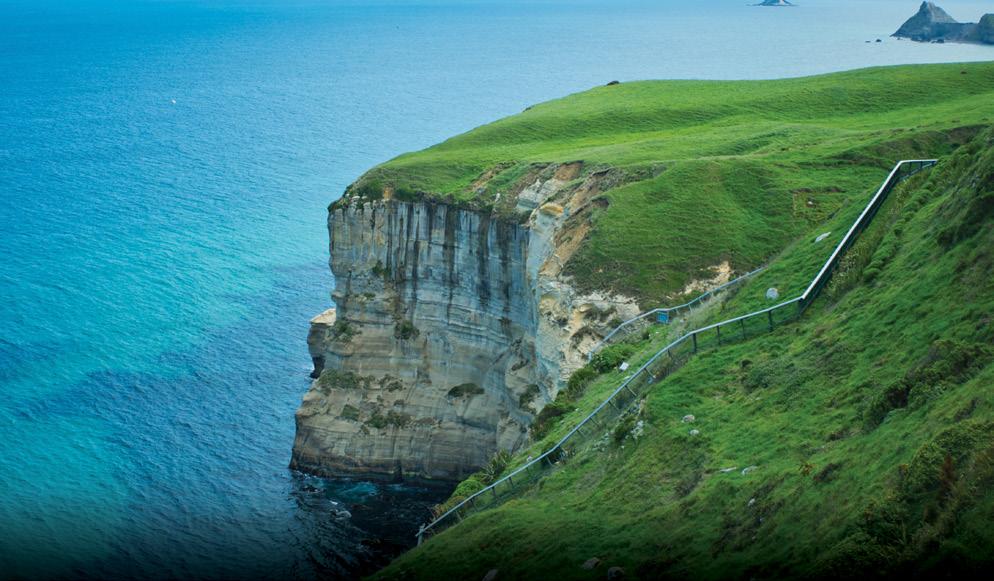
Last winter, project volunteers Graeme Loh and Sue Maturin built an experimental mouseproof nest box table to see whether it would encourage the birds to breed there this summer.
Meanwhile, at Bushy Park Tarapuruhi, a fenced sanctuary near Whanganui, Forest & Bird’s manager Mandy Brooke is constantly on mouse watch.
She uses tracking tunnels and mousedetecting dogs to identify an incursion and bait stations to knock them back to almost zero. Other fenced sanctuaries do the same.
At Tautuku, it’s thought that mice may be targeting the nests of titipounamu rifleman and the team is employing trail cameras to see if the rodents are visiting.
Forest & Bird is having ongoing discussions with Predator Free 2050 and will be asking them to consider including all introduced predators to ensure our wildlife truly does flourish.
Herpetologist Marieke Lettink has seen first-hand what mice do to native skinks caught in monitoring traps. She would like to see mice added to the PF2050 list for eradication.

“Unfortunately, we don’t yet have the tools to effectively control mice at landscape scale.,” she said. “Coming from a herpetologist’s perspective, I see mouse control as the final frontier in pest control in New Zealand.”



In a future issue: Chelsea looks at New Zealanders’ relationship with hedgehogs and asks why we find it hard to kill these prickly invaders. If you have any hedgehog stories or photos to share, please get in touch at editor@forestandbird.org.nz.

Tītī wainui fairy prion. Oscar Thomas
McCann’s skinks killed by mice. Marieke Lettink
49 Autumn 2023 |
Forest & Bird’s fairy prion fence, Dunedin. Kirk Serpes.
TIME TO PROTECT
A global “peace pact” for nature has been signed by nearly 190 countries, including Aotearoa. Will our government take the hard decisions needed?
Conserving 30% of the world’s land and oceans by 2030 was the most significant of 23 environmental targets agreed at the COP15 biodiversity conference last December.
The nature version of the COP26 climate conference saw some big wins for conservationists but only if governments step up to stop the million species around the globe heading for extinction.
The COP15 agreement stressed the need to restore biodiversity, not just hold the line. It also said the rights of indigenous peoples must be protected.
About 17% of the world’s land and 8% of its oceans are currently covered by restrictions on human activities such as fishing, mining, and farming, so there is a way to go to get to 30%.
Forest & Bird’s chief executive Nicola Toki says the overall COP15 agreement was promising, with a few caveats.
Nicola
“The 30% by 2030 target is a huge win for conservationists. It’s finally landed into the framework after years of debate and horse trading. But now all the signatories have work to do to make it happen,” she said.
“We need to invest in our biggest ‘asset’ – the natural world. If we don’t protect the things we rely on for pollination, food, clean air, and clean water, we are going to add ourselves to the extinction list.
“Our government has signed up to this international
agreement, and we look forward to seeing how ministers respond, particularly in the marine space, where we are way behind.”
Nearly a third of mainland New Zealand is legally protected by the Department of Conservation, QEII National Trust, Nature Heritage Fund Covenants, regional councils, or Nga Whenua Rāhui.
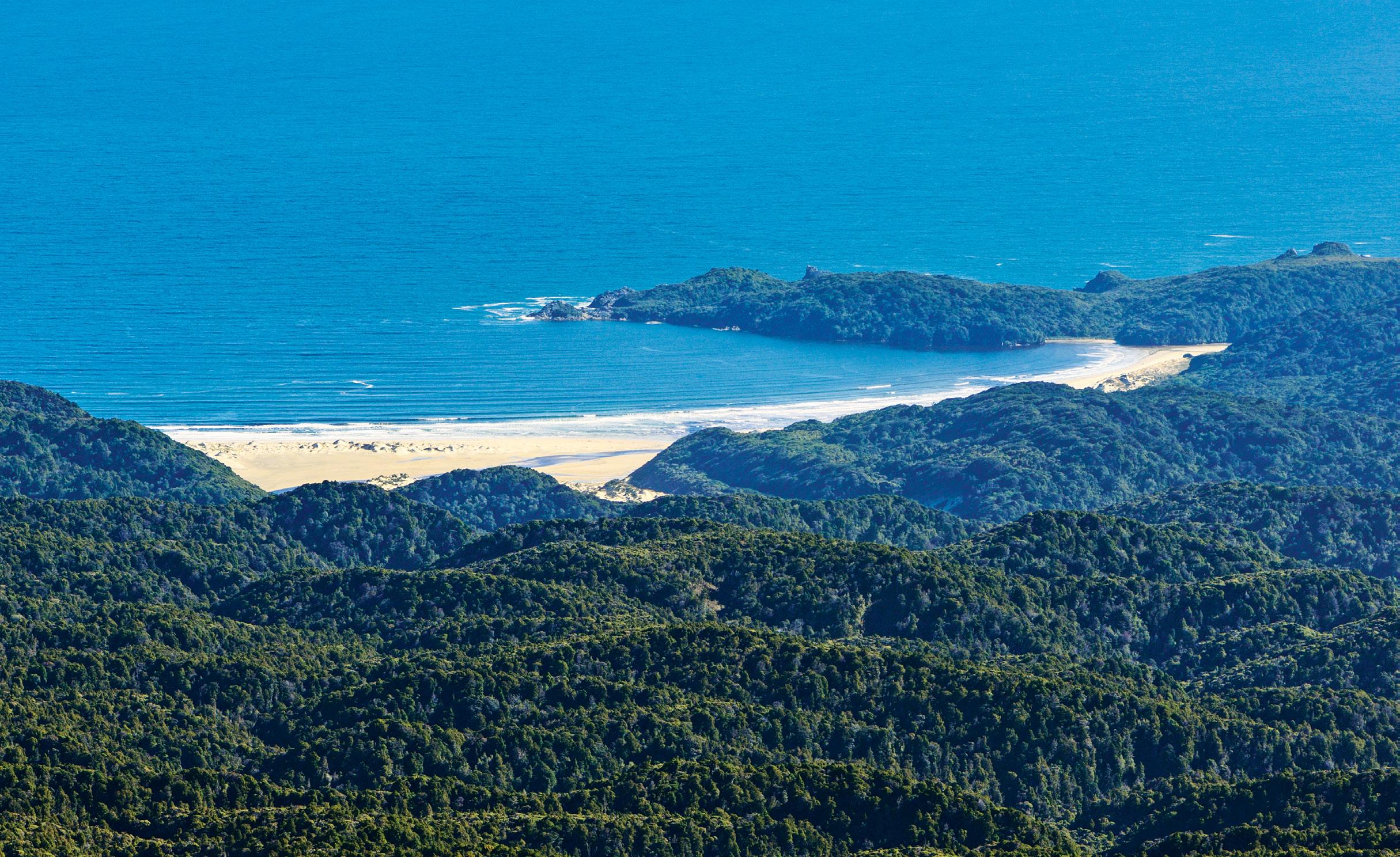
But only a small fraction of this land is managed for pest control at any given time, so there are many forests full of possums, deer, and pigs destroying its biodiversity.
There has been some progress with the Aotearoa New Zealand Biodiversity Strategy Te Mana o te Taiao, but Forest & Bird believes that, in its current form, it’s not fast enough to turn around the 4000 local species threatened with extinction.
“Protected means putting the right things in place to ensure you are reversing bodiversity loss and halting species extinction rather than just noodling along,” added Nicola.
“Climate change and biodiversity loss are inextricably linked, yet we are still mining on conservation land and bottom trawling in the Hauraki Gulf.
“This is a global signal for New Zealanders to lean into our identity and who we say we are – people who love and care for nature.”
As we move towards a general election in October, the onus is on every political party to show us how they are going to do that.
INTERNATIONAL
We need to invest in our biggest ‘asset’ – the natural world.
| Forest & Bird Te Reo o te Taiao 50
Toki, Forest & Bird
Jake Osborne
MASTERS OF AIR, LAND, & SEA
Almost all birds are best suited for life on land, some own the skies, and others are chiefs of the ocean. But cormorants, known as “shags” in Aotearoa, have adapted over millions of years to become true masters of all three – air, land, and sea.

There are 42 species in Aotearoa, including 13 cormorants endemic to our waters. One of the best known is the spotted shag or kawau tikitiki.
This iconic bird used to be commonly found along our coastlines, but today are only sighted in the Hauraki Gulf, Wellington, most of the South Island, and Rakiura.
Around 70cm in length, with a wingspan of just under a metre, the spotted shag has a slender build, greyish plumage – each back feather ends in a black spot – and yellow feet.
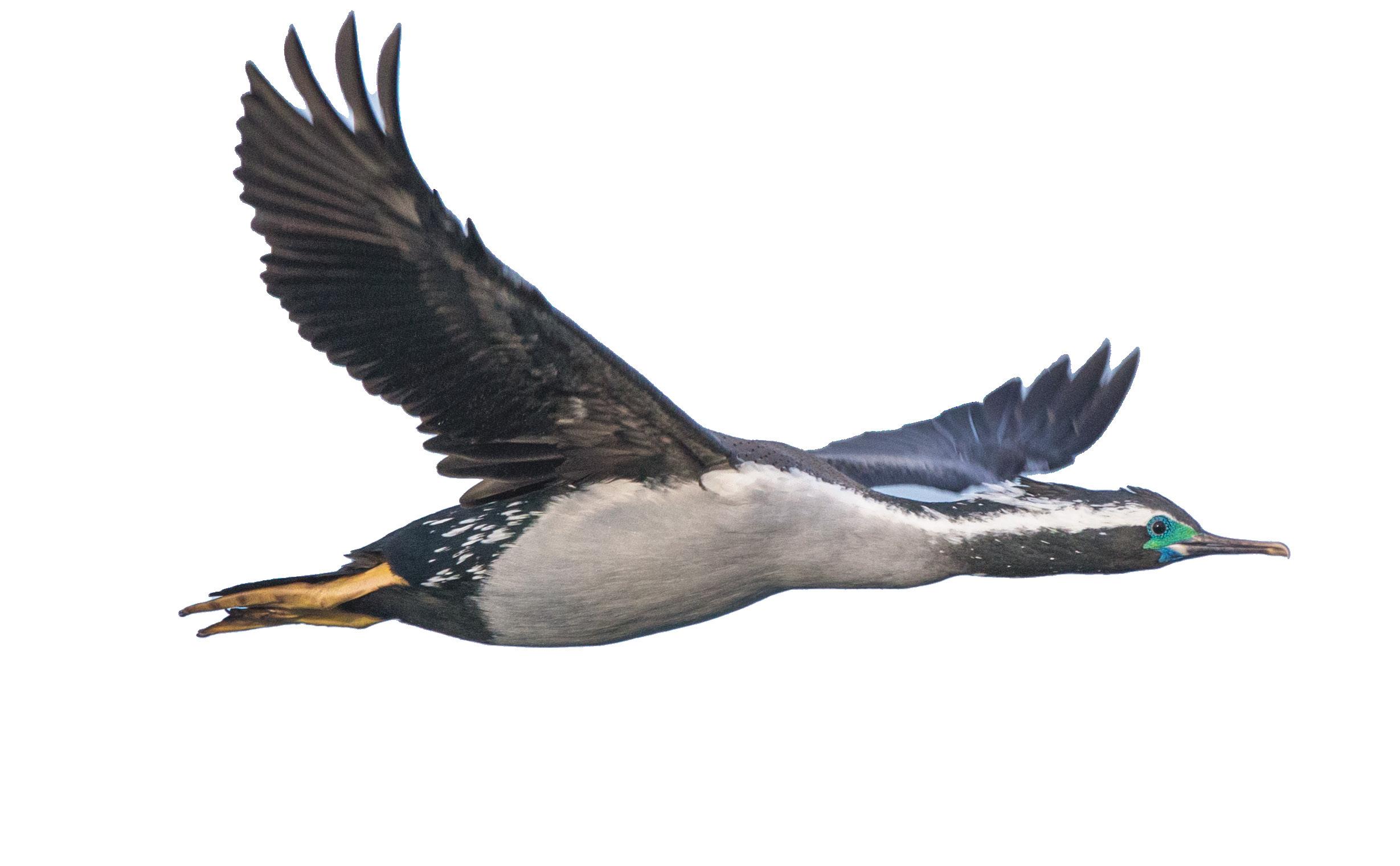
Leading up to breeding season in spring, adults develop a spectacular
shaggy (hence the name) double crest of feathers and a smattering of needle-like filoplumes on their head, brilliant blue-green hues in the face, and a bright white racing stripe down each side of their neck.
Flocks of hundreds of birds fly and forage as far as 16km offshore in pursuit of small fish and crustaceans, as well as up and down the 22km Otago Harbour each day. They keep to shallower waters but are capable divers, remaining underwater for as long as 70 seconds.
In 2019, the northern population was discovered to be genetically distinct from birds around the rest of the country. However, the previously described “blue shag” subspecies in southern New Zealand is actually no different from northern spotted shags.
But all of our spotted shags are in trouble. In 2021, the Department of Conservation upgraded the threat status of spotted shag from “Not Threatened” to “Threatened –Nationally Vulnerable” for the first time.
There has been a significant and ongoing decline in the number of breeding pairs found on Banks Peninsula, where close to half of the entire population resides.
Monitoring of smaller populations of spotted shags around the northern North Island and in Wellington has also

recorded marked declines. Only 300 pairs of the northern population remain, but there are moves to help them. In the Hauraki Gulf, for example, conservationists are trying to attract spotted shags back to a historic breeding colony on Otata Island, the largest of the Noises group.
They are using 3D printed replicas from scanned Auckland Museum specimens, white painted rocks to imitate seabird guano, and a solar-powered speaker system with a continuous loop of shaggy serenades!
Several sightings of live birds among the decoys are bringing hope. Perhaps this will be the start of a population recovery for our precious northern kawau tikitiki.
Oscar Thomas is a former Forest & Bird Youth Award winner, writer, and bird photographer –see www.oscarthomas.nz.
Spotted shags used to be widespread along the coastlines of Aotearoa, but today the species is in trouble.
Oscar Thomas
BIRDLIFE 51 Autumn 2023 |
PLAGUE SKINKS
Forest & Bird’s Marlborough Branch volunteers have been trapping pest skinks in Blenheim Helen
Braithwaite and Deleece Augustyn
Plague skinks were first found in the South Island in 2018 and immediately the word went out to lizard enthusiasts to check for this uninvited pest species, formerly known as rainbow skinks.

Luckily, only two established populations of the species were found. One was in Havelock and the other in the Riverlands-Cloudy Bay Industrial area on the outskirts of Blenheim.
The agencies decided to do some monitoring using traps to see how widespread the exotic species were. They also brought in a lizard detection dog to check the industrial area.
Forest & Bird’s Marlborough Branch was asked whether it would like to help prevent plague skinks spreading beyond the industrial area into a nearby native wetland.
It was feared the established population – living in long grass alongside an open drainage channel – was likely to spread to the Wairau Lagoons. This is a place of great significance to Rangitāne as well as a natural refuge for native lizards, plants, and invertebrates.
In 2019, under the supervision of the South Marlborough DOC office, Forest & Bird volunteers started trapping plague skinks alongside Co-op Drain.

The skinks are caught on sticky traps, which are pegged down and checked at least daily for three to five days.
The trapping occurs when the weather is optimal –not too wet, not too cold, and not too hot.
Too wet and the volunteers are at risk of slipping, too cold and the skinks are not out and about, too hot and the traps need to be checked more often.
The Ministry for Primary Industries, Marlborough District Council, and Department of Conservation joined forces to investigate and decide the best way forward.
Elimination became the goal for the Havelock infestation, but the Blenheim site was complex, with a mix of industrial units and vineyards.
The team has been trained to identify the pest species and carefully release native lizards, which unfortunately have been found only downstream of the industrial area.
This is an indication that natives are being displaced, as they were previously found in the original surveys.
Over the time we have been trapping, the team has put out 3022 traps and dispatched 711 plague skinks.
A plague skink (Lampropholis delicata) on eggs. Dylan van Winkel
Forest & Bird volunteers monitoring for plague skinks in Blenheim.
| Forest & Bird Te Reo o te Taiao 52 BRANCH PROJECT
Deleece Augustyn
WHAT ARE PLAGUE SKINKS?

Have you seen this skink?
The plague skink (Lampropholis delicata), which was previously known as a rainbow skink, originates from Australia. They have been in the North Island since the 1960s but had never been seen in the South Island until relatively recently. Introduced plague skinks compete with our native skink species for resources such as habitat or food. Plague skinks differ in their breeding methods to most of our native lizards and reproduce faster. They lay eggs and produce larger clutches of young. By contrast, native species such as grass skinks are viviparous – they give birth to live young and often have lower numbers of offspring. Being omnivorous, plague skinks also threaten native plants and animals. They eat crickets, snails, worms, beetles, flowers, small fruits, spiders, and even other small lizards. For more information, go to www.doc. govt.nz/nature/pests-and-threats/animal-pests/plague-skinks
Plague skinks are widespread throughout the North Island, but anyone finding these pests in the South Island is encouraged to contact Marlborough Forest & Bird at marlborough.branch@forestandbird.org.nz and also contact the Ministry for Primary Industries on 0800 80 99 66. If possible, please provide a clear picture and map location.
The work is not too tedious, taking a few hours –usually two hours to set up, plus one hour to check the traps each day, and two hours to clear up on the last day of a trapping cycle.
We have a pool of volunteers who come and help if they are available. Because of the easy terrain, the lightweight traps, and the easy distance to Blenheim, it is a bit different and less physically demanding than other trapping programmes.
Recently, we met up with a local lizard enthusiast Jozef Polec, who has been great at answering our questions, telling us interesting information about lizards, and showing us the finer points of trap placement and other lizard-monitoring methods.
Overall, we are pleased to have established a good connection with Marlborough District Council, in particular Steve Bezar from the drainage and floodway engineering department.



Moving forward, we would like to establish relationships with landowners and companies where we suspect plague skinks may be inhabiting, so we can access these sites and carry out surveys and monitoring.
In future, we hope to raise funding to carry out a three-year survey to confirm which skinks and geckos are present in the Wairau Lagoons area and check plague skinks have not made it that far.
 Wairau Lagoons, Marlborough. Ricky Wilson/Flickr
Wairau Lagoons, Marlborough. Ricky Wilson/Flickr
53 Autumn 2023 |
Calong the forest trail that is called Line 7 West. Ahead is the yellow bait station, nailed to a tree. I crouch down to open and refill it, and out scuttle startled cockroaches.
They startle me too! There is something creepy about cockroaches. I remind myself that these are native cockroaches, they are quite harmless, and they belong in the forest.
Worldwide, there are more than 4500 species of cockroaches. Every continent barring Antarctica has its own indigenous species, and Aotearoa has 15.
Cockroaches belong to an ancient order of insects called Blattodea.
Fossils show that they and their sister family, the termites, having been on Earth for more than 300 million years.
Back then, in the geological period called the Carboniferous, their ancestors dominated the insect community. It was a warm, wet world where forests flourished, and the cockroaches would have eaten decaying leaves and wood as
in terms of numbers and distribution, but in terms of human popularity, they are not. If you type cockroach into Google, the instant response will be “how to exterminate them”.
This tells you a lot about our attitude to cockroaches. They rank even higher than flies and spiders as the most reviled of creatures.
But the cockroaches that live in our houses are not the native species of the forest. Just as rats have travelled with us around the world, so have some species of cockroaches.
Three introduced species are pests in New Zealand, and their names betray their origins – German cockroach, American cockroach, and Gisborne cockroach.


Really? “Introduced” from Gisborne?
Despite its name, this large cockroach came from Australia. It is credited with first arriving in Gisborne in the 1960s.





This is a slight on Gisborne because the cockroach was recorded earlier in Auckland and Tauranga. Probably it came into
Now it has spread throughout the North Island and into the top of the South Island. It is quite harmless, it does not invade our food, and it prefers to live outside in the wood pile.
American cockroaches too are misnamed. They are native to Africa and the Middle East. They are thought to have arrived in America in the 17th century, quite possibly in the ships carrying African slaves to work in the plantations.
| Forest & Bird Te Reo o te Taiao 54
This winged native bush cockroach is not a pest. Parellipsidion sp Bryce MqQuillan
Native bush cockroaches are unsung heroes of the forest. Celatoblatta sp. Bryce McQuillan
And the German cockroach is not native to Europe either but probably came from Southeast Asia. It is now the most populous cockroach on Earth.






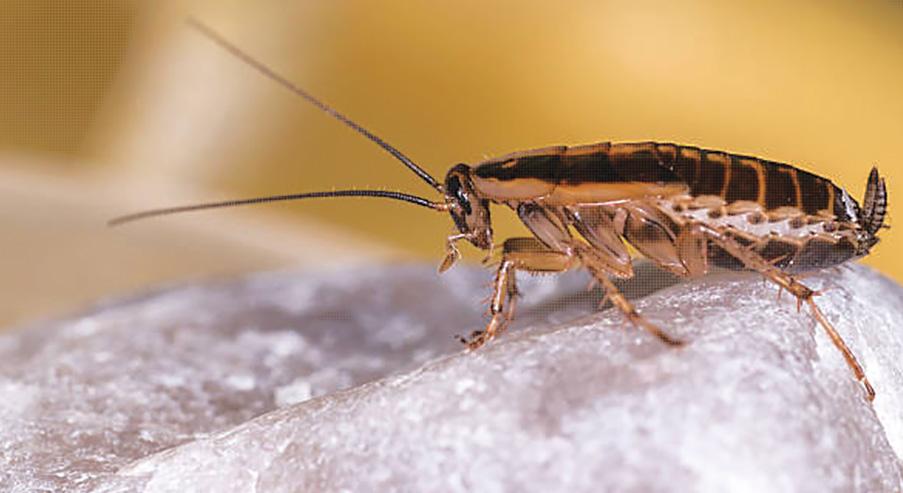

People loathe all three species, but the Gisborne cockroach does not deserve such abhorrence. It is quite benign. It does not carry diseases, but it is big and seriously scary and has the alarming habit of appearing
But a strain of German cockroaches has evolved that finds glucose distastefully bitter. They won’t touch sweetened bait. This aversion has a genetic basis and is passed on to the cockroach’s offspring. This is a dramatic illustration of natural selection and adaptation. Cockroach baits may have to evolve too.

Back in the forest, native cockroaches feast on the
different composition to the blood of mammals.
So we can admire forest cockroaches, secure in the knowledge that they will never intrude on our houses but will keep on working, part of the vital recycling team that supports our native forests and their wildlife.
when you least expect it.
But the American and German cockroaches can carry diseases and transfer them to the food in your pantry. They, like house flies, have the unlovely habit of feeding and crawling over rotting matter, then transferring the contamination when they traipse over unspoilt food.
We combat cockroaches in our houses first by cleanliness, which denies them food, then by poisoning them. Cockroaches have a sweet tooth, so simple sugars are used as a lure for the poison baits.
cereal baits we put out for rats. Thankfully, we are not poisoning the cockroaches or the wētā and leaf-veined slugs that eat the bait too.
The toxin in the block baits is an anticoagulant that acts as a blood thinner in mammals. For us, a tiny amount, carefully prescribed, can be a life saver, reducing the danger of blood clots leading to heart attacks and strokes.
For rats, constantly chewing on the same toxin, it is fatal. Insects are quite unaffected, as their watery, greenish blood has quite a
Modern cockroaches may have evolved into many species, but they still look very like the fossils of their ancestors. Their secrets of success lie in their form and behaviour:
• They have a characteristic flattened form that enables a forest cockroach to slip behind a flake of bark or a German cockroach to squeeze under the cupboard door.
• They are omnivores and scavengers, meaning they eat almost anything organic.
• They are fast. The American cockroach is considered one of the fastest running insects. In an experiment, it recorded a speed of 5.4km/h, which would be comparable to a human running at 330km/h.
 The introduced Gisborne cockroach Drymaplaneta semivitta is harmless and prefers to live outside. Bryce McQuillan
The black cockroach is a New Zealand native that lives outside in leaf litter and rotten logs. Bryce McQuillan
The introduced American cockroach. Alex Wild
The introduced Gisborne cockroach Drymaplaneta semivitta is harmless and prefers to live outside. Bryce McQuillan
The black cockroach is a New Zealand native that lives outside in leaf litter and rotten logs. Bryce McQuillan
The introduced American cockroach. Alex Wild
55 Autumn 2023 |
German cockroach. istockphoto.com
BYLAW BATTLE Beach
Sian Mair explains why pakake New Zealand sea lions still need human help to survive and thrive on mainland Aotearoa.
Let’s go on a journey. The year is 1735, and a large marine mammal known to Māori as pakake resides across Aotearoa, from Te Rerenga Wairua Cape Reinga to Rakiura Stewart Island.
The endemic population of New Zealand sea lions is healthy at 70,000, and they live relatively harmoniously with humans. They may be large and intimidating, but they are also docile, curious, and playful.
Māori subsistence hunting targets pakake for their meat and oil. The smaller kekeno, the New Zealand fur seal, is also targeted for their doublelayered and durable epidermis.
When Europeans arrived in Aotearoa, one of the first industries off the block was sealing, which begun in 1792 and quickly took off.
But by 1812, the annual return decreased from 50,000 to 7000 animals over four years. Eventually, the seal harvest became so unsustainable, it was effectively a cull.
Sea lions were easier targets for sealers, as they were less skittish and theatrical than their cousins and were nonchalant, making them an easier target.
By the mid-1940s, sea lions had been eradicated from mainland Aotearoa.


That would have been the end of their story had a remnant population not established themselves in the sub-Antarctic islands. Eventually, this population would grow to 12,000.
The Marine Mammals Protection Act was implemented in 1978, and fur seals, who favour rocky shorelines, made a miraculous comeback.
But sea lions, which prefer sandy beaches, did not return.
Luckily, this was not the end of their story. In 1994, a sea lion cow
later dubbed “Mum” gave birth to the first pup born on mainland Aotearoa for more than 150 years.
She had swum all the way from the Auckland Islands to Taieri Mouth on the South Otago coast. Over the next two decades, Mum carried on breeding, giving 11 pups and establishing a new pakake dynasty.
Most of Dunedin’s resident sea lions are descendants of Mum. Likewise, many of the resident sea lions in the Clutha and Southland regions are descendants of migrants from the sub-Antarctic islands.
Sadly, many New Zealanders had forgotten about sea lions and their
 Sea lion with motorbike on Jack’s Bay, near Hinahina, in the Catlins.
Sian Mair
Sea lion with motorbike on Jack’s Bay, near Hinahina, in the Catlins.
Sian Mair
MARINE | Forest & Bird Te Reo o te Taiao 56
Sea lion captured on Enderby Island in 1909. Alexander Turnbull Library
A sculpture of “Mum”, St Clair, Dunedin. Ruth Brassington
status as taonga – ours to protect and treasure.
Like their ancestors, some people use the beaches as roads to access their whare or house, but unlike their ancestors many drive powerful large motor vehicles.
Sea lions are philopatric – they return to the beaches where they were born to give birth.
The breeding season is over our summer, from December to February, the same time many of us like to visit the beach.
The pups weigh less than 12kg at birth and depend heavily on their mothers for 10 months. They are left in groups on the beach while the cows forage for food offshore.
In 2017, Dunedin City Council enacted its Reserves and Beaches Bylaw, which only allows vehicles on beaches to launch or retrieve a vessel.
Why? To protect New Zealand sea lions and hoiho yellow-eyed penguins.
But there was no similar bylaw protecting breeding sea lions and penguins on beaches in neighbouring Clutha District Council.
That’s why, in June 2020, I began a David vs Goliath quest, challenging the status quo. I created a petition on Change.org to propose the council restrict vehicles on its beaches to protect the valuable wildlife.
I built relationships with locals, iwi, organisations such as Forest & Bird, the New Zealand Sea Lion Trust, and the Department of Conservation, sea lion specialists, councillors, and politicians
After more than two years of campaigning, alongside many passionate members of the public, Clutha District Council released a draft Vehicles on Beaches Bylaw, for public consultation in May 2022.
The following month, I spoke to councillors in support of my written submission, imploring them to restrict vehicles on all beaches in the Clutha region or, alternately, restrict vehicles on eight
beaches of wildlife significance and introduce a speed limit of 20kph rather than 100kph.
My requests were echoed by Forest & Bird, the New Zealand Sea Lion Trust, the Yellow-eyed Penguin Trust, and members of the public.
We explained how sea lions have successfully established breeding populations in Dunedin and Rakiura Stewart Island but not in the Clutha region, where driving on beaches remains a popular part of the culture.

Sea lions haven’t evolved the behavioural adaptions to understand the threats vehicles pose. They are crossing roads next to beaches and sometimes being hit and killed.
There were people who spoke in opposition to vehicle restrictions. When you have been able to partake in an activity you enjoy for as long as you can remember, it is hard to give it up.
We managed to get some positive change but nowhere near as much protection as the sea lions need. In December 2022, the council put up signs at Papatowai Beach asking people to consider whether they need to drive on the beach. Further signs at other beaches are planned.

And, on 1 January 2023, Clutha District Council’s Vehicles on Beaches Bylaw came into effect. Vehicles are not allowed on sand dunes, except to access the beach, and vehicles are not allowed to drive above the high-tide mark, except in emergencies.
Our requests for vehicle restrictions on wildlife-rich beaches and a speed limit of 20kph were rejected.
The new bylaw is less than we asked for, but hopefully the publicity generated by the campaign will raise awareness and fewer locals and visitors will choose to take their cars on beaches where sea lions,
penguins, and shorebirds are known to frequent.
We don’t inherit Papatūānuku from our ancestors, we borrow it from our tamariki. It is our responsibility to protect the Earth and live harmoniously with the wildlife we are lucky enough to share it with.
Thank you to all the supporters of the campaign!
Sian Mair is studying zoology at the University of Otago. She is the founder of Sea Society – for more information, see www.seasocietynz.com

Forest & Bird continues to raise awareness about the impact of cars on wildlife-rich beaches and is working with local communities to advocate for new beach bylaws in appropriate places.
 Forest & Bird has been campaigning to protect pakake in the Sub-Antarctic Islands and on New Zealand’s mainland since the early 1980s.
Forest & Bird has been campaigning to protect pakake in the Sub-Antarctic Islands and on New Zealand’s mainland since the early 1980s.
57 Autumn 2023 |
Sian Mair
Sea lion pup waiting in dunes for its mother to return. Jeremy Wood
RADICAL CONNECTIONS
Internationally respected scientist Dr John Flux looks at the diversity and interconnectedness of all the life around us.
People are animals, and during most of the short time humans have existed, we have obeyed ecological rules. However, we are now four times over Earth’s “carrying capacity” – stressed and heading for real trouble.
As a graduate in natural history, I suggest ecology and mātauranga Māori may be the most useful subjects to master if we humans want a future.
LET ME SHOW YOU WHY
From jellyfish living in the Sargasso Sea, in the Atlantic, to the parma wallaby on Kawau Island, Aotearoa, we are all connected and interdependent. You upset the balance of one life form, and it has an impact on many others.


Take, for example, our archaic jellyfish that originated 500–700 million years ago. Why do they come back to haunt us when we throw a plastic Coke bottle away?
Well, the bottles land up in the ocean and float around for ever. They spiral in gyres (enormous circular eddy-like currents), eventually landing in the Sargasso Sea, a vast patch of ocean named for a genus of freefloating seaweed called Sargassum.
Trigger fish with plastic debris the Sargasso Sea. Shane Gross/Greenpeace
BIODIVERSITY
Velella jellyfish. istockphoto.com
| Forest & Bird Te Reo o te Taiao 58
Sargasso Sea
Located entirely within the Atlantic Ocean, this is the only sea in the world without a land boundary.
Scientists (the technology-can-fix-it sort, not ecologists) were about to scoop up all the plastic bottles in gigantic seine nets, until someone pointed out this would destroy the unique Sargasso ecosystem, already under threat from coastal species hitching a lift there on floating plastic.
Back to ancient jellyfish. The one I find fascinating is called Velella “little sail” in Latin. Māori recognise its relationship to katiaho, the stinging Portuguese man o’ war. They call it katiaho rere, the sailor.
Cosmopolitan in its habitat, Velella has mirror-image forms, with the sail set to steer 60 degrees left or right of the wind. In northern gyres, left-handed Velella sailors wash ashore, while in New Zealand’s southern waters most are right handers.
Velella numbers have increased dramatically all over the world. New Zealand’s first mass stranding in 2006 left 10m jellyfish per kilometre washed up on West Coast beaches.
Populations of other jellyfish species are increasing too, killing young fish and, in other parts of the world, shutting down nuclear power plants by blocking cooling water intakes.
Is this because their main predators – albatross, turtles, sunfish – are dying after eating coke bottles and polythene bags thrown away by humans?
Let’s divert to Kawau Island, 40km north of Auckland. Abandoned by Māori in the 1820s, mined for manganese and copper from 1842 to 1855, it was eventually bought by Sir George Grey in 1862 for a private retreat.
Grey spoke fluent te reo and had great mana with the local rangatira chiefs, but he turned Kawau into a zoo.

Having good connections after working in South Africa and Australia, he imported zebra, monkeys, kookaburra, possums, and five species of wallabies. This included the parma wallaby, which by 1932 was thought to be extinct in its Australian homeland. It survived all attempts to exterminate it from Kawau, only to be “rediscovered” in 1967 and sent to restock Australia. Today, it is the commonest wallaby in zoos around the world.

This brings us to the subject of zoos. There is no biodiversity in a zoo. As Bill Mollison (the inventor of permaculture) says, it is not the number of elements or species present that matters, but “the number of functional connections between these elements”. Fenced ecological sanctuaries like Wellington’s Zealandia face similar issues – how do you repopulate a complex habitat once you’ve removed the last introduced pest?
It’s simple enough, for example, to eliminate introduced perch from Zealandia’s lower lake. But what should they be replaced with? How many kinds of native fish should be there – and how many of each – to ensure a liveable habitat?
Luckily, ecology has some useful rules. For example,
→ 59 Autumn 2023 |
How do you repopulate a complex habitat once you’ve removed the last introduced pest?
Parma wallaby. Daniela Parra
Allegorical triumph of Sir George Grey, 2001. Hamish Foote
Charles Elton’s pyramid of abundance tells us 1000kg of grass can support 100kg of grass-eating rabbits, 10kg of rabbit-eating cats, and a 1kg cat-eating eagle.
Meanwhile, Gause’s Law shows us that two species cannot occupy the same niche (one replaces the other), so diversity of habitat use matters.
Frank Preston, a brilliant mathematician, added two additional rules – the number of species that can exist together is directly related to the area of habitat available. And the number of individuals of those species form a “log-normal” distribution – a few are common, usually with broad niches, but there is a long trail of specialised rarities.
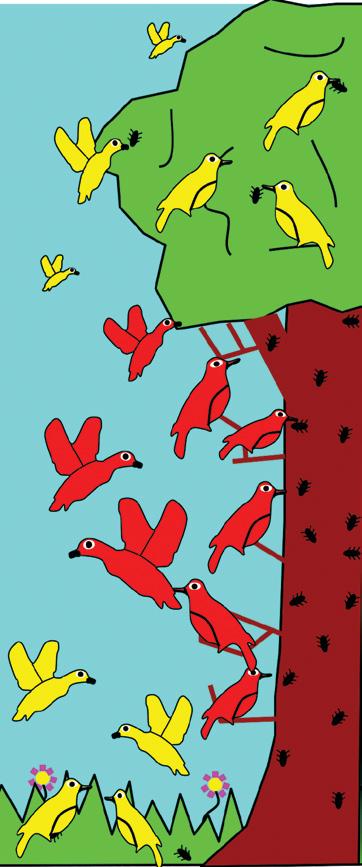



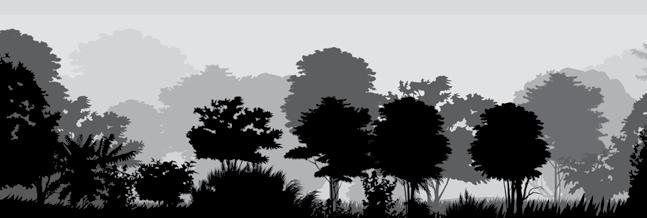
Hence, in Zealandia, there is no point in trying to keep more than one type of kiwi or kakariki, and it is unlikely bellbirds can ever co-exist with tūī or miromiro tomtits with toutouwai.
Gause’s Law
Provision of extra food and nest-boxes boosts bird numbers at the expense of insects and other invertebrates. This in turn harms insect-eating skinks and geckos – and even bats that might have found a home had the habitat not been artificially altered.
The ecological way to tackle introduced predators is to eliminate mice first, allowing other predators to keep eating them while this happens.

Then eradicate in the following order: rats, weasels, stoats, and finally the apex predator – feral cats. Each of these kills everything below them on the list and helps prevent re-invasion.

The value most people put on animals and plants has no ecological foundation. Even our language is biased – the “soft, warm, and cuddly” need protection from coldblooded killers.
Snakes, scorpions, spiders, and sandflies evoke hatred. Yet all living species date from four billion
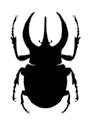
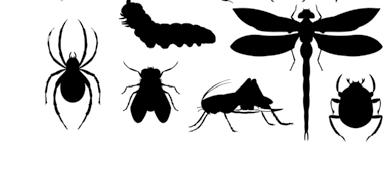




 Fig 1: A smaller (yellow) species of bird forages across the whole tree.
Fig 2: A larger (red) species competes for resources.
Fig 3: Red dominates in the middle for the more abundant resources. Yellow adapts to a new niche restricted to the top and bottom and avoiding competition.
Fig 1: A smaller (yellow) species of bird forages across the whole tree.
Fig 2: A larger (red) species competes for resources.
Fig 3: Red dominates in the middle for the more abundant resources. Yellow adapts to a new niche restricted to the top and bottom and avoiding competition.
→ | Forest & Bird Te Reo o te Taiao 60
Dhanscom17/Wikimedia
Charles Elton’s ecological pyramid istockphoto.com
Top Carnivores Tertiary Consumers
1 2 3
Carnivores | Secondary Consumers
Photosynthesis | Primary Producers
years ago and survive because they have evolved to fill a niche in a complex ecosystem better than any competitor.
Some, such as the tuatara, occupy a niche that is stable and requires little change. Others, such as rats, humans, and most plants and insects, found themselves in an arms race to evolve, with many parasites and predators.
Back to Gause’s Law. Two species can’t occupy the same niche – and the more similar they are, the stronger the competition. Let’s look at this through the eyes of one of our most successful introduced predators.
The first rat to arrive in Aotearoa was the kiore, brought by Māori. In large numbers, fuelled by plenty of ground-dwelling food, kiore can kill an albatross.
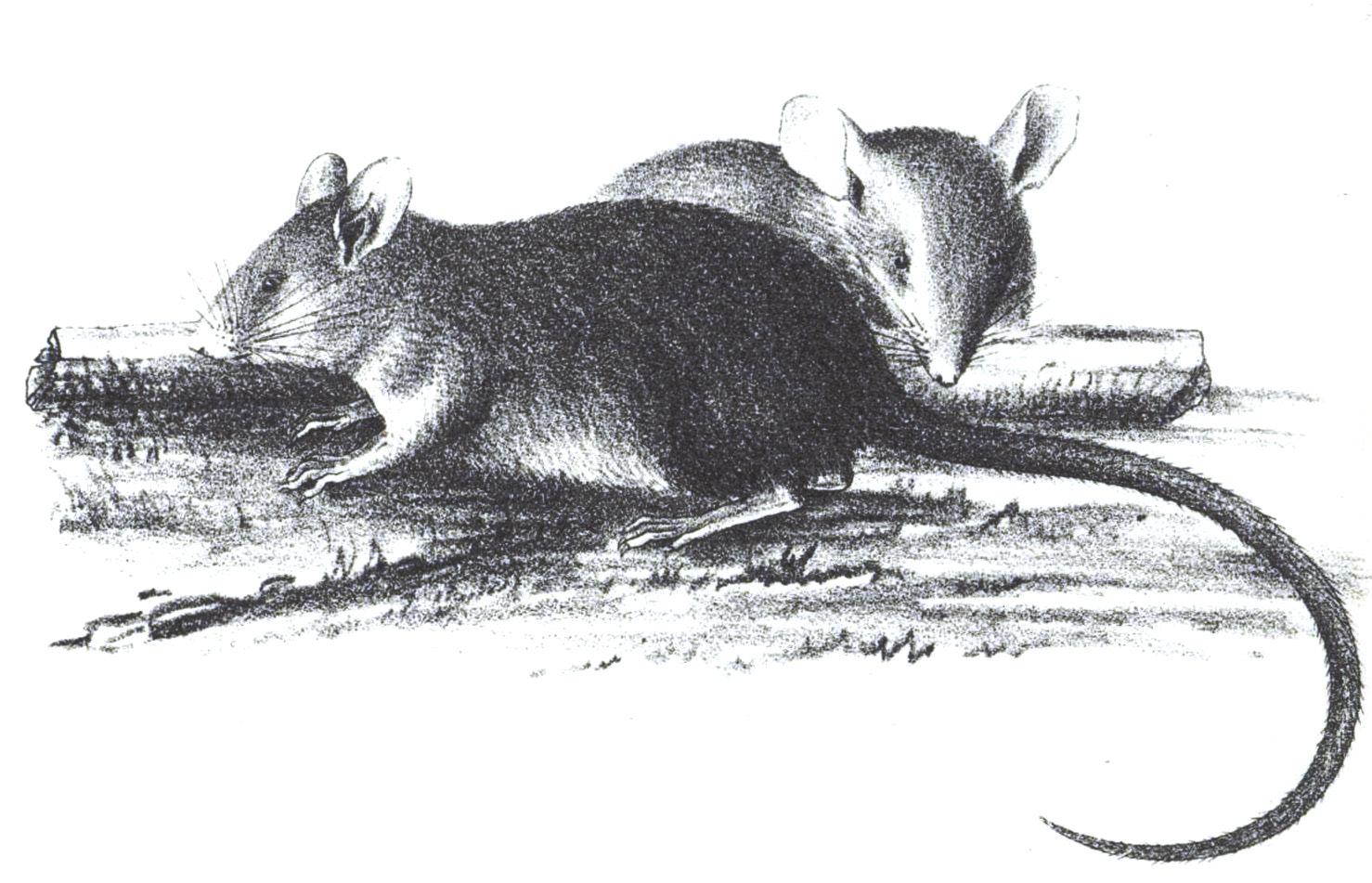
Kiore had a field day exterminating 32 bird species in Aoteaora and countless big insects and snails. Then Captain Cook and European whalers arrived and let loose their Norway rats.
These were far bigger, spread over the country, and cleared out kiore. Next, the more agile tree-climbing ship rat arrived and pushed Norway rats aside.
Today, kiore are rare, living in a few isolated pockets and offshore islands, while Norway rats adopted New Zealand’s waterways, swamps, and the coast (they can dive 2m for shellfish!).
It can all go in reverse too. When volunteers removed ship rats on Miramar Peninsula, in Wellington, the Norway rats invaded from their coastal refuge. “Monster rats in Wellington the size of small possums”, trumpeted the Dominion Post in June 2019.

All of this illustrates the frightening power of competition.
Theoretically, of course, it’s obvious predators, parasites, and diseases must not exterminate their prey – or they become extinct too. Removing a competitor is quite safe, as long as you win and it doesn’t remove you first.
Homo sapiens apparently wiped out all nine of their earlier Homo relatives (some may have eliminated each other), almost all gorillas, most chimpanzees, and orangutans, but not many monkeys, except those living in trees we wanted for timber.
Who is left now for us to compete against? Only ourselves. Population and CO2 is increasing, the world’s resources running out, our neurotic race to survive is accelerating. The road to extinction looks inevitable.
Is Forest & Bird’s laudable predator control work, Zealandia’s efforts to rid its lower lake of invasive perch, and the country’s Predator Free 2050 mission a
Perhaps it’s a “displacement activity”, something to do when we should be blowing up coal-fired power stations. However, I believe forward planning for the next 500 years is a vital vision. We need to keep hope alive.
I smile when I think of Pons Fabricius, a Roman bridge over the Tiber, built 2083 years ago and still carrying traffic. Which of New Zealand’s bridges will still be here in 4021?

Yet Zealandia might make it – with or without us. In Russia, ecology is a compulsory subject and has been since 2000, now also learned by children in China. If it were taught here, nothing in this essay would be new to you...
 Kids learning about ecology. shutterstock
Kids learning about ecology. shutterstock
61 Autumn 2023 |
Pons Fabricius, Rome, build in 62BC. Wikipedia
Polynesian rats, Rattus exulans, kiore. Walter Buller, 1870
Ship’s rat predating a kererū egg. Ngā Manu images
INVESTING IN A BETTER PLANET
Pathfinder CEO John Berry explains why he set up an ethical investment company that uses the power of money for good. Gretchen Carroll
Back in 2010, John Berry was told he was foolish to focus his wealth management company on ethical and environmentally friendly investments.
But he and business partner Paul Brownsey carried on anyway, and Kiwis looking for mindful ways to invest their hard-earned money jumped on board.
Today, Pathfinder is an award-winning company that manages about $500 million of planet-friendly investments on behalf of its customers, including an ethical KiwiSaver that launched in 2019.
Over the past decade, ethical investing has gone from niche to mainstream and Pathfinder’s CEO John Berry has been a high-profile advocate.
“It’s not a binary choice between making money and doing good. Investors can do both by investing in the right companies,” he says.
“As individuals, we may feel powerless to do anything about climate change, but how we collectively invest our money can make a real impact.
“New Zealanders have about $85 billion dollars invested in their Kiwisaver accounts – that’s a lot of shareholder power.
“We should invest in ways that say to corporates, this is the sort of ethical and environmental behaviour we want.”
Pathfinder is on a mission to change the world for the better. Pathfinder’s Ethical Investment Policy uses exclusions, ESG (environmental, social, and governance) metrics, and positive investment themes to guide which companies to invest in.
“We choose sustainable themes – those that are positive for the planet and communities but, at the same time, will make good returns for our investors,” explains John.

“Things like social housing, energy efficiency, renewable energy, and water technology.
“We’ve borrowed the world from future generations
– what state do we want to return it in? This is a really powerful motivator for me.”
Pathfinder scooped Mindful Money’s Best Ethical KiwiSaver Fund Provider in 2021 and 2022.

Believing climate change is the greatest challenge the world faces, Pathfinder is working to drive down the carbon intensity of its portfolios.
“If companies aren’t preparing for a low carbon future, they carry a higher financial risk,” says John.
“I want to invest in companies that are decarbonising, because it’s the right thing to do for our children and our grandchildren.”
Pathfinder donates 20% of every member’s KiwiSaver management fees to their client’s choice of charity.
The aim is to provide a sustainable long-term passive income stream for its charitable partners, which include Forest & Bird.
Pathfinder has donated $397,027 to 18 charities over the last three years, with Forest & Bird receiving a total of $104,991.
John says the overall pot of charitable donations for 2023 alone should rise to $500,000 and increase as the company grows.
“When choosing who to work with, we ask is this charity contributing to fixing New Zealand’s key social and environmental issues?
“Forest & Bird has an excellent alignment of values with Pathfinder as climate change is a key focus for both, along with the protection of biodiversity and ecosystems.”
Pathfinder Asset Management Limited is the issuer of the Pathfinder KiwiSaver Plan and Pathfinder Investment Funds. Product Disclosure Statements for the offers are available at https://pathfinder.kiwi.
Forest & Bird encourages investors to seek financial advice prior to making investment decisions.

OUR PARTNERS | Forest & Bird Te Reo o te Taiao 62
Summer
IN THE CATLINS
Two-time summer warden Karen Thompson shares her experiences at Forest & Bird’s Lenz Reserve near Papatowai, the Catlins.
It was January when I did my first month as a volunteer warden looking after the little wooden A-frame Tautuku cabins at Forest & Bird’s Lenz Reserve, surrounded by native forest, nature trails, wild beaches, wetlands, and rivers.
Thanks to predator control, birdlife flourishes here, as does the grass surrounding the cabins where visitors stay on their way through the Catlins.
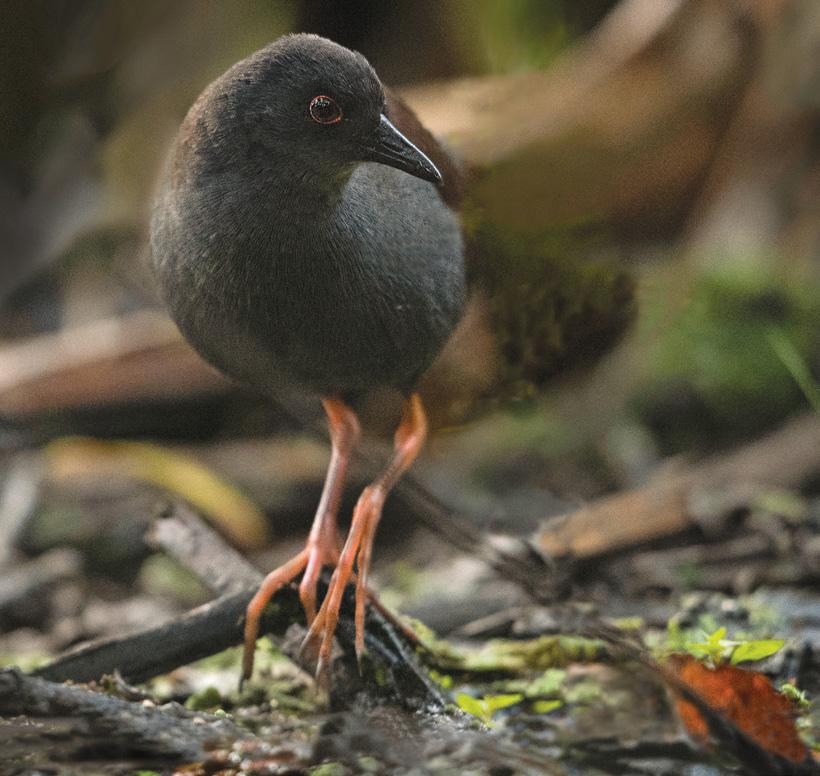
My little place in Christchurch doesn’t have grass, so the lawnmowing element of my job was a big commitment. But I enjoyed it and made sure that, on fine days, I got some done. I lost a few kilos too and got a tan.

It’s laughable to think I brought sun-tan lotion with me the second time I came here. We had a polar blast, with snow and hail showers and the threat of frozen pipes and power cuts!
Thankfully, I’m a writer, so being cooped up in the caravan with the heater on and wearing almost all of my clothes at once (beanie and scarf included) didn’t dampen my experience. In fact, I was inspired to write a poem about the “Polar Blast”.
Connecting with nature is so good for our well-being. Escaping city life, work, and family commitments is an ideal opportunity to recalibrate and connect to our true essence.
For me, it is an opportunity to write and reflect – they go hand in hand for me.
Sitting here, looking out from the warmth of the caravan, a tomtit braves the elements to look for food and nesting material. Thrushes diligently plod across the snow-dusted grass outside my window.
When I observe nature, I can’t help but notice how it yields to what is – I see the flax bush bending and flexing with every nuance of wind and rain.
We humans aren’t so flexible. We try and mould things to suit our man-made agendas, yet nature has its own wisdom, rhythms, and ways.
Observing it and working with it instead of against it, we can find peace, joy, and abiding strength, a cessation of striving. After all, we are part of nature and nature is part of us. There is no separation other than that we put there ourselves.
Karen Thompson is a writer and counsellor who lives and works in Christchurch. To volunteer at Lenz Reserve, contact Fergus Sutherland at Tautukucabins@gmail.com

To book a stay, go to www. forestandbird.org.nz/ourcommunity/lodges/tautukuforest-cabins.
SPOTLESS SIGHTING
Forest & Bird’s Tautuku Restoration Project team is delighted to report pūweto spotless crake are present in the Fleming wetland. Earlier this year, three adjacent wetlands were surveyed at dusk during a wetland bird monitoring weekend, held in collaboration with BirdsNZ.
First the team was thrilled to hear the “booms” of matuku hūrepo, showing the Australasian bittern was present in the Tahakopa estuary.
Then they discovered spotless crake in the Fleming wetland, situated within Forest & Bird’s Lenz Reserve. It’s the first time this cryptic and rarely seen species has been recorded in this part of Otago.
The team is hopeful the birds will remain residents and are planning a winter survey where they will survey the entire wetland to try to get a better estimate of numbers.
Karen on duty at the Lenz Reserve.
Fergus Sutherland
63 Autumn 2023 |
THE DEGROWTH REVOLUTION
It’s time to work for a better future by reducing energy use and redistributing wealth.
Sahra Kress
We are producing and consuming goods and creating climate-warming emissions at unprecedented levels, even though we know our actions are destroying nature.
In the face of climate change, economic change is inevitable and inescapable – the only question is will it come by design or disaster?
Constant and relentless growth is destroying the climate and the ecosystems, such as forests and wetlands, that could help reverse global warming.
But there are other ways of organising our social and economic lives. “Degrowth” is a compelling economic theory that emerged in the 1970s and is gaining traction as fears about climate change and biodiversity loss escalate.
I’m a member of a new national initiative called Degrowth Aotearoa NZ. I’m writing about this movement as a midwife passionately concerned about the future of every child I deliver.
Degrowth is about shrinking rather than growing economies so we use less of the world’s energy and resources, and put environmental wellbeing ahead of profit. It’s important to note that degrowth and recession are not the same thing.

Dr Jason Hickel, an economic anthropologist at Goldsmiths University of London, explains: “A recession is what happens when a growth-oriented economy like capitalism fails to get growth, things fall apart.
“We need economies that can shift into a lower gear without harming people’s lives, so degrowth basically calls for a planned down-shifting of the economy so that we
use fewer fossil fuels, we use fewer unnecessary resources, but at the same time distribute existing income and opportunities more fairly so that people can have access to the things they need to live flourishing lives.”
However, the current “growthist” marketplace favours the wealthy and enables their gain at the dual expense of the natural living systems that all species depend on and the standard of living of the masses subsisting near to the poverty line.
We need to decide as a society whether to defend and maintain this system, placing untold wealth in the hands of a few while decimating the natural environment and marginalising already marginalised people.
Alternatively, we could redistribute existing wealth and put in place limits to entitlement, limits to impact on natural systems – a degrowth or post-growth agenda.
The mechanism is downscaling energy use and redistribution of wealth, not austerity.
OPINION
| Forest & Bird Te Reo o te Taiao 64
The Ukraine war has revealed the risks of over-reliance on energy to power our economies. The conflict also threatens to unleash an unprecedented food crisis that could last years, the United Nations’ Secretary-General António Guterres warned last year.
New Zealand degrowth activist Dr Jack Santa Barbara is a retired CEO, academic, philanthropist, author, and environmentalist.
“The economy is an energy system that requires growing surplus energy to avoid collapse,” he explains.
“Before we can use energy, we must first obtain it, and this has an energy cost of its own. The more required, the less surplus energy is available to power the wider economy, so we must keep using more and more energy.”
Some argue that green growth is the answer and we should be pursuing this path rather than degrowth. The OECD defines green growth as “fostering economic growth and development while ensuring that natural assets continue to provide the resources and environmental services on which our wellbeing relies”.
But things are getting worse and fast. Do we have time to wait for green growth to solve the issue? I’d prefer to imagine the end of the growth economy rather than the end of the world.
In an article on the Brave New Europe website, Bill McGuire, Professor Emeritus of Geophysical & Climate Hazards at University College London, said: “The truth is that we are at the heart of a crisis situation that has the potential to tear apart global society and economy within decades.
“We have the ability and opportunity to engage, to make a difference, but this will only happen if enough people understand the magnitude of the problem, and are scared enough to act.”
It’s up to us to determine the narrative for a genuinely
sustainable and just future. Put simply, we need to think and act differently.
We cannot rely on governments to implement the radical changes needed without large numbers of us demanding pragmatic responses to this planetary emergency. We must urge our government ministers to implement policies that put human and ecological wellbeing at their centre, not growth. Putting strong incentives in place to push for energy conservation and reduced material “throughput” is not popular but will be increasingly necessary.
There are other things individuals can do. Voluntary simplicity is sometimes called “the quiet revolution”. This approach to life involves providing for material needs as simply and directly as possible, minimising expenditure on consumer goods and services, and directing progressively more time and energy towards pursuing non-materialistic sources of satisfaction and meaning. It affirms what is often just called “the simple life” or “downshifting”.
There are also great examples of community action. For example, the Nelson Tasman Climate Forum published an action plan in 2021 to engage with individuals, community organisations, businesses, iwi, and local government on the transformation needed. It includes specific measurable and practical steps everyone can take to make a contribution to a healthy planet.
We must be advocates for the children of the future. The children of the present have already raised their voices and begged us to act. It is up to us to change our ways to allow space for all living things on this beautiful planet.
It will take courage, struggle, compassion, and connection. Kotahitanga, we must work together.
To find out more about Degrowth Aotearoa NZ, see www.degrowth.nz. To download a copy of the Nelson Tasman Climate Action Plan, see http://bit.ly/3kjV2B1.

65 Autumn 2023 |
A GRAND FIORDLAND TOUR
A solo tramp along Fiordland’s Kepler Track offers a ringside view of some of Aotearoa New Zealand’s wildest vistas. Montana Denton
Unlike Southland’s iconic Milford and Routeburn tramps, the Kepler Track didn’t evolve from a Māori greenstone trail or the exploration of early pioneers.
Opened in 1988 to take the pressure off the two other Fiordland Great Walks, the Kepler has become a classic tramp in its own right.
It was designed to feature the very best of Fiordland – far-reaching alpine vistas, plunging glacial valleys,
sidled along the limestone bluffs to reach the top of the bushline the rain had dissipated.
This tussock-coated expanse is the first glimpse of the many mountain ranges of Fiordland. In the distance are the Murchison Mountains, looming blue peaks across an arm of Lake Te Anau.
Presumed extinct at the end of the 19th century, South Island takahē were rediscovered in this mountain range in 1948, and the area is now managed the Department of Conservation as a recovery area for these chunky, iridescent flightless birds.
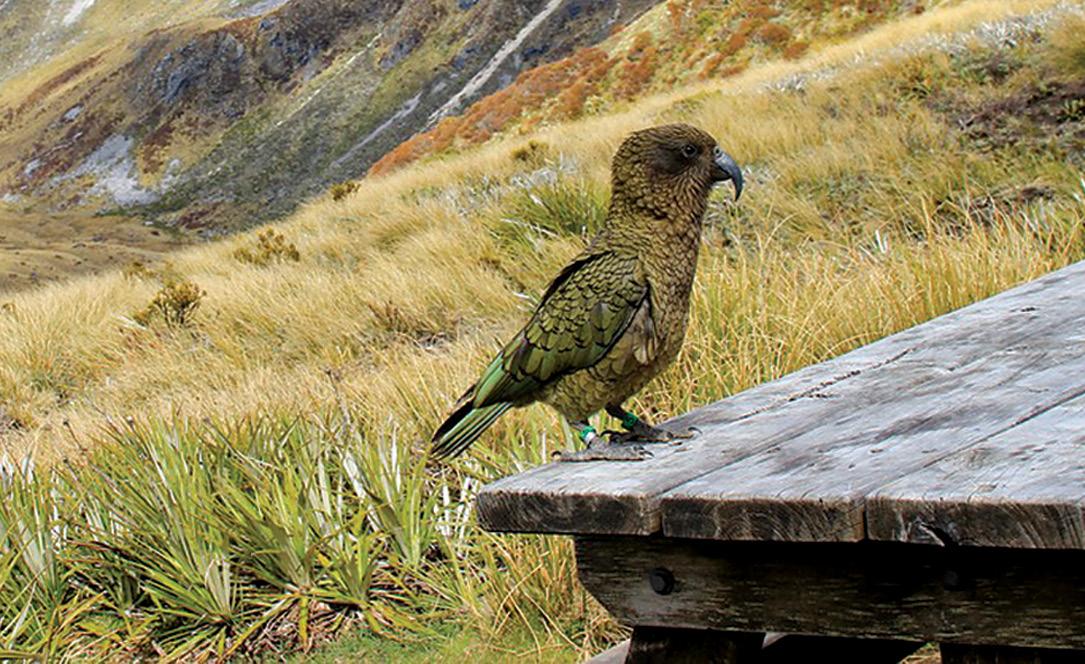
I arrived at Luxmore Hut late afternoon, gleefully exchanging my well-worn boots for jandals and heating up a warm drink. Nestled in the corner of the common area is a whiteboard listing the names of some local mountain residents — Shae, Melsby, Lee, and Janine –tagged kea regularly spotted in the area.
After a much-needed rest, I laced up my boots for a quick walk to Luxmore Cave – an optional side trip featuring an impressive limestone cavern system that branches kilometres into the earth.
Early next morning, it was time to set off on a nearly empty track enjoying the sunshine and clear skies. I was
towering limestone bluffs, ridgelines coated in scrubby tussocks and patches of snow, and ancient beech and podocarp forests.
The Kepler is a grand tour of the magic of New Zealand’s Deep South for Kiwis and international travellers alike.
I was lucky to get a last-minute booking early in the 2022 season. With a promising weather forecast and a pack stuffed to the brim with hiking snacks, I was ready for an adventure.
Day 1 threatened deluge as I wound my way through the beech forest along the shores of Lake Te Anau, but by the time I had summited the switchbacks and


| Forest & Bird Te Reo o te Taiao 66 GOING
PLACES
A cheeky kea near Hanging Valley shelter.
The view down to Te Anau.
treated to unparalleled views of the Kepler Mountains before spotting a DOC sign offering a 10-minute detour to summit Mount Luxmore.
I debated dropping my weighty gear to scramble up the rocky slope but instantly thought better of this when several cheeky kea turned up, so up I went gear on my back.
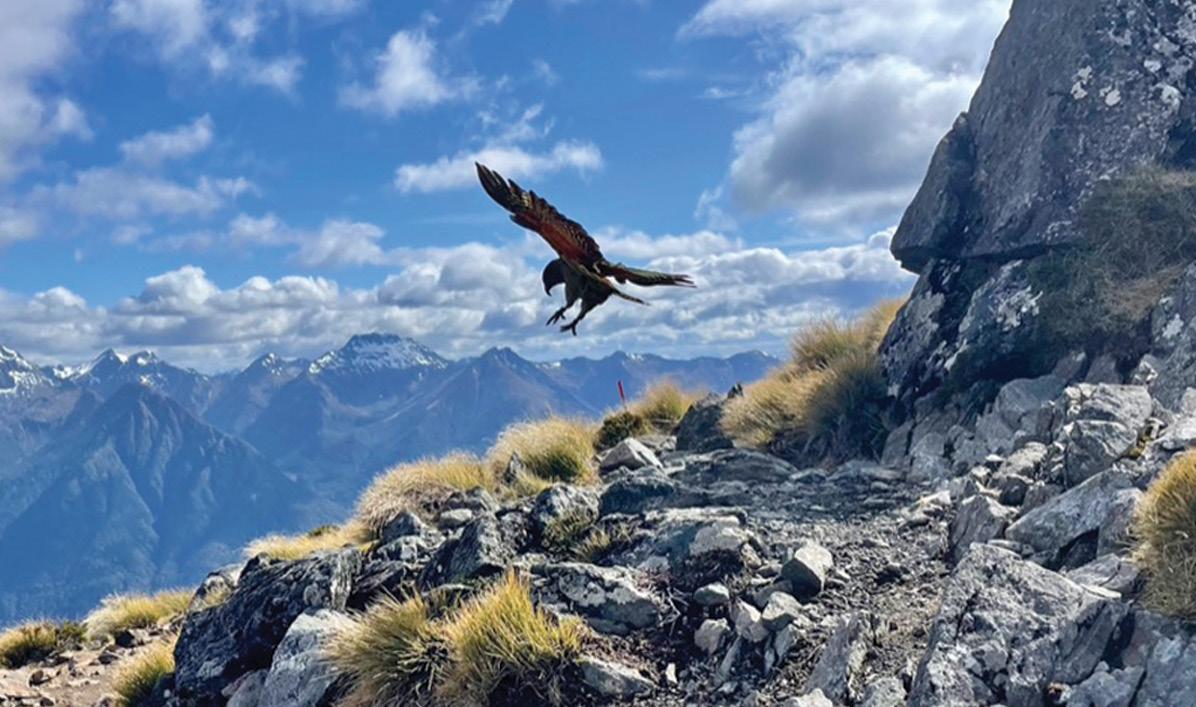
After meandering down the ridgeline, I stopped at the Hanging Valley emergency shelter for lunch and was joined by my new and very entertaining feathered friends.
While one kea danced around to distract me, the other snuck under the deck and began pecking through the slats in the wood in an attempt to dig into my pack.
After my kea-disrupted break, I tramped across the remaining ridgeline. The path slowly dropped back below the treeline, and the expansive vista disappeared on the descent into Iris Burn, navigating tree slips.
Batting away what seemed like an infinite plague of sandflies at the Iris Burn Hut was a small price to pay for the beauty of the local waterfall, with its inviting swimming hole a quick stroll up the path.
Day 3 took me back through the beech forest into a glacier-carved valley along a relatively flat stretch of track to the shores of Lake Manapouri.
I arrived at Moturau Hut by midday, ate lunch on the beach, and spotted eels flashing through the clear water before staking my claim on a bunk for the evening.
Kepler’s forests are a bird-lover’s paradise — korimako bellbirds, pīwakawaka fantails, miromiro tomtits, and kakaruwai South Island robins can be found among the beech trees, and the low warble of the ruru morepork is common in the evenings.
Having heard rumours about tokoeka southern brown kiwi spotted among the tussocks at Iris Burn the night before, I ventured outside after nightfall with a few fellow trampers, armed with my trusty red-light headlamp.
We failed to spot any kiwi but stayed out stargazing and listening to their shrill calls in the forest surrounding us before returning to bed.
Tackling the Kepler alone was the perfect opportunity to float between groups and meet trampers from all walks of life.
From Australian mums on a girls’ trip to uni students on summer holiday, the Kepler Track has just as much diversity in its participants as it does in the flora and


fauna along the trail. The latter includes whio, kākā, and pekapeka long-tailed bats.
As I ate my oatmeal each morning, I let the chatter about the day’s hike wash over me. With a steady flow of traffic moving both clockwise and counterclockwise, there was no shortage of trampers appreciating the beauty of Fiordland.
The fourth day of the tramp offers less dramatic but equally beautiful terrain, as the track winds its way through countless beech trees and ferns alongside the Waiau River and fragile wetlands.
Collapsing in the boot of my Subaru, I felt the physical exertion of 60km but also a deep appreciation for the landscape I’d seen and experienced.
Tramping this route with a heavy pack was exhausting at times, but four days of wandering through Fiordland had already invigorated me for my next big adventure – the Routeburn.
Autumn 2023 | 67
Montana Denton is a Californian writer currently roaming the South Island of Aotearoa New Zealand. She writes about environmental topics and climate issues for various publications.
Kea near Luxmore Summit.
PASSIONATE ABOUT PLANTS
Award-winning botanical illustrator Audrey Eagle encouraged New Zealanders to appreciate their native flora.
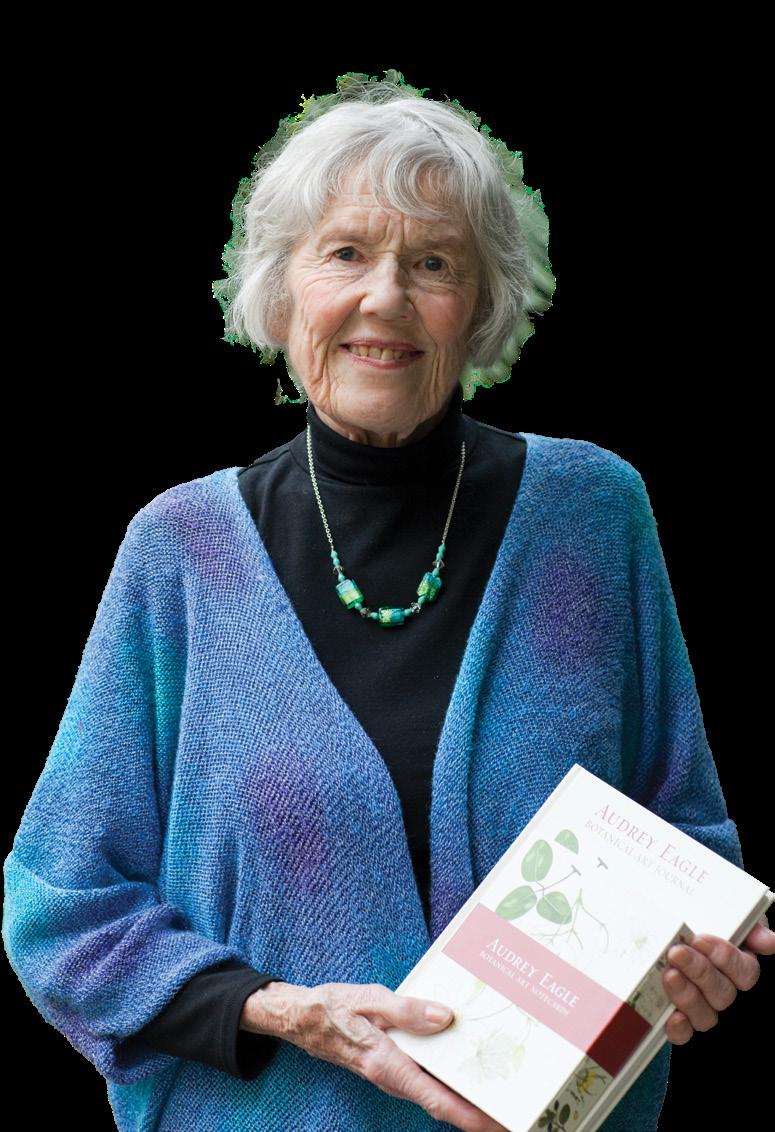
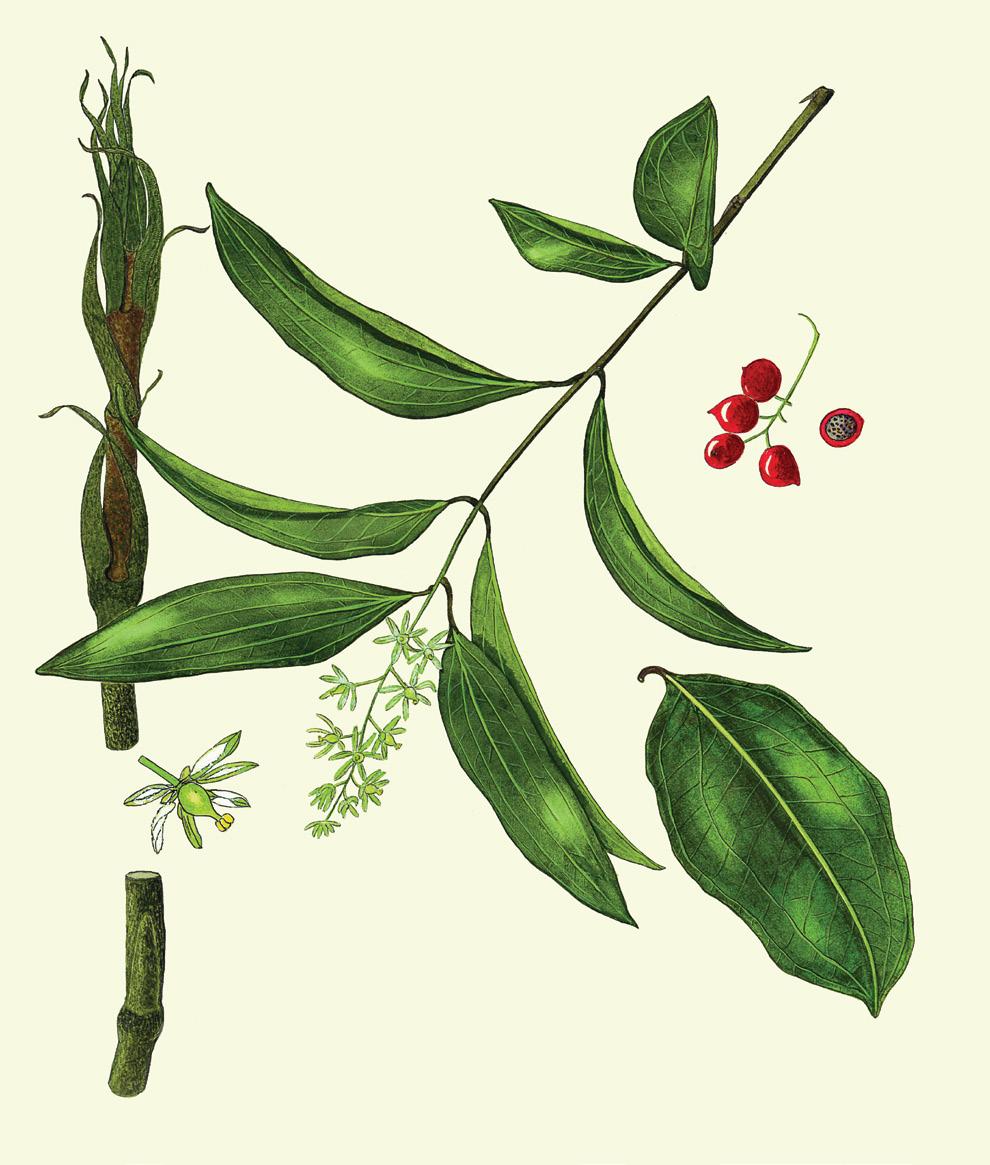
Botanical artist Audrey Eagle set out to paint every known tree and shrub in Aotearoa with such attention to detail that their identification would be made easier. She accomplished her life’s work with skill and distinction.

The illustrator and writer, who died last November aged 97, was dedicated to the preservation of New Zealand’s flora. She actively supported Forest & Bird, advocated for the establishment of bush reserves, and instilled in all those she met, including children, a love for nature.
Audrey Borley was born in Timaru in 1925. She moved with her family to England, where she was educated. She met and married Harold Eagle but told him that she had to return to New Zealand.
“There was something there I felt I had to do,” she later said.
The couple returned in 1949, and both started working at the Electricity Department, Hamilton, where she met district engineer Athol Caldwell, an enthusiastic botanist, who became her mentor.
Caldwell introduced Audrey to another keen botanist, Michael Gudex, and all three were instrumental in setting up the Waikato section of Forest & Bird in 1952. Two years later, it became a branch.
In 1952, Audrey began painting the native plants in Caldwell’s garden, known as “The Shrubbery”. After leaving her job to raise her family, she continued to paint native trees, shrubs, and plants in painstaking detail and beauty.
Her first book Eagle’s Trees and Shrubs of New Zealand was published in 1975 with 228 colour illustrations. The second volume was produced in 1982, with 405 illustrations. She went on to write and illustrate five more plant books.
In 1963, Audrey, together with Gudex and Caldwell, secured a significant donation of land that would become Forest & Bird’s Walter Scott Reserve, on the
Michael Pringle
slopes of Waikato’s Mt Pirongia. The Waikato Branch still looks after this reserve today.
She was an enthusiastic member of the Waikato Branch and led many day trips around the region for its members.
On one such outing – to Ngaruawahia in 1973 –schoolboy Kevin Callaghan made a surprise discovery. He found a very rare and unusual parasitic plant Themisia rodwayi, which Audrey excitedly reported on in one of her many branch reports in Forest & Bird magazine.
Audrey served on Waikato Branch’s committee for 23 years, including a stint as chairperson. She was often sent plants by fellow members, who also helped her find specimens on the field trips she led.
In 1985, she was awarded the Loder Cup for her extraordinary contribution to our understanding of native flora. In the same year, she became a Distinguished Life Member of Forest & Bird.
In 2006, Eagle’s Complete Trees and Shrubs of New Zealand
than 800 illustrations. It scooped a non-fiction award in the Montana Book Awards in 2007.
Audrey will forever be remembered for her ceaseless dedication to New Zealand’s native flora and the enthusiasm for nature that she imparted to so many.
Audrey Eagle, born Timaru
20 October 1925, died Mosgiel
27 November 2022.
| Forest & Bird Te Reo o te Taiao 68
Audrey Eagle in 2009. Michael Hall/Te Papa.
The Essential Audrey Eagle: Botanical Art of New Zealand, Te Papa Press.
OBITUARY
Kareao supplejack (Ripogonum scandens). Illustration by Audrey Eagle
BOOKS
In Pursuit of Champions
by Keith Woodley
This inspiring story is told by Keith Woodley, the manager of Pūkorokoro Miranda Shorebird Centre. Over the past 30 years, he has had a ringside seat for the unfolding story of bar-tailed godwits and their epic migrations. Their journeys and those of other species fostered his expert knowledge of the shorebird migration flyway and took Woodley all over the world – from South Island braided rivers in pursuit of wrybill and oystercatchers to the coasts of China, North and South Korea, and the tundra of Alaska. His work earned him a New Zealand Order of Merit for services to shorebird conservation in 2022. Woodley’s absorbing book, part memoir and part history, charts the life and times of a small voluntary organisation that punched above its weight. Recognising the importance of coastal conservation, a group of passionate people built something from nothing, creating a globally recognised hub for shorebird advocacy. (Published by Pūkorokoro Miranda Naturalists’ Trust in association with Sherlock & Co Publishing. $RRP $40.)
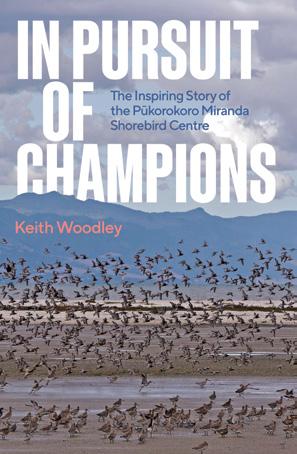
Fossil Treasures of Foulden Maar
 by Daphne Lee, Uwe Kaulfuss,
by Daphne Lee, Uwe Kaulfuss,
and John Conran
Foulden Maar, in Otago, is a paleontological site of international significance. The fossil treasures there were recently threatened by a proposal to mine the site’s rich diatomite deposits. Local and national scientific researchers rallied with others, including our Dunedin Branch, to call for the protection of this unique location, sparking an international debate about the importance of the preservation of paleontological sites worldwide. In this new book, writers Daphne Lee, Uwe Kaulfuss, and John Conran share their passion and knowledge for Foulden Maar, which is home to countless rare and well-preserved fossils. This beautifully illustrated book reveals the unique paleontological discoveries that have been made to date, giving a window on to the world of changing life and ecosystems at the beginning of the Miocene and paying tribute to the scientific researchers who have helped bring Foulden Maar’s scientific marvels to the surface. (Otago University Press. RRP $60.)
A Naturalist’s Guide to the Reptiles & Amphibians of New Zealand
 by Samuel Purdie
by Samuel Purdie
This comprehensive photographic identification guide to all 141 reptile and amphibian species of New Zealand is accompanied by highquality images by some of the country’s top nature photographers. Budding lizard lovers can read detailed species descriptions, which include nomenclature, size, distribution, habits and habitats, and conservation information. The user-friendly introduction covers geography and climate, habitats, reptile and amphibian identification, and a glossary. Also included is a checklist of all the herpetofauna of Aotearoa, including the current threat classification for each species. There has been a surge of research and conservation work focused on our amazing reptiles and amphibians. Many organisations, including Forest & Bird, are actively restoring habitats and conducting predator control to assist the native herpetofauna. (Published by John Beaufoy Publishing. RRP $29.99.)
Native Plants of Aotearoa

 by Carolos Lehnebach and Heidi Meudt
by Carolos Lehnebach and Heidi Meudt
Native Birds of Aotearoa
 by Michael Szabo
by Michael Szabo
This pair of small and delightful volumes provide handy introductions to our unique birdlife and flora. Native Plants of Aotearoa is a handsomely illustrated guide to 50 of our most interesting and commonly encountered species. Written by Te Papa botanists Dr Carlos Lehnebach and Dr Heidi Meudt, it includes descriptions on each species and insights into the museum’s fieldwork and collections. The illustrations are based on sketches by Sydney Parkinson, the artist on board HMS Endeavour during the 1768–71 expedition led by Captain James Cook. Native Birds of Aotearoa by former Forest & Bird magazine editor Michael Szabo is an equally accessible guide to native birds that concisely describes 60 of our most interesting species, including forest, garden, wetland, coastal, alpine, and marine birds. Published in collaboration with Birds New Zealand, it includes ornithological notes, as well as charming original illustrations from the 1930s complemented in the same style by illustrator Pippa Keel. (Published by Te Papa Press. RRP $27 each.)
69 Autumn 2023 | Autumn
READY FOR A FRESH START?
We are looking for someone with a similar ethos to take over our well established eco tour adventure business. Would suit someone with a love of nature, heritage and likes meeting people.

If this sounds like you or someone you know, apply to Will Parsons 0274 483 133
www.driftwoodecotours.co.nz
PHILPROOF PEST CONTROL PRODUCTS
WIPE OUT: Possums, Rodents, Mustelids,
Rabbits
Standard & Mini Possum Bait Stations & Timms Traps
■ Rodent Bait Stations and Block Baits
■ Rodent Snap Traps ■ Fenn Traps (MK4 & 6) ■ Trap Covers ■ DOC 200 trap and lightweight cover.
Also available: Monitoring Tunnels, Flagging Tape, Rabbit Bait Stations.
PHONE 07 859 2943
MOBILE 021 270 5896
PO Box 4385 Hamilton 3247
WEB: www.philproof.co.nz
EMAIL: philproof@gmail.com
FOREST & BIRD’S WILDLIFE LODGES
Arethusa Lodge
Near Pukenui, Northland
Sleeps 6
herbit@xtra.co.nz
03 219 1337

Ruapehu Lodge
Whakapapa Village, Tongariro National Park
Sleeps 32
office@forestandbird.org.nz
04 385 7374
Mangarākau Swamp Lodge
North-west Nelson
Sleeps 10
mangarakauswamp@gmail.com
03 524 8266
http://www.mangarakauswamp.com
• Heaphy Track
• Abel Tasman
• Old Ghost Road
• Cobb Valley
‘Carry less, enjoy more’
Come explore with us!
www.kahurangiwalks.co.nz
Phone: 03 3914120
Forest & Bird members can book all of these lodges at reasonable rates. Join today and feel good knowing you are making a difference for New Zealand’s nature. See www.forestandbird.org.nz/joinus

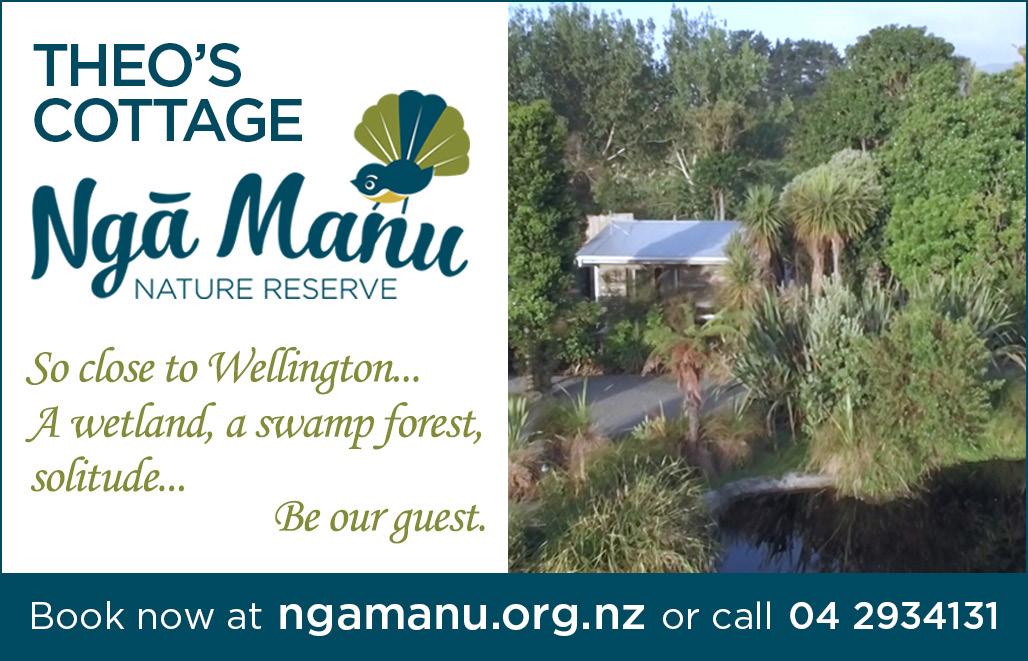
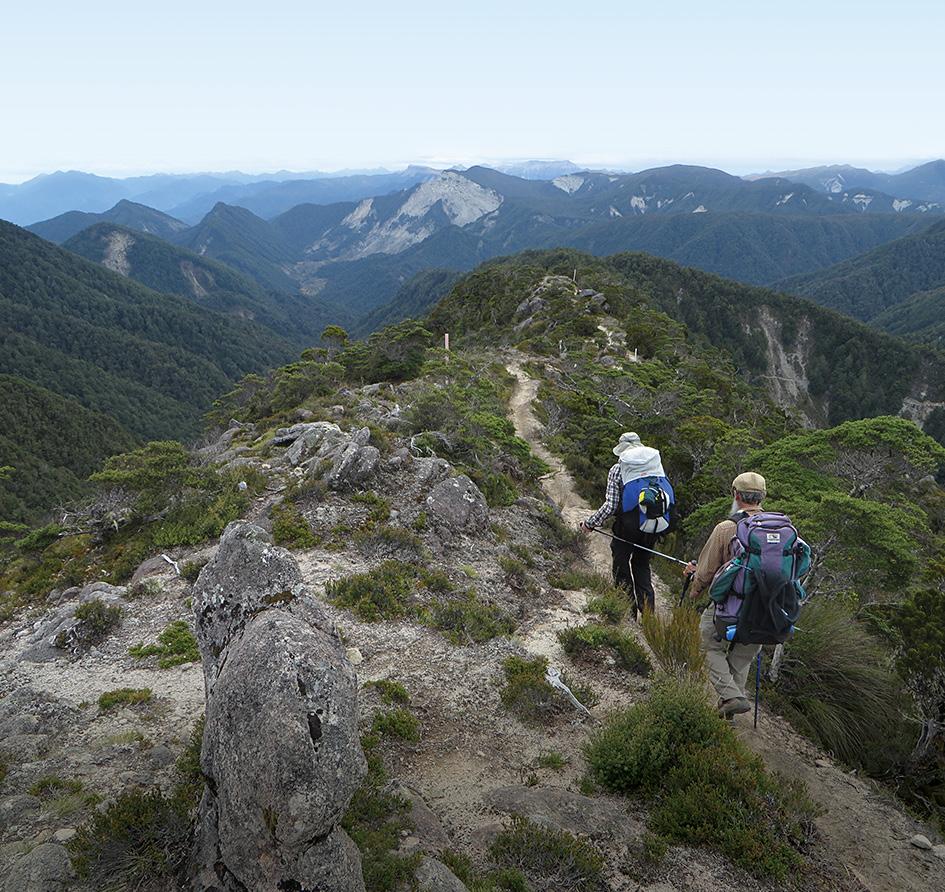
Tai Haruru Lodge
Piha, West Auckland
Sleeps 5+4
hop0018@slingshot.co.nz
09 812 8064
Tautuku Forest Cabins
Owaka, Otago
Sleeps 16
tautukucabins@gmail.com
0273764120
MARKET PLACE
70
| Forest & Bird Te Reo o te Taiao
Join our knowledgeable local guides on walking tours in the stunning Glacier Country region.

Learn about glaciology, flora & fauna, geomorphology, geology & history of this world renowned landscape. We cater for all ages & abilities, with 2 hr, half day & full day tours in our small groups, at your pace.
Explore with us at Okarito Boat EcoTours

and discover the magic of the superb birdlife and untouched serenity of New Zealand’s largest unmodified wetland, over 3000 hectares of lagoons and wildlife-rich waterways. 03-753 4223



New Zealand Birdsong Clock

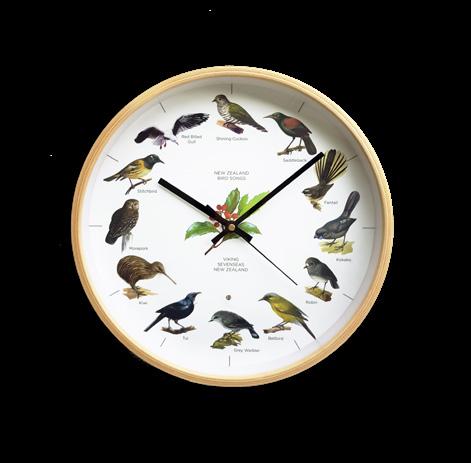
O’Connell St, Ak CBD
64 9 309 0600
The trust provides financial support for projects advancing the conservation and protection of New Zealand’s natural resources, particularly flora and fauna, marine life, geology, atmosphere, and waters.

More information is available from the Trust at
SHOP FOR NATURE
We have lots of beautiful New Zealandmade gifts in our online shop. Every sale raises funds for Forest & Bird’s conservation work. See https://shop.forestandbird.org.nz
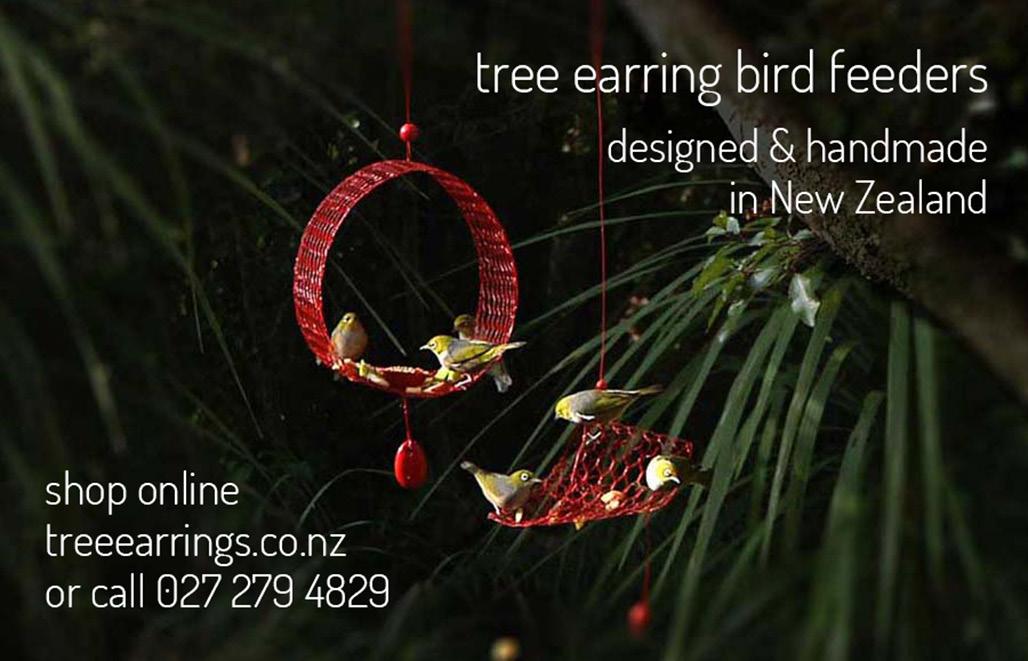



$149.95 ONLY
A different birdsong every hour vikingsevenseas.co.nz

new design

Please contact Karen Condon
0275 420 338
Advertise to Forest & Bird readers here
PHONE
EMAIL
and
80,000 people who are passionate about nature and the outdoors.
karen.condon@xtra.co.nz
reach
71 Autumn 2023 |
Ron and Edna Greenwood Environmental TRUST
0800 925 586 www.glaciervalley.co.nz
OkaritoBoatTours@gmail.com www.okaritoboattours.co.nz BIRDLIFE RANGE MADE IN NZ
19
strangelynormal.com
MENSWEAR
ph:
Stunning
RIGHT ROYAL RESCUE
A newly hatched kiwi chick was rescued by staff working for Operation Nest Egg after being abandoned in its nest.


Kiwi conservationists got more than they bargained for on a cold wet night when one of them reached into a nest and found a newly hatched chick instead of the expected egg.

The chick was cold, wet, and very still in the empty burrow. It was rushed to safety and transferred to the care unit at the National Kiwi Hatchery in Rotorua.
The chick was called Regal as it was rescued in the early hours of the public holiday in memory of Queen Elizabeth II last September.
There are no external features to determine whether kiwi chicks are male or female, so DNA feather testing is undertaken. As this can take some time, chicks are frequently given gender-neutral names.
Regal was discovered as part of the regular kiwi egg collecting work carried out each year on Forest Lifeforce Restoration Trust’s property, Maungataniwha Native
Forest, Hawke’s Bay.
Operation Nest Egg is a national programme where kiwi eggs are removed from their burrows and incubated, hatched, and reared in safety while they are most vulnerable.
When they are large enough to fend for themselves in the wild, the hatched chicks are then returned to where the eggs were lifted from.
The Trust’s resident “kiwi whisperer” Barry Crene said it was unusual for an egg to have hatched before a team arrived to recover it.
“Most of the birds we recover eggs from are fitted with transmitters, so we can tell when they’re not on their nests; that’s when we swoop in to collect their eggs,” he said.
“We retrieve eggs before they hatch so that predators don’t get a chance to nab the newly hatched chicks.”
The team took Regal straight back to camp, stoked up the fire, and put the chick in a container next to the hearth to dry out. “By morning, its feathers were nice and fluffy, and the chick was brighteyed and quite perky,” added Barry.
“When we got it to the National Kiwi Hatchery hospital, staff there put antiseptic cream on its navel
to prevent infection and put it in a special brooder under a heat plate. It weighed in at 250g.”
Regal was transferred to a kiwi creche, where it stayed until it was large enough to fend for itself in the wild.
At the time of writing, Regal was about to be released back into its forest home at Maungataniwha, where it will hopefully boost the local kiwi population.
LAST WORD
Regal was nursed back to health by Emma Bean.
The kiwi chick was discovered cold and wet in an empty burrow.
A warm Regal is a happy Regal.
| Forest & Bird Te Reo o te Taiao 72
The Forest Lifeforce Restoration Trust was established in 2006 to restore threatened flora and fauna within the central North Island. For more information, see www.forestlifeforce.org.nz/home
Parting shot
This image shows pied stilts in a distraction display from their nests at Awarua Bay, east of Bluff, Southland. Known as poaka to Māori, these dainty birds are masterful at distracting predators away from a nest or their young. They try to divert attention by flying away, yapping, or shamming injury to a wing or leg in a very realistic manner. This self-introduced wading species arrived in the early 19th century from Australia and went on to flourish. It is found in wetlands and along coastal areas throughout Aotearoa New Zealand and may be seen feeding among oystercatchers. They are not considered threatened, in contrast to the critically endangered kakī black stilt.

WILD ABOUT NATURE | PHOTO COMPETITION
How to enter: Share your images of native birds, trees, flowers, insects, lizards, marine animals, or natural landscapes, and be in to win.
Send your high-res digital file and brief details about your photo to Caroline Wood at editor@forestandbird. org.nz. The best entry will be published in the next issue of Forest & Bird magazine.
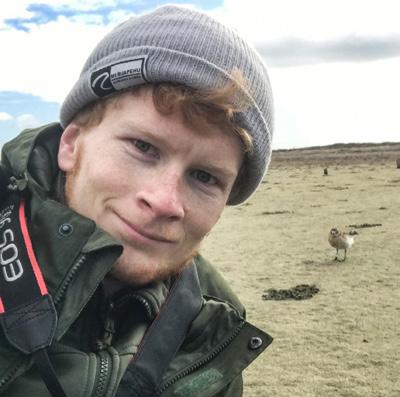
The prize: The next winner will receive this limited edition Hannah Shand fine art print Kōkako and Kohekohe (A3, RRP $220). Hannah’s artwork features a North Island kōkako, fondly known for its incredibly haunting song that echoes through the forest at dawn. Each of Hannah’s meticulous pen-and-ink artworks takes four to 16 weeks to create. For this artwork, Hannah photographed Kahurangi, a special female kōkako that lives at Pūkaha National Wildlife Centre. The Pūkaha team has been doing incredible work helping save the species.
Kōkako and Kohekohe by Hannah Shand. For more of Hannah’s artworks, see www.hannahshandart.com.
 Oscar Thomas
Oscar Thomas
For over thirty years Bivouac Outdoor has been proudly 100% New Zealand owned and committed to providing you with the best outdoor clothing and equipment available in the world. It is the same gear we literally stake our lives on, because we are committed to adventure and we ARE climbing.

we ARE climbing
John Palmer at Sunnyside, Wanaka
www.bivouac.co.nz STORES NATIONWIDE
Photo: Tom Hoyle
Supporting Aotearoa's Backcountry Heritage

















































 Le Poulet (the hen) rock formation near Hienghene. New Caledonia Tourism
Le Poulet (the hen) rock formation near Hienghene. New Caledonia Tourism


















 Brian Bell in 2012.
Brian Bell in 2012.




























 Murray and Penny Willocks. Supplied
Murray and Penny Willocks. Supplied







 Val Sanderson, 1922
Val Sanderson, 1922








 “The light he abhors but rarely meets” Anti-poaching cartoon commissioned by Forest & Bird, published May 1938. Marmaduke Matthews
“The light he abhors but rarely meets” Anti-poaching cartoon commissioned by Forest & Bird, published May 1938. Marmaduke Matthews

























 This purple southern New Zealand sponge (Callyspongia stellata) has distinctive colouration, due to the presence of carotenoid pigments in the sponge cells.
This purple southern New Zealand sponge (Callyspongia stellata) has distinctive colouration, due to the presence of carotenoid pigments in the sponge cells.











































 Wairau Lagoons, Marlborough. Ricky Wilson/Flickr
Wairau Lagoons, Marlborough. Ricky Wilson/Flickr








 The introduced Gisborne cockroach Drymaplaneta semivitta is harmless and prefers to live outside. Bryce McQuillan
The black cockroach is a New Zealand native that lives outside in leaf litter and rotten logs. Bryce McQuillan
The introduced American cockroach. Alex Wild
The introduced Gisborne cockroach Drymaplaneta semivitta is harmless and prefers to live outside. Bryce McQuillan
The black cockroach is a New Zealand native that lives outside in leaf litter and rotten logs. Bryce McQuillan
The introduced American cockroach. Alex Wild


 Sea lion with motorbike on Jack’s Bay, near Hinahina, in the Catlins.
Sian Mair
Sea lion with motorbike on Jack’s Bay, near Hinahina, in the Catlins.
Sian Mair



 Forest & Bird has been campaigning to protect pakake in the Sub-Antarctic Islands and on New Zealand’s mainland since the early 1980s.
Forest & Bird has been campaigning to protect pakake in the Sub-Antarctic Islands and on New Zealand’s mainland since the early 1980s.

















 Fig 1: A smaller (yellow) species of bird forages across the whole tree.
Fig 2: A larger (red) species competes for resources.
Fig 3: Red dominates in the middle for the more abundant resources. Yellow adapts to a new niche restricted to the top and bottom and avoiding competition.
Fig 1: A smaller (yellow) species of bird forages across the whole tree.
Fig 2: A larger (red) species competes for resources.
Fig 3: Red dominates in the middle for the more abundant resources. Yellow adapts to a new niche restricted to the top and bottom and avoiding competition.



 Kids learning about ecology. shutterstock
Kids learning about ecology. shutterstock


















 by Daphne Lee, Uwe Kaulfuss,
by Daphne Lee, Uwe Kaulfuss,
 by Samuel Purdie
by Samuel Purdie

 by Carolos Lehnebach and Heidi Meudt
by Carolos Lehnebach and Heidi Meudt
 by Michael Szabo
by Michael Szabo
























 Oscar Thomas
Oscar Thomas
